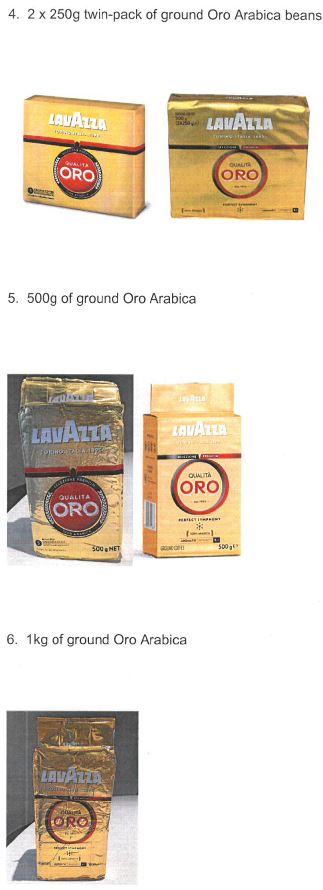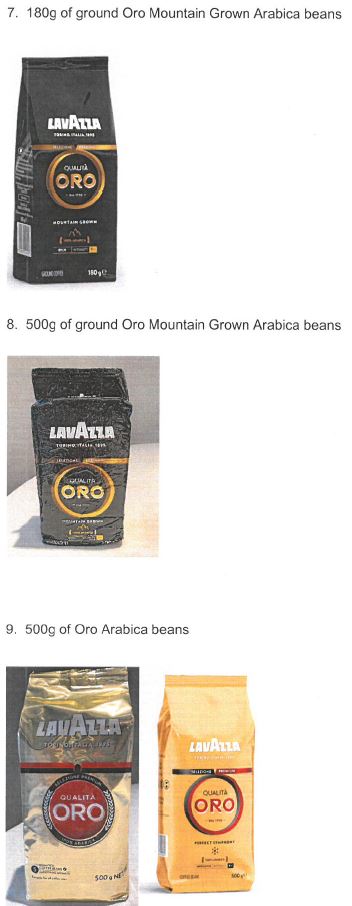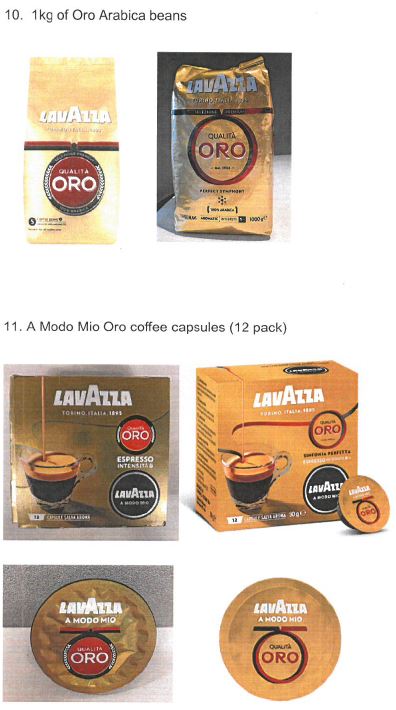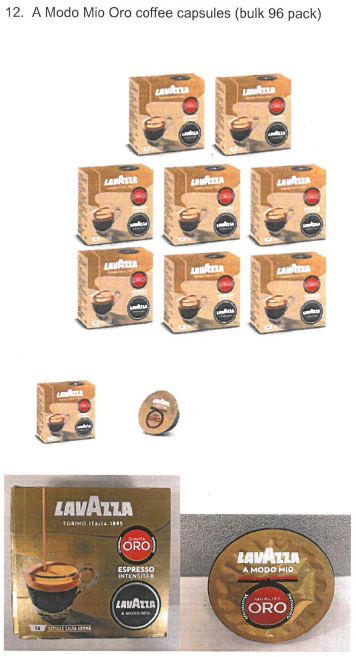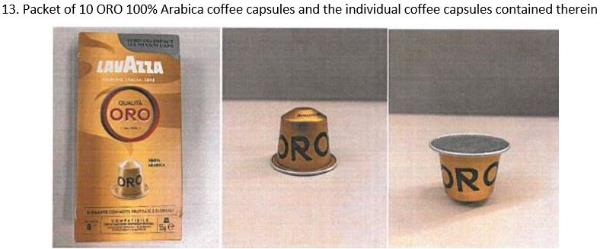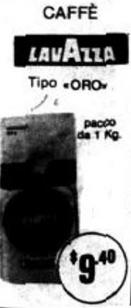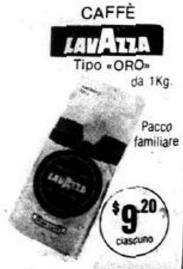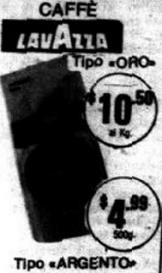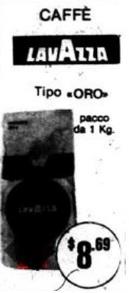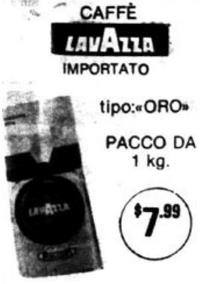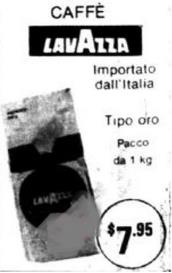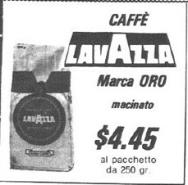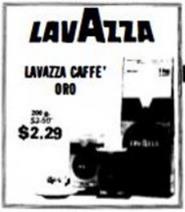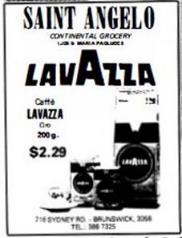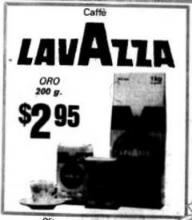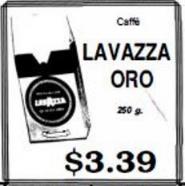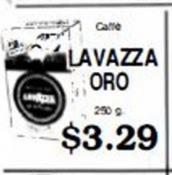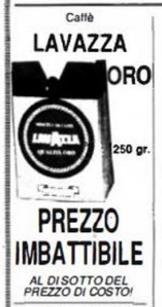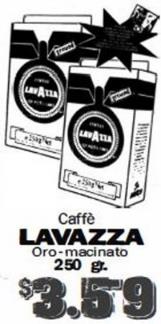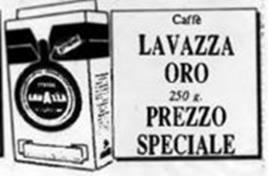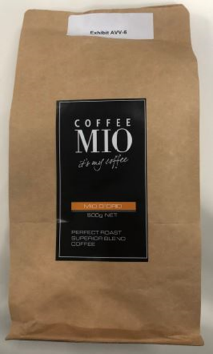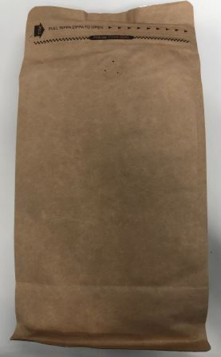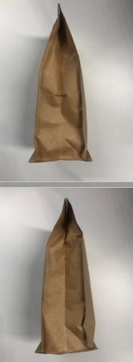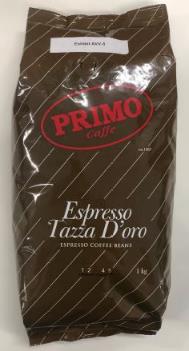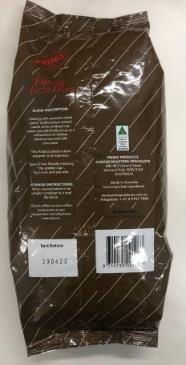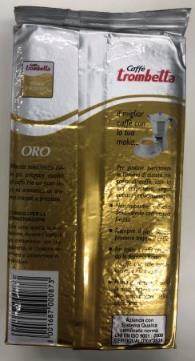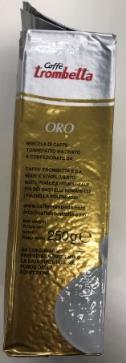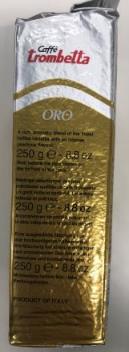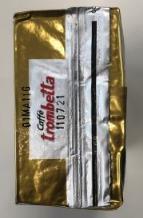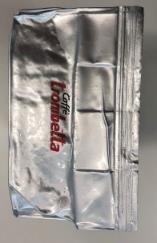Federal Court of Australia
Cantarella Bros Pty Ltd v Lavazza Australia Pty Ltd (No 3) [2023] FCA 1258
ORDERS
CANTARELLA BROS PTY LTD (ACN 000 095 607) Applicant | ||
AND: | LAVAZZA AUSTRALIA PTY LTD (ACN 605 275 107) First Respondent LAVAZZA AUSTRALIA OCS PTY LTD ACN 626 604 555 Second Respondent | |
DATE OF ORDER: |
THE COURT ORDERS THAT:
1. By 30 November 2023, the parties bring in orders giving effect to these reasons.
Note: Entry of orders is dealt with in Rule 39.32 of the Federal Court Rules 2011.
[1] | |
[6] | |
[35] | |
[117] | |
[209] | |
[212] | |
[220] | |
[223] | |
[262] | |
[264] | |
[332] | |
[332] | |
[338] | |
[351] | |
[368] | |
[375] | |
[383] | |
[392] | |
[392] | |
[403] | |
[417] | |
[434] | |
[455] | |
[469] | |
[486] | |
[486] | |
[502] | |
[538] | |
[549] | |
[552] | |
[594] | |
[602] | |
[602] | |
[603] | |
[611] | |
[619] | |
[629] | |
[655] | |
YATES J:
1 The applicant, Cantarella Bros Pty Ltd (Cantarella), sues the respondents, Lavazza Australia Pty Ltd (Lavazza Australia) and Lavazza Australia OCS Pty Ltd (Lavazza OCS), for infringement of two registered trade marks—Trade Mark No. 829098 (the 098 mark) and Trade Mark No. 1583290 (the 290 mark)—each of which is the word mark ORO registered in class 30 for “Coffee; beverages made with a base of coffee, espresso; ready-to-drink coffee; coffee based beverages” (the ORO word mark). For ease of reference, I will refer to these goods as coffee or the registered goods. I will also refer to, and treat, the respondents as a single entity—Lavazza—unless it is necessary to distinguish between them.
2 Cantarella’s case is based on s 120(1) of the Trade Marks Act 1995 (Cth) (the Act). The goods, and the manner in which Lavazza has used the word “oro” on them, are shown in Schedule 1 to these reasons. Cantarella alleges that Lavazza Australia has supplied all the goods. It alleges that Lavazza OCS has supplied the goods shown as items 11 and 12 (coffee capsules). Cantarella also alleges that Lavazza has advertised the goods on websites.
3 Lavazza does not dispute that the goods shown in Schedule 1 have been supplied and advertised. Lavazza does dispute, however, that the 098 mark and the 290 mark have been infringed. Lavazza contends that, in undertaking these activities, the word “oro” has not been used as a trade mark. Lavazza also contends that, even if, in undertaking these activities, the word “oro” has been used as a trade mark, various defences to infringement exist, and have been established, in the particular circumstances of this case.
4 More fundamentally, Lavazza disputes that the two marks are validly registered. By a notice of cross-claim, now supported by a further amended statement of cross-claim, Lavazza seeks orders that the registrations of the two marks be cancelled for two independent reasons: first, each mark is not inherently adapted to distinguish Cantarella’s goods from the goods of other persons and, therefore, does not meet the requirements of s 41 of the Act as in force at the relevant time; and secondly, Cantarella is not, in any event, the owner in Australia of the ORO word mark in respect of coffee.
5 For the reasons that follow, I am satisfied that Lavazza’s supply of LAVAZZA QUALITÀ ORO coffee has involved use of the ORO word mark. However, Cantarella’s case on infringement cannot succeed because the registrations of the 098 mark and the 290 mark on which it relies are not valid. Given that conclusion, it has not been necessary for me to determine the defences that have been raised. I have, nonetheless, made a number of observations about the applicability of those defences.
6 At the outset, it is necessary for me to say something about the conduct of this case. Some of the history of the proceeding has been recorded in another published judgment of the Court: Cantarella Bros Pty Ltd v Lavazza Australia Pty Ltd (No 2) [2021] FCA 894 (Cantarella (No 2)). It is appropriate, however, that some of the matters referred to in that judgment be repeated in the following overview.
7 The proceeding was commenced on 23 August 2019 by the filing of an originating application and statement of claim. Lavazza filed its cross-claim on 11 October 2019 and its defence to the statement of claim on 14 October 2023.
8 On 11 December 2019, orders were made by consent setting down the proceeding for final hearing commencing on 7 December 2020, with an estimated duration of four days (to 10 December 2020). On 2 November 2020, an order was made that the hearing be extended by an additional day to 11 December 2020.
9 Early in the case management of the proceeding, a regime was put in place for the notification, and possible resolution, prior to the commencement of the hearing, of objections to evidence. An order was made on 2 November 2020 that the proceeding be listed on 1 December 2020 to determine any outstanding objections. That hearing took place, as appointed. A number of rulings were made. The determination of some objections was deferred on the basis that those objections might be overcome by further consultation between the parties’ legal advisers, or by the service of supplementary affidavits.
10 The hearing commenced on 7 December 2020. On 11 December 2020, the last day appointed for the hearing, a number of objections to affidavits (which Cantarella had progressively filed throughout the course of the hearing to overcome other objections to evidence that had been made) were still being argued. I was persuaded that rulings on those objections would best be made in the context of a voir dire. The hearing was therefore adjourned part heard.
11 On 15 January 2021, the proceeding was listed for further hearing on 8, 15 and 16 June 2021, with the final two days set aside for the parties’ closing submissions. A period of much earlier dates in March – April 2021 was offered to the parties, but the Court was informed that there were difficulties with the availability of counsel in that period.
12 On 19 May 2021, in the intervening period, Lavazza served copies of the affidavits of two employees of Caffè Molinari SpA (Molinari). The service of these affidavits (the Molinari affidavits) had not been foreshadowed. At the same time, Lavazza indicated that it also wished to make amendments to its defence and cross-claim. On 21 May 2021, Cantarella, through its solicitors, informed Lavazza’s solicitors that it opposed those amendments and also Lavazza’s reliance on the new affidavits.
13 On 1 June 2021, the proceeding was relisted at Lavazza’s request. On that day, I granted leave to Lavazza to file an interlocutory application (dated 21 May 2021) seeking leave to adduce and rely on the Molinari affidavits, and an affidavit by Mr Lee, a partner in the firm acting for Lavazza in this proceeding. The interlocutory application also sought leave to make the pleading amendments that Lavazza wished to make. I made other procedural directions at that time and set down the interlocutory application for hearing on 8 June 2021, the date to which the hearing had already been adjourned for the hearing of the voir dire and the possible cross-examination of the deponent whose affidavits were still under challenge.
14 At the resumed hearing on 8 June 2021, the outstanding objections to the affidavits on which Cantarella wished to rely were resolved by agreed rulings. The need for the voir dire, and subsequent cross-examination of the deponent involved, was thereby obviated.
15 Lavazza’s interlocutory application was heard on 8 June 2021. It was strenuously opposed. Nevertheless, at the conclusion of the hearing, I granted leave to Lavazza, on terms, to rely on the Molinari affidavits. I also granted leave to Lavazza to amend the pleading of its defence and cross-claim. This led to the vacation of the hearing dates appointed for 15 and 16 June 2021 because I acceded to the proposition that Cantarella should have the opportunity to respond to those affidavits.
16 Cantarella filed a further amended defence to Lavazza’s further amended cross-claim dated 10 June 2021. The further amended defence raised a substantial number of additional grounds on which Cantarella resisted Lavazza’s claim for cancellation of the registrations of the 098 mark and the 290 mark.
17 On 21 July 2021, Cantarella sought to revisit the grant of leave I made on 8 June 2021 to allow Lavazza to adduce and rely on the Molinari affidavits, by having further conditions imposed on the grant of leave that had been made. That application was refused: Cantarella (No 2).
18 On 4 August 2021, orders were made by consent setting down the resumed hearing for four days (and, if the court permitted, to continue on a fifth day) commencing on 6 December 2021.
19 The resumed hearing commenced on 6 December 2021 and concluded on 8 December 2021, at which time judgment was (initially) reserved.
20 By the conclusion of the two hearings, the Court had been provided with a large number of written submissions, which were of considerable length. When those submissions were reviewed in the non-sitting period in January 2022, following closing addresses in December 2021, it became clear that the sequence of the submissions was difficult to follow. The problem was exacerbated by the fact that the parties had used non-standardised terms in their cross-references to each other’s submissions.
21 I therefore listed the proceeding for a case management hearing on 14 February 2022 to discuss my concerns. The parties accepted that revision of the written submissions was required. They advanced a proposal whereby they would adopt uniform abbreviations for the various submissions; that the submissions be presented as a bundle in a given order with certain formatting; and that the submissions be updated with standardised cross-references to each other’s submissions and, where necessary, new transcript references.
22 Revised written submissions, which alleviated some of the problems involved with the sequence of the submissions, were prepared and provided to the Court in electronic form on 24 March 2022. At that time, I was informed that the parties’ written submissions were constituted by the following documents:
(a) Cantarella’s Opening Submissions on Infringement (16 November 2020);
(b) Cantarella’s Opening Submissions on the Cross-Claim (Validity) (30 November 2020);
(c) Cantarella’s Closing Submissions on Infringement (1 November 2021);
(d) Cantarella’s Closing Submissions on the Cross-Claim (Validity) (1 November 2021);
(e) Lavazza’s Closing Submissions on Infringement and on the Cross-Claim (Validity) (1 November 2021);
(f) Cantarella’s Closing Submissions in Answer on Infringement and on the Cross Clam (Validity) (12 November 2021);
(g) Lavazza’s Closing Submissions in Answer on Infringement and on the Cross-Claim (Validity) (15 November 2021);
(h) Lavazza’s Closing Submissions on the Molinari Issue (8 December 2021) (replacing submissions dated 22 November 2021);
(i) Cantarella’s Opening Submissions on the Molinari Issue (20 December 2021) (originally filed on 30 November 2021, but amended with cross-references to the submissions referred to at (h)); and
(j) Cantarella’s Closing Submissions on the Molinari Issue (20 December 2021) (originally filed on 8 December 2021, but containing a correction made orally by Senior Counsel).
23 On 27 April 2022, Cantarella filed an interlocutory application (dated 22 April 2022) seeking leave to further amend its statement of claim and to re-open its case to allege further infringements by Lavazza of the 098 mark and the 290 mark by the importation and supply of Lavazza coffee capsules in packaging which had not previously been raised in the proceeding. It appears that capsules in this packaging were put on supermarket shelves in Australia from 4 April 2022.
24 Despite Lavazza’s opposition, I was persuaded that leave should be granted to Cantarella to re-open its case on the basis that a determination of the issues raised by the new infringements might well influence the determination of some of the issues already before the Court.
25 On 15 June 2022, I made a number of timetabling orders for the filing of further amended pleadings, further affidavit evidence, and further written submissions. I then listed the proceeding for a case management hearing on 7 September 2022 in the expectation that, at that time, a further hearing date would be appointed.
26 The following further written submissions were filed in respect of the alleged new infringements:
(a) Cantarella’s submissions in chief dated 19 August 2022;
(b) Lavazza’s submissions in answer dated 26 August 2022; and
(c) Cantarella’s submissions in reply dated 2 September 2022.
27 On 5 September 2022, the Court was informed that the parties did not wish to be heard further. Judgment was then reserved from that date.
28 The hearing of the proceeding has been protracted because of the various twists and turns to which I have referred. At the time the hearing was adjourned part heard on 11 December 2020, these twists and turns were not, and could not have been, foreseen. Indeed, at the time of closing addresses on 8 December 2021, the events occurring after that date were not, and could not have been, foreseen.
29 By the time the Court was informed on 5 September 2022 that the parties did not wish to be heard further, other allocated hearings in my docket had, inevitably, intervened, with the consequence that the opportunity for full and complete deliberation of the issues raised in this proceeding has been delayed.
30 The parties have been granted leave to amend their pleadings numerous times. The final pleadings comprise:
(a) Cantarella’s second further amended statement of claim dated 30 May 2022;
(b) Lavazza’s third further amended defence dated 27 June 2022;
(c) Cantarella’s third further amended reply dated 11 July 2022;
(d) Lavazza’s further amended statement of cross-claim dated 10 June 2021;
(e) Cantarella’s further amended defence to cross-claim dated 9 July 2021; and
(f) Lavazza’s reply to further amended defence to cross-claim dated 23 July 2021.
31 A prodigious amount of evidence has been adduced, including through the tender of a large number of documents and a large number of physical exhibits. The documentary tenders are to be found largely, but not exclusively, in two electronic court books. The first court book (comprising 6904 pages) was prepared for the hearing in December 2020. The second court book (comprising 1319 pages) was prepared for the hearing in December 2021. Further evidence was adduced in respect of the alleged new infringements in 2022.
32 As I have noted, objections to evidence were dealt with prior to the commencement of the hearing on 7 December 2020. A number of remaining objections, and a number of new objections to evidence, either fell away during the course of the hearings in December 2020 and in December 2021 or were accommodated by agreed rulings. The affidavits read at those hearings, and the rulings made in respect of those affidavits, have been recorded in a document marked as Joint Exhibit 1. The documents tendered at those hearings (other than documents referred to as exhibits in affidavits which were taken to have been admitted into evidence) have been recorded in a document marked as Joint Exhibit 2.
33 My consideration of this matter has been considerably assisted by the written submissions which I have listed (in total, 498 pages). My consideration has also been assisted by recourse to a full transcript of the proceeding and the extensive notes I made during the course of the hearing.
34 A great many issues were raised and canvassed by the parties. Given the conclusions I have reached, it has not been necessary for me to decide all the issues that were raised.
The Lavazza business in Australia
35 Lavazza Australia is a wholly-owned subsidiary of Luigi Lavazza SpA (LL SpA). Lavazza OCS is a wholly-owned subsidiary of Lavazza Australia.
36 Since 2015, Lavazza Australia has distributed Lavazza products in Australia. Lavazza OCS was established in 2018 to acquire The Blue Pod Coffee Co Pty Ltd which, in the period 2008 to 2018, was the exclusive distributor of Lavazza products in Australia in the Office Coffee Service (OCS) sector.
37 These are relatively recent events. The evidence shows, however, that Lavazza products have been supplied in Australia over a much longer period of time. The history of that activity is relevant to a number of issues in this proceeding.
38 LL SpA was incorporated in Italy as a joint-stock company in 1927. However, the Lavazza business had its beginnings in 1895 when Luigi Lavazza founded a business selling a variety of goods, including soap, spirits, oil, candles, spices, and coffee.
39 LL SpA has its headquarters in Turin. The company has operated as a family business, with generations of the family holding key positions in the management of the company.
40 Following the Second World War, the company’s focus became the production and supply of coffee and related accessories. The business is operated under three principal divisions: Home, Food Service, and OCS.
41 In 1956, LL SpA developed a blend of coffee which it sold under the name TAZZA ORO LAVAZZA. In 1962, the name was changed to MISCELA LAVAZZA ORO. In about 1971, the name was changed again to LAVAZZA QUALITÀ ORO. The product is a premium full-bodied blend of Arabica beans sourced mainly from Central and South America and processed in Turin. The blend is described in the evidence as having a golden crema, a warm colour, and an aroma of fruit and flowers.
42 The graphics and logo for the product were developed in Italy in the 1960s. From at least the 1970s, the product has been packaged and sold in gold-coloured tins and vacuum-packed aluminium foil packets.
43 Early versions of the packaging included, on the front panel, a medallion which was registered as a trade mark in various jurisdictions. In Australia, the mark is Trade Mark No. 340868, which has been registered since 4 December 1979 in Class 30 for “Coffee and all other goods in this class”:

(the Lavazza device mark).
44 The registration in Australia was (and is) subject to an endorsement:
Registration of this trade mark shall give no right to the exclusive use of the Italian words ‘QUALITÀ ORO’, which may be translated into English as ‘GOLD QUALITY’.
45 The packaging—referred to in the evidence as the Classic Packaging—is shown below.

46 It will be observed that the medallion device shown on the Classic Packaging is different to the Lavazza device mark in that the words QUALITÀ ORO appearing under the name LAVAZZA within the medallion are disposed over two lines, rather than one line. Also, the Lavazza device mark is not limited to any particular colour or colours. However, LL SpA has traditionally used red and black colours for the medallion and the ribbons at the top of the medallion. I will refer to the medallion and ribbons as shown on the Classic Packaging as the Classic medallion.
47 LL SpA first exported Lavazza coffee in around 1972. Lavazza products entered the Australian market as a result of a strong relationship between the Lavazza family and the Valmorbida family who, since the 1960s, have owned and operated a wholesale food and wine business generally known as Conga. There are various companies involved in conducting this enterprise. One of these is Valcorp Fine Foods Pty Ltd (Valcorp). Another is Conga Amalgamated Pty Ltd (Conga Amalgamated).
48 Conga commenced importing and distributing Lavazza coffee in about 1974. Initially, there was no written distribution agreement between LL SpA and Conga. The Lavazza products were produced and packaged in Italy under LL SpA’s management. Conga worked with LL SpA on the marketing and promotion of those products in Australia, but LL SpA had final approval over all marketing and communications concerning the products. LL SpA also contributed to the funding of some marketing initiatives which Conga undertook. The range of Lavazza products distributed by Conga included LAVAZZA QUALITÀ ORO.
49 John Valmorbida is a director of Valcorp. His evidence was that, from the beginning, LAVAZZA QUALITÀ ORO was “very much the ‘headline act’” within the range of Lavazza products that Conga imported and distributed. He said that, in terms of volume, LAVAZZA QUALITÀ ORO was “by far the leading blend” within the Lavazza range that Conga imported and sold.
50 Conga sold LAVAZZA QUALITÀ ORO in the Classic Packaging. The evidence establishes that, in the period 1987 to 1989, Conga sold 38,758 cartons of LAVAZZA QUALITÀ ORO in Australia.
51 The evidence contains examples of the advertising and promotional activities undertaken in respect of the Lavazza products. In its closing submissions, Lavazza focused on particular newspaper advertising in La Fiamma newspaper (in New South Wales) and in Il Globo newspaper (in Victoria) for LAVAZZA QUALITÀ ORO. Over the years, the Valmorbida family has had an association with both newspapers, which service the Italian community. Lavazza drew attention to the appearance of the word “oro” in these advertisements. Many of the advertisements in evidence are display advertisements that were placed by independent retailers, not by Conga. Mr Valmorbida’s evidence is that Conga supplied images (provided by LL SpA) of Lavazza products for use by its retail customers to enable them to conduct Lavazza promotions.
52 In the account that follows, I have reproduced the display advertisements because they provide context in which the Lavazza products were promoted. It will be appreciated that these advertisements were but a part of the promotion that was undertaken.
53 On 26 March 1981, the following display advertisement appeared in the La Fiamma newspaper:

54 The relevant part of the advertisement for the present case is:

55 In the period 30 March 1981 to 22 June 1981, the following six display advertisements appeared in La Fiamma:




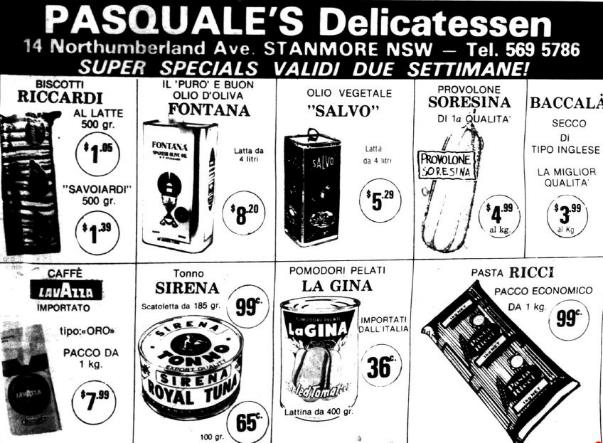
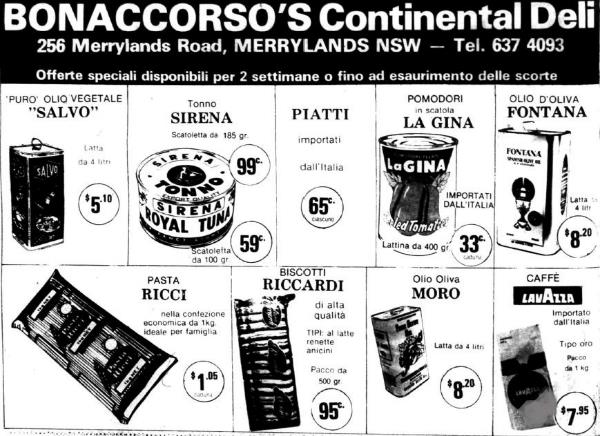
56 The relevant parts of the advertisements for the present case are:
|
|
|
|
|
|
57 On 4 June 1981, the following display advertisement appeared in La Fiamma:
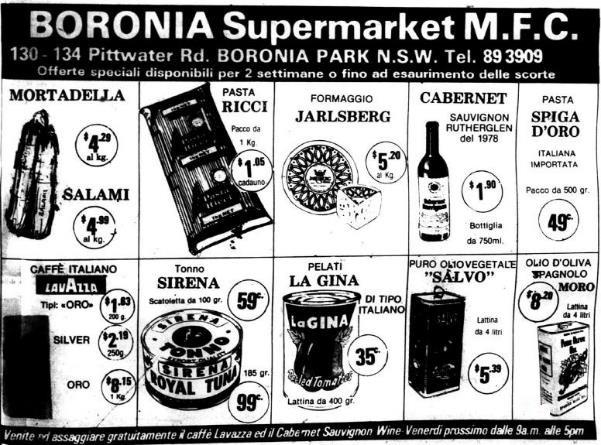
58 The relevant part of the advertisement for the present case is:

59 In the period 26 August 1982 to 16 May 1988, the following display advertisements appeared in La Fiamma.
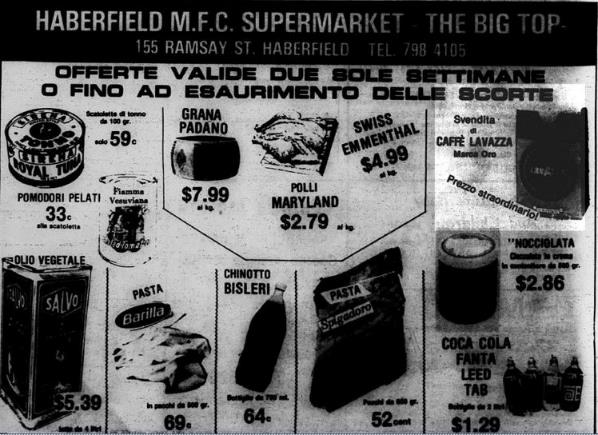
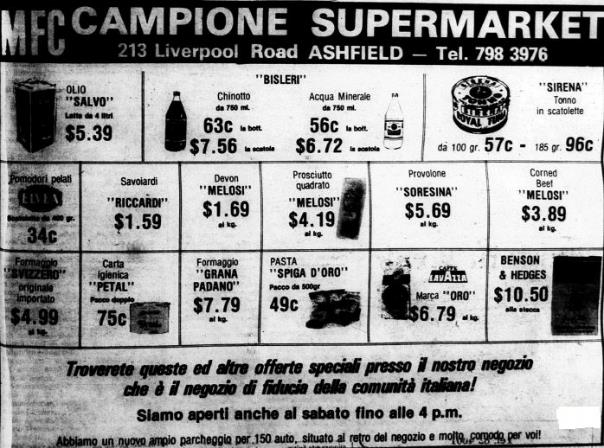
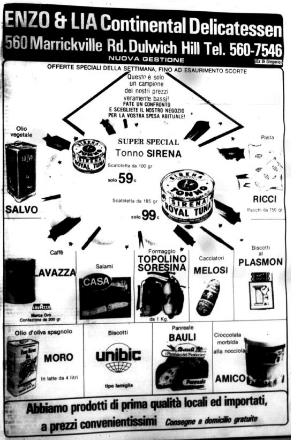
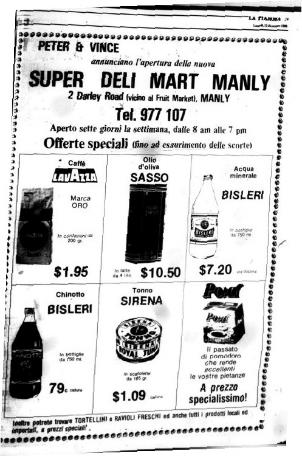
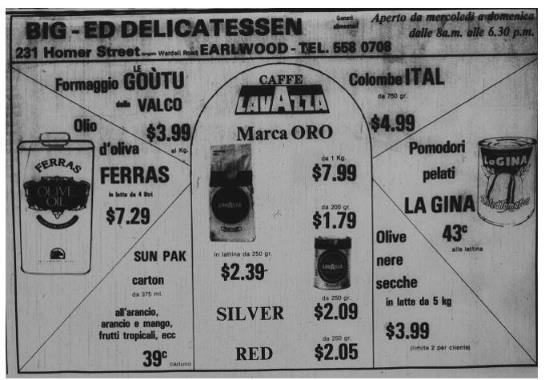
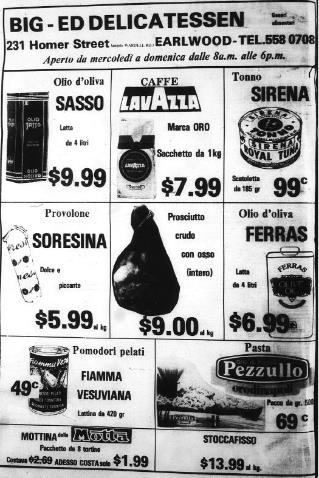
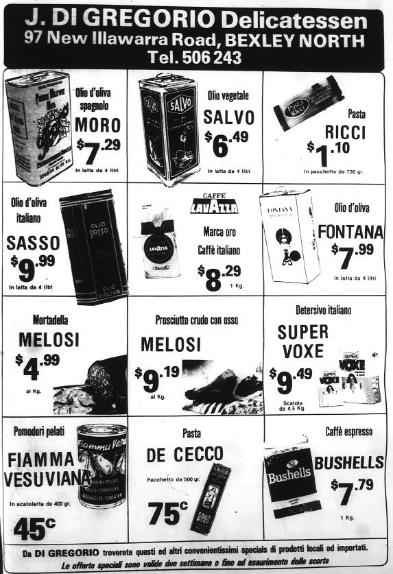
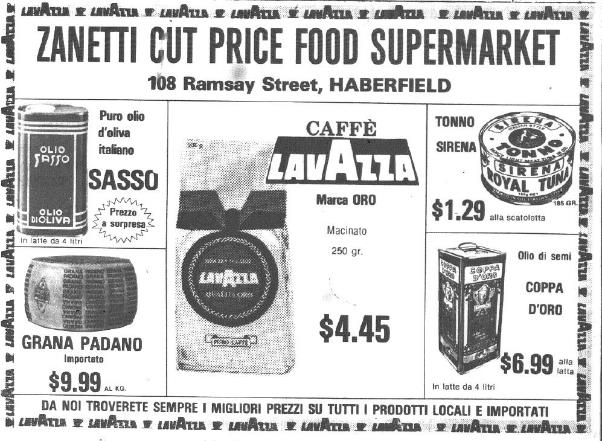
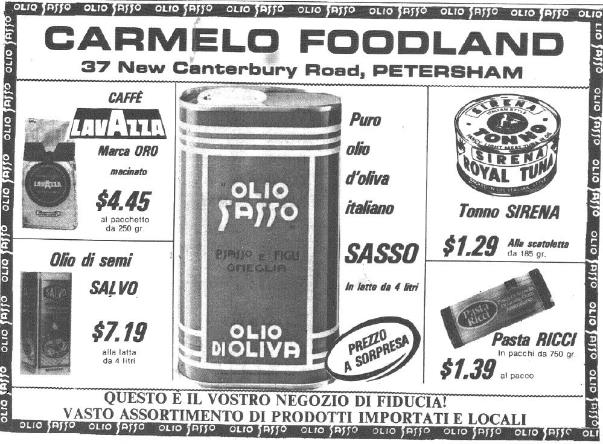
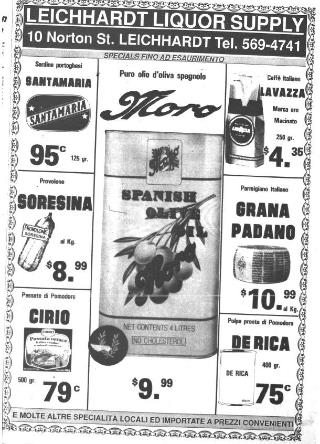
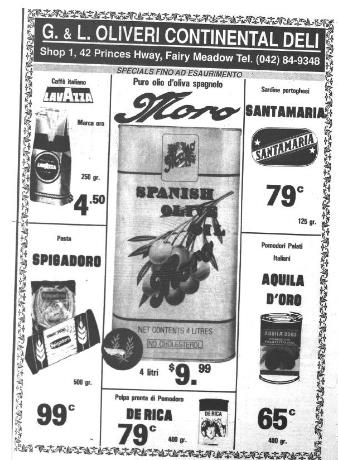
60 The relevant parts of the advertisements for the present case are:
|
|
|
|
|
|
|
|
|
|
|
61 In the period 25 November 1982 to 6 December 1984, Conga placed a banner advertisement in La Fiamma for Lavazza coffee as part of a television guide, on 23 occasions. The following is an example:
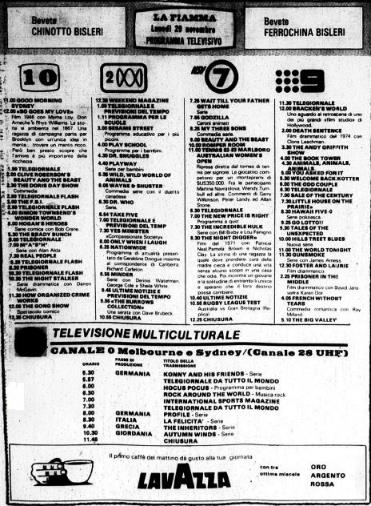
62 In the period 19 August 1985 to 18 February 2002, the following display advertisements appeared in Il Globo newspaper:

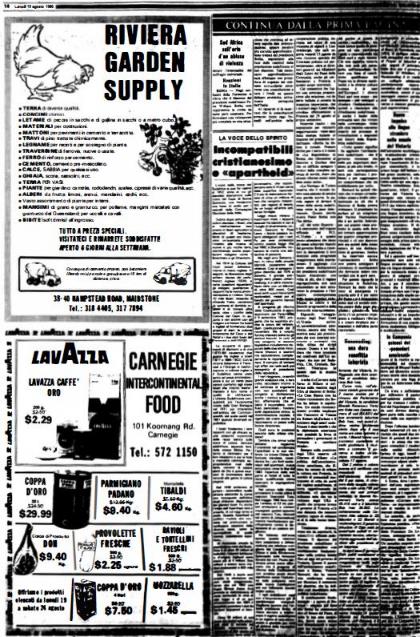

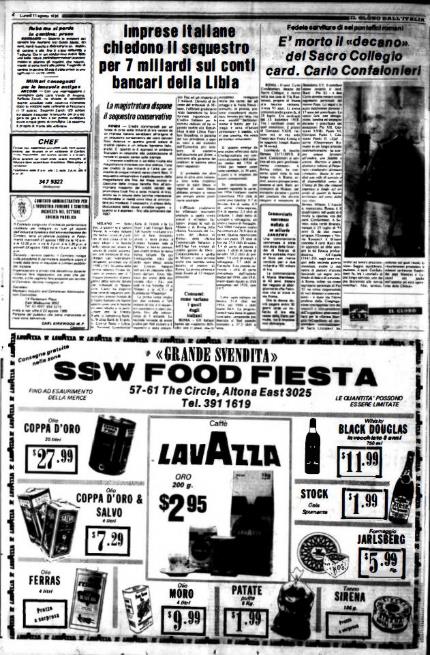


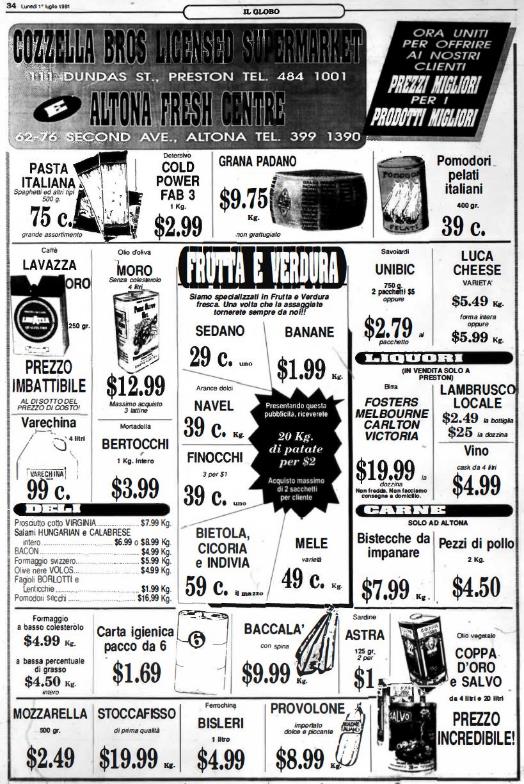
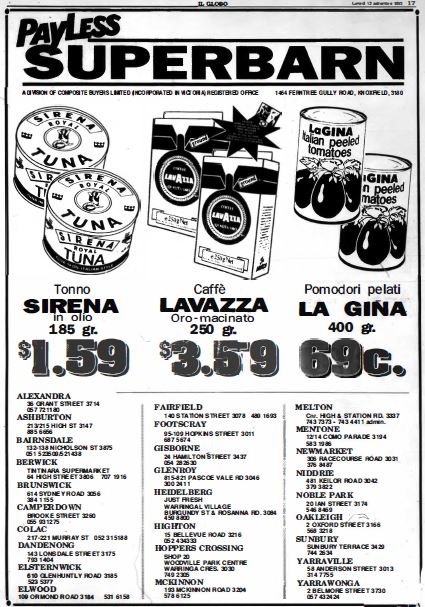
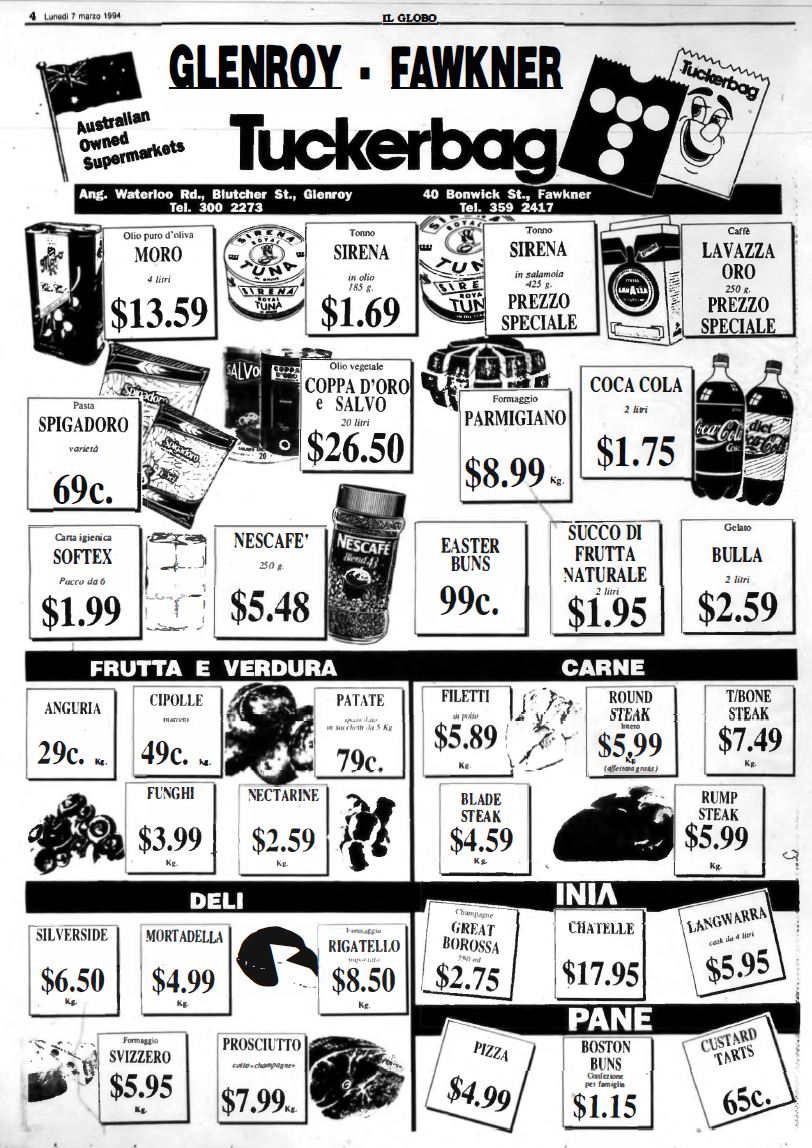
63 The relevant parts of the advertisements for the present case are:
|
|
| ||||
|
|
| ||||
|
|
| ||||
64 On 28 March 1988 and 6 June 1994, the following display advertisements appeared in La Fiamma.
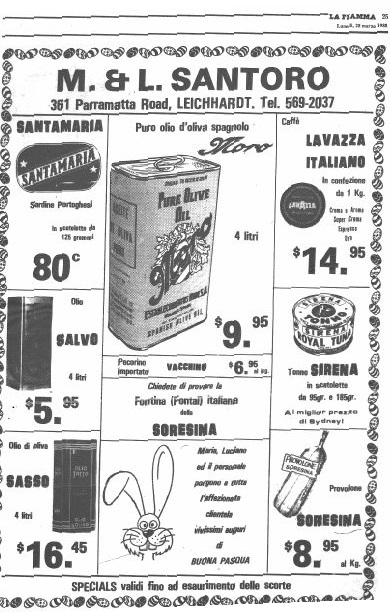
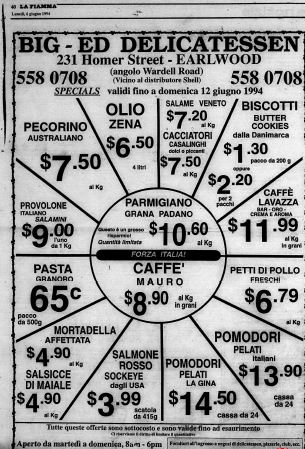
65 The relevant parts of the advertisements for the present case are:
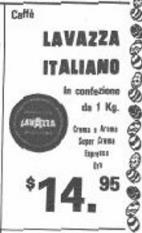

66 On 16 November 1990, LL SpA entered into an exclusive distributorship agreement for Australia and New Zealand with one of the companies in the Conga group, Conga Amalgamated. This agreement formalised the previous arrangements between LL SpA and Conga. Amongst other things, the agreement provided that Conga was to effectively and efficiently promote Lavazza products in Australia and New Zealand, subject to LL SpA’s specific prior approval of Conga Amalgamated’s advertising and publicity material. Conga Amalgamated was also granted the right to use some of LL SpA’s trade marks, subject to certain restrictions. The agreement commenced on 1 December 1990, and was for an indefinite period.
67 Following this agreement, advertising for LAVAZZA QUALITÀ ORO continued in the Il Globo and La Fiamma newspapers.
68 Between 27 May 1991 and 30 September 1991, Conga Amalgamated advertised LAVAZZA QUALITÀ ORO in Il Globo, La Fiamma, and also the trade magazine Retail World, by reference to the tagline: LAVAZZA “As good as Gold”. An example from La Fiamma newspaper on 15 August 1991 is:
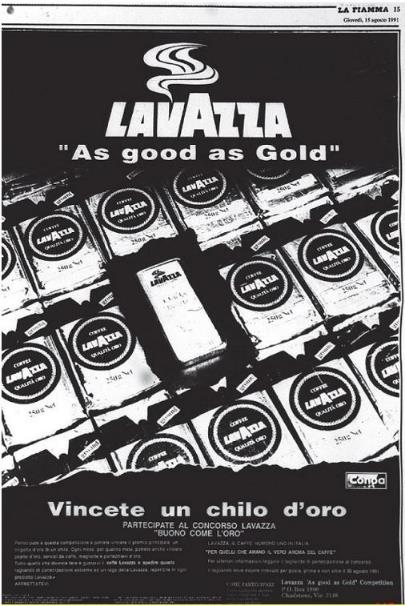
69 The following colour version of the advertisement appeared in Retail World on 24 July 1991:
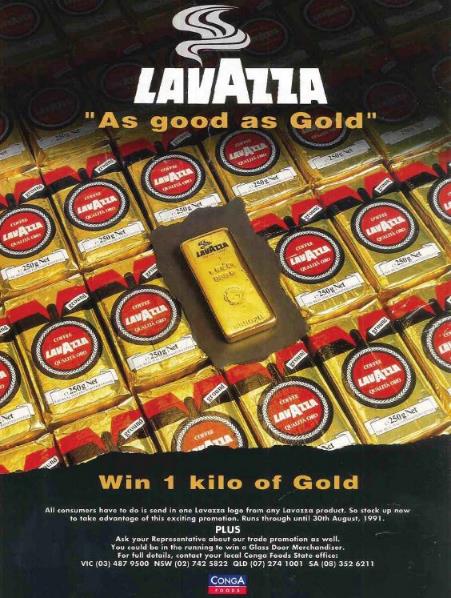
70 Sometimes the advertisements included other Lavazza coffee products. Sometimes LAVAZZA QUALITÀ ORO was simply referred to as LAVAZZA ORO.
71 For example, the following advertisement was published in Il Globo on 16 March 1992. The same advertisement was published on 14 occasions between 24 February 1992 and 2 November 1992 in Il Globo and La Fiamma:
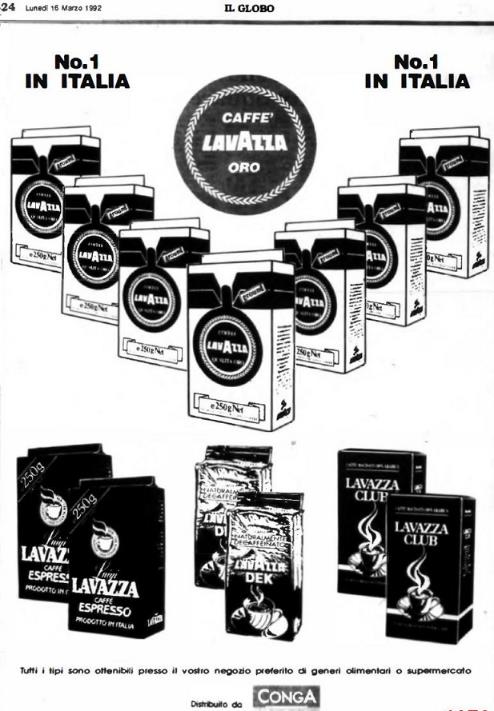
72 Another example is the following advertisement published in Il Globo on 1 June 1992:
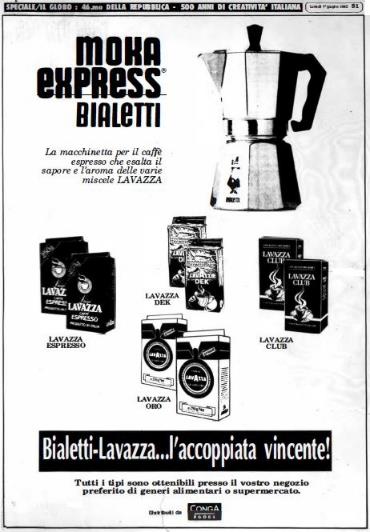
73 The evidence includes other examples of where, in print media, LAVAZZA QUALITÀ ORO is referred to as “Lavazza Gold”, or where “gold” is used in conjunction with the words “qualità oro”.
74 The evidence also includes invoices issued by supermarkets (including Woolworths and Coles) to Conga for advertising Lavazza coffee, including coffee referred to as “Lavazza Gold”, which I accept is a reference to LAVAZZA QUALITÀ ORO. However, the supermarket catalogues in evidence, which include advertisements for LAVAZZA QUALITÀ ORO, do not use the word “gold” in connection with the product.
75 The evidence also includes a video clip from March 1993 of a Lavazza promotion on the Australian television program “What’s Cooking” in which Ennio Ranaboldo (then the Head of Marketing and Training in the Italian Foodservice Sector at LL SpA) promotes LAVAZZA QUALITÀ ORO and refers to it as “Lavazza Gold Quality”.
76 On 1 July 1994, LL SpA, Conga Amalgamated, and Valcorp (then called Valcorp Holdings Pty Ltd) entered into a Transfer of Distribution Agreement. The effect of this agreement was to transfer the rights and obligations of Conga Amalgamated under the exclusive distributorship agreement to Valcorp. This arrangement continued from 1994 to 2015.
77 A report prepared by Valcorp for LL SpA, dated September 1995 and titled “Australian Market Data Update Report”, included AC Nielsen data which recorded that the LAVAZZA QUALITÀ ORO “GOLD GRND BRICK 250g” had the highest ranking in national sales (excluding Tasmania) for ground coffee, with sales from October 1994 to 30 September 1995 totalling $3,291,104. In its report, Valcorp claimed that, in the period January to September 1995, Lavazza coffee products held 11.1% of the Australian market (excluding Tasmania) for ground coffee.
78 A report prepared by Valcorp for LL SpA dated 6 March 2000, titled “National Market Overview Roast Coffee Valcorp Fine Foods”, included AC Nielsen data which recorded that the LAVAZZA QUALITÀ ORO “GOLD GRND BRICK 250g” had the highest ranking in national sales with a 4.9% share of the market segment for ground coffee. The LAVAZZA QUALITÀ ORO “GOLD GRND BRICK 500g” was ranked fourth in national sales with a 3.1% share of the market segment for ground coffee.
79 In 2003, LL SpA commissioned Ipsos to conduct a brand awareness survey of the Lavazza brand, including in Australia. Amongst other things, the results showed that consumer awareness in Australia of the Lavazza brand increased from 25% in 1999 to 28% in 2003; that, from 2000 to 2003, 80% of consumers who were aware of the Lavazza brand associated it with high quality coffee and 84% associated it with being consumed at a bar or restaurant; and that, in 2003, 79% of consumers aware of the Lavazza brand associated it with Italian provenance, with 77% of consumers identifying it as a well-known brand.
80 In 2003, LL SpA commissioned AC Nielsen to prepare a report on the Australian market for coffee. The report, titled “The coffee market in Australian Families”, was dated 9 January 2003. Of the 17 Lavazza products listed, “Lavazza Gold Ground Coffee 500g” (which I take to be a reference to LAVAZZA QUALITÀ ORO) was shown as at 28 September 2002 to be the second most popular Lavazza product (equal with “Lavazza Black Ground Coffee 250g”). The most popular Lavazza product was “Lavazza Caffe Espresso 250g”. The fourth most popular product was “Lavazza Gold Ground Coffee 125g” (which I also take to be a reference to LAVAZZA QUALITÀ ORO).
81 In May 2004, Valcorp placed the following advertisement for Lavazza coffee (including LAVAZZA QUALITÀ ORO) in Retail World magazine:
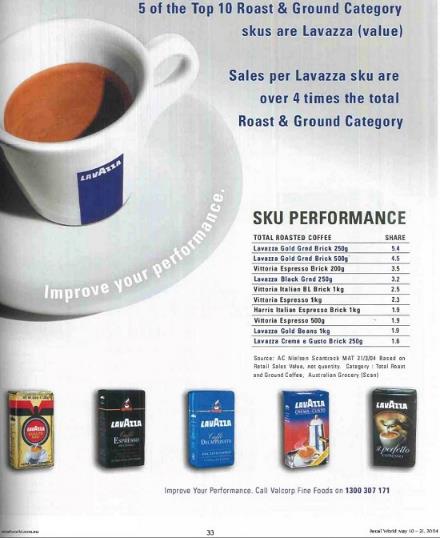
82 Valcorp placed a similar advertisement in Retail World in May 2005:
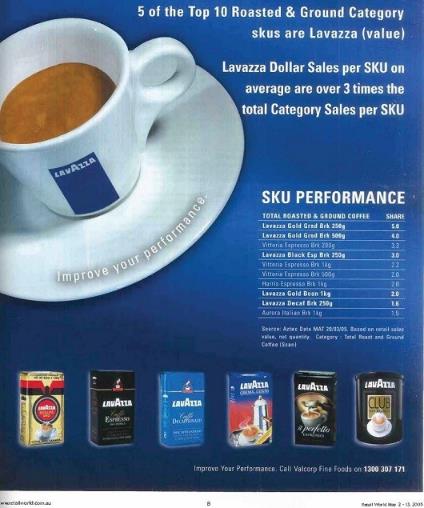
83 Lavazza draws attention to the description, in each advertisement, of LAVAZZA QUALITÀ ORO as “Lavazza Gold Grnd Brk” (250g and 500g) and “Lavazza Gold Bean”.
84 In 2007, Valcorp and LL SpA agreed to update the packaging of the Lavazza products destined for Australia. This was to distinguish the products sold by Valcorp as LL SpA’s exclusive distributor in Australia from genuine Lavazza products that were being imported into Australia by third parties.
85 The new packaging was more uniform in design. At the time, there were seven Lavazza retail products. All retained a medallion device, but each product was allocated a unique colour, with LAVAZZA QUALITÀ ORO retaining its gold-coloured packaging:
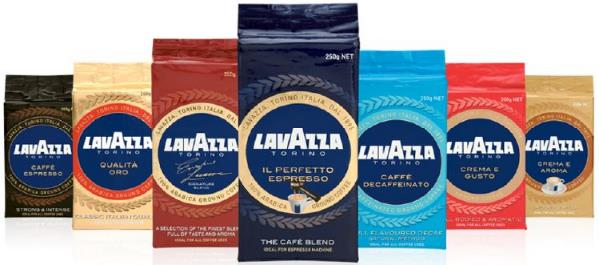
86 The medallion in the new packaging is different to the Classic medallion. The wreath is depicted outside the medallion; the black and red ribbons have been removed; the background colour of the medallion is blue, not LL SpA’s traditional red; and the word “Torino” and the date “1895” have been added. I will refer to the medallion in this form as the Blue medallion.
87 Exceptionally, new packaging was not developed for the LAVAZZA QUALITÀ ORO twin packs (2x250g). This product was packaged in accordance with LL SpA’s international (called ESTERO) packaging:
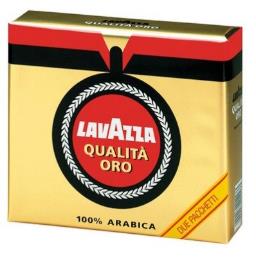
88 From at least around 2010, the ESTERO packaging for LAVAZZA QUALITÀ ORO included the following forms:
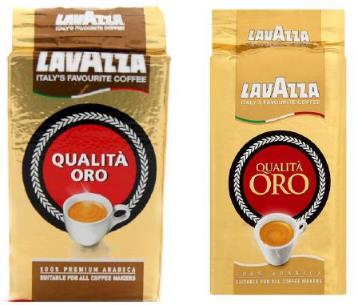
89 The medallion in this packaging is also different to the Classic medallion. The brand name LAVAZZA is not part of the medallion. Rather, it appears at the top of the packaging with the words “Italy’s favourite coffee” underlined by a strip bearing the colours of the Italian flag; and an image of a cup of coffee appears at the base of the medallion. The packaging depicted on the right above also uses a new font for the words “qualità oro”, which are depicted in gold with the word “oro” larger than the word “qualità”. For both packs, there is no associated ribbon device. I will refer to this as the ESTERO medallion. It is important to note, however, that other than for the twin packs, the packaging of LAVAZZA QUALITÀ ORO in Australia remained, at this time, the packaging with the Blue medallion. There were, however, parallel importations into Australia, in around 2010 or 2011, of products in the ESTERO packaging depicted above on the right.
90 Valcorp maintained websites from the early 2000s on which it advertised the Lavazza range of coffee products. Examples taken from the website on 19 September 2008 and 16 October 2011 include depictions of LAVAZZA QUALITÀ ORO, in the packaging with the Blue medallion, with the following description:
Qualita Oro or Lavazza Gold, as it is known in Australia, is the iconic product that made Lavazza famous worldwide and is also the first product to be imported to our shores by the founders of Valcorp Fine Foods back in 1955. Its classic Italian blend has been a favourite of Australian coffee connoisseurs for many years.
91 In 2013, LL SpA updated its Italian packaging for LAVAZZA QUALITÀ ORO. This packaging was launched in September 2013:
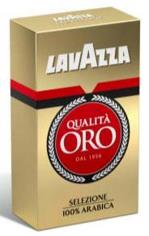
92 In 2014, LL SpA updated the ESTERO packaging for LAVAZZA QUALITÀ ORO to bring it into “harmony” with the updated Italian packaging:
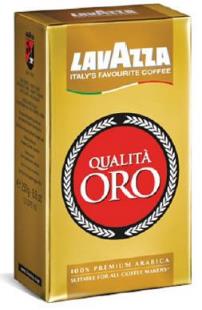
93 In Australia, the update to the ESTERO packaging only applied to LAVAZZA QUALITÀ ORO twin packs:
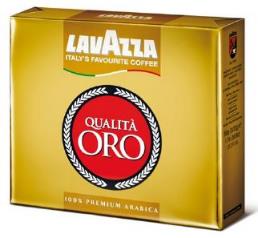
94 The evidence establishes that there were substantial sales of this product in Australia for the 2015 year. The monetary value of these sales is given in a confidential exhibit. It is not clear whether the years referred to are calendar years or financial years, but nothing turns on this for present purposes. Apart from the twin packs, Valcorp continued to supply coffee in Australia in the packaging with the Blue medallion.
95 By 2015, the Lavazza business in Australia had grown to such a size that LL SpA decided to undertake direct distribution. As a consequence, the distribution agreement with Valcorp was brought to an end and Lavazza Australia commenced distribution of all the Lavazza products. In effect, the distribution of Lavazza products in Australia was brought “in-house”.
96 In June 2015, LL SpA issued guidelines for the LAVAZZA brand (the 2015 Brand Guidelines). The 2015 Brand Guidelines were designed to emphasise LAVAZZA as the “masterbrand” and the “central element” above all other promotional elements.
97 At around this time, LL SpA updated the Australian-specific packaging for LAVAZZA QUALITÀ ORO. This change reflected the changes introduced by the 2015 Brand Guidelines:
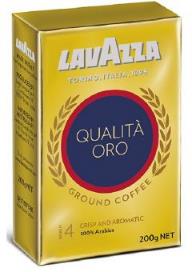
98 In 2015, LL SpA commenced a global packaging update—the “Perfect Pack” project. One of the main objectives of the project was to guarantee recognisability of the LAVAZZA brand across all countries, categories, and segments. Another objective was to create global consistency in the presentation of the packaging of LL SpA’s international range of products. The project involved 90 countries and 300 new packaging designs, including in respect of LAVAZZA QUALITÀ ORO.
99 There was concern within Lavazza Australia that the “Perfect Pack” project would affect the structural consistency that had been achieved for the LAVAZZA product range in Australia through use of the Australian packaging incorporating the Blue medallion. Lavazza Australia saw the proposed changes as posing a significant risk to the existing Australian “brand block”.
100 A draft of a Lavazza Australia internal “marketing update” expressed this concern as follows:
[T]he new pack structure is very different within the Autralian (sic) range and lacks structural consistency. As such, it look (sic) uncoordinated and undermines our premium brand image. We will lose the lovely brand block we have today with the recognisable (and consistent) flat colour and circle lockup.
101 In 2017, LL SpA rolled out the “Perfect Pack” revision to LAVAZZA QUALITÀ ORO. This revision applied globally and extended to the packaging of LAVAZZA QUALITÀ ORO products sold in Australia, replacing the packaging with the Blue medallion, which LL SpA considered to be inconsistent with its global uniform packaging strategy:
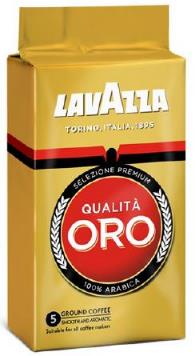
102 The twin packs of LAVAZZA QUALITÀ ORO were supplied in Australia in the following packaging:
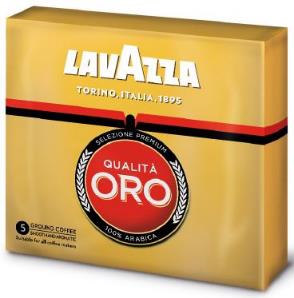
103 Cantarella contends that Lavazza’s supply in Australia of coffee in the “Perfect Pack” revisions referred to above infringes its registered marks.
104 As I have noted, in 2018 Lavazza OCS acquired the exclusive distributor in Australia of the Lavazza products in the OCS sector.
105 On 10 December 2018, LL SpA entered into separate distribution agreements with Lavazza Australia and Lavazza OCS, granting them exclusive distribution rights in respect of LAVAZZA products and the use of LL SpA’s trade marks.
106 In 2018, LL SpA conducted market research in Australia and Italy relating to updated packaging for LAVAZZA QUALITÀ ORO, including the possibility of introducing a “Mountain Grown” sub-blend.
107 As a result of this work, LL SpA introduced new packaging for LAVAZZA QUALITÀ ORO in 2019 which, at the same time, also introduced the “Mountain Grown” sub-blend. The new packaging for LAVAZZA QUALITÀ ORO was:
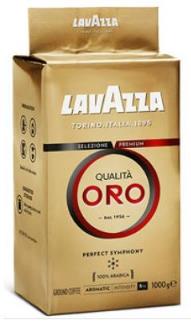
108 The new packaging of the twin packs of LAVAZZA QUALITÀ ORO was:
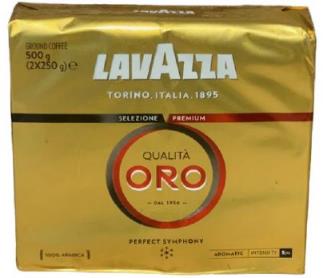
109 The packaging of the LAVAZZA QUALITÀ ORO “Mountain Grown” sub-blend was:
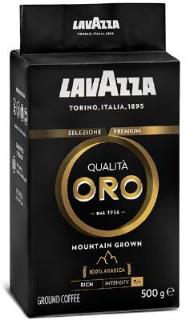
110 Cantarella contends that Lavazza’s supply in Australia of coffee in the new packaging introduced in 2019 infringes its registered trade marks.
111 In more recent times, LL SpA has launched new aluminium packaged Nespresso-compatible coffee capsules (NCCCs), including for LAVAZZA QUALITÀ ORO. The packaging for these products is the same for all of LL SpA’s markets. The packaging for the LAVAZZA QUALITÀ ORO NCCCs is closely similar to the 2019 packaging referred to above, except for the fact that the capsules themselves prominently bear the word “oro” in stylised script and the front of the box, in which the capsules are contained, bears an image of such a capsule:
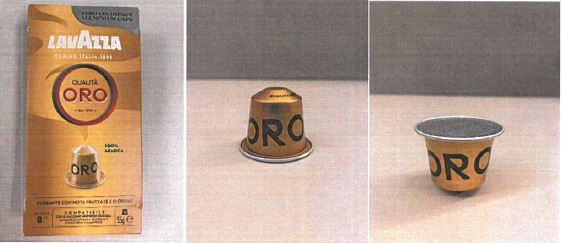
112 In 2021, Lavazza Australia showed the NCCCs to a number of main supermarket retailers in Australia as part of an annual review process.
113 Between 15 February and 11 April 2022, Lavazza Australia imported a large quantity of NCCCs which included LAVAZZA QUALITÀ ORO NCCCs. Between 4 and 12 March 2022, Lavazza Australia supplied LAVAZZA QUALITÀ ORO NCCCs, as well as other NCCCS, to Coles. These products were available for sale to the public from 4 April 2022.
114 Lavazza says that LL SpA supplied the LAVAZZA QUALITÀ ORO NCCCs to it by mistake—the mistake being that, while the present proceeding was on foot, LL SpA had determined that these NCCCs should not be supplied in Australia. However, because of oversight and communication mistakes within LL SpA, those products were supplied to Lavazza Australia.
115 From 11 April 2022, Lavazza Australia took steps to suspend the further sale and promotion of the LAVAZZA QUALITÀ ORO NCCCs. Nevertheless, the products that were already on shelves at Coles were sold and Lavazza Australia continued with its pre-planned promotional launch of those products. Lavazza Australia subsequently arranged a “clearance promotion” with Coles, commencing from around 4 May 2022, to have the products sold-down as quickly as possible so that they would, by that means, be “removed” from the market. In the course of that activity, some promotional materials for LAVAZZA QUALITÀ ORO NCCCs remained on display.
116 Before 9 April 2022 (when it learned of the mistake), Lavazza Australia had also provided samples of the LAVAZZA QUALITÀ ORO NCCCs to other retailers. One of these retailers was Amazon Australia, which subsequently placed orders for the product. Despite measures taken by Lavazza Australia to impede the receipt of such orders, orders from Amazon Australia were received and processed. Amazon Australia then supplied LAVAZZA QUALITÀ ORO NCCCs online for a limited time.
The use of “oro” by Molinari in Australia
117 The use by Molinari of the word “oro” as a trade mark in Australia was a substantial topic in this proceeding. Its significance lies in Lavazza’s challenge to the validity of the registrations of the 098 mark and the 290 mark. Lavazza contends that Cantarella’s claim to ownership of the ORO word mark (registered as the 098 mark and the 290 mark) is defeated by the sale of coffee by Molinari to CMS Coffee Machine Services Pty Ltd (CMS, later called Saeco Australia Pty Ltd (Saeco)) in Australia from September 1995, which Lavazza says amounted to use of the word “oro” as a trade mark. This is before the first date on which Cantarella says it used the ORO word mark in respect of coffee. Hence the significance of this topic in the proceeding.
118 Lavazza’s case focuses critically on three shipments of CAFFÈ MOLINARI ORO coffee which, it says, Molinari invoiced to CMS in September and October 1995 and in March 1996. The invoices for the shipments are no longer available because of changes to Molinari’s computer system in March 1996 and because archived documents have been destroyed over time. However, Maurizia Baraccani—the Head of Molinari’s Data Processing Centre who has worked for Molinari since 1994 and who assumed the role of Head of the Data Processing Centre in 1997—interrogated Molinari’s computer records and prepared two spreadsheets of sales data concerning Molinari coffee exported to Australia in the period 1995 to 2003.
119 CMS was the first Australian distributor of Molinari coffee. In Molinari’s sales records, CMS was given the client code 110103453 and Saeco was given the client code 110103878.
120 In her evidence in chief, Ms Baraccani explained that, before 1996, information relating to all Molinari coffee sales, both in Italy and abroad, was stored on a database managed by a computer system called “Olimpix”. Using that system, Molinari issued invoices to customers and recorded sales data in the system. The invoices were printed in hard copy and sent to customers by post or facsimile transmission. Molinari kept the hard copies in its archives. However, much of Molinari’s old paper records, including sales invoices, have now been destroyed.
121 Ms Baraccani participated in the migration of data from the Olimpix system to a new management system called “Kronos”. The migration occurred in March 1996. Because of limits on the type of information stored in the Olimpix database, only some information in relation to Molinari’s sales and products, existing before June 1996, was migrated to the Kronos system. The Kronos system can reproduce old sales invoices from 1996 onwards, but it cannot do so for sales before 1996 because the data transferred from the Olimpix system was only for “statistical purposes”. The Kronos system is still in operation at Molinari.
122 The spreadsheets prepared by Ms Baraccani contained data for client codes 110103453 (CMS) and 110103878 (Saeco). The spreadsheets also contain data for client codes 110106320 and 110107006: see [134] below.
123 Fabrizio Mengoli is the Sales, Marketing and Export Manager for Molinari. He was promoted to that position in 2008. He commenced his employment with Molinari on 18 March 1996 as an Export Manager. At that time, he was responsible for administering all exports of Molinari coffee, which included developing procedures for the sale and export of coffee, liaising with overseas clients, managing communications with export authorities, developing relationships with customers in global markets, and ensuring that orders placed with Molinari were fulfilled.
124 Mr Mengoli gave evidence concerning the Molinari coffee business, particularly with reference to the sales of CAFFÈ MOLINARI ORO coffee to Australia.
125 When Mr Mengoli commenced working at Molinari in March 1996, CAFFÈ MOLINARI ORO coffee was packaged as follows:
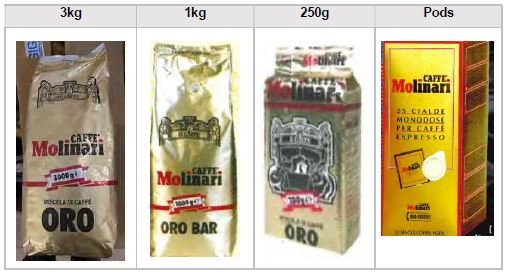
126 Mr Mengoli (and others in his team) carried out an investigation of Molinari’s records to ascertain whether different packaging was used by Molinari for these products in 1995. The result of this investigation was that nothing was identified which suggested that there was different packaging for these products in 1995.
127 A sample of the 3 kg product is in evidence. The sample was packaged on 25 September 2007. However, I am satisfied that the sample exemplifies the packaging of the 3 kg product in 1995.
128 The use of the word “bar” on the packaging of the 1 kg product refers to the fact that it was sold as part of Molinari’s “bar range”. Products in the bar range are sold to “coffee bars” (the equivalent of cafes). The 3 kg product was also part of Molinari’s bar range. Mr Mengoli’s evidence was that the word “bar” does not appear on the packaging of the 3 kg product because, given the size of the product, it was obviously intended for the hotels, restaurants, and catering distribution line of Molinari’s business.
129 With reference to the first spreadsheet prepared by Ms Baraccani, Mr Mengoli identified that the first recorded shipment by Molinari of coffee to Australia was on 18 September 1995. The supply was to CMS for products having specified product codes. The product codes included code 6093 and code 6091.
130 Mr Mengoli’s evidence was that product codes beginning with “60” and “15” refer to products within (what he called) “Molinari’s Oro range”. The evidence before me includes extracts of records from the Kronos system of various product codes. The records confirm that product code 6093 (which is recorded as having been created on 13 March 1996) refers to the product described as “CAFFE’ ORO BAR GRANI 3000g” and product code 6091 (which is recorded as also having been created on 13 March 1996) refers to the product described as “CAFFE’ ORO BAR GRANI 1000g”. Mr Mengoli said, and I accept, that the word “grani” in Italian means, in English, “grains” or “beans” and that this is how “grani” is used in these descriptions.
131 I draw attention to the recorded dates of creation of the product codes because, on the evidence before me, these dates correspond to the date of migration of Molinari’s sales records into the Kronos system. Mr Mengoli’s evidence was that, throughout March 1996, existing product items were migrated across from the Olimpix system to the Kronos system. However, the product codes themselves existed before 13 March 1996. I accept that evidence.
132 With reference to the first spreadsheet prepared by Ms Baraccani, Mr Mengoli identified further shipments of coffee to CMS on 17 October 1995 and 26 March 1996 (approximately one week after Mr Mengoli commenced his employment with Molinari). Once again, the invoices for the shipments are no longer available, but the Kronos system records that the shipments included product codes 6093 (the 3 kg pack) and 6091 (the 1 kg pack). Mr Mengoli’s personal observation was that, as at 26 March 1996, these particular products were packaged as shown at [125] above.
133 Molinari’s first three shipments to CMS on 18 September 1995, 17 October 1995, and 26 March 1996 comprised 36 units of product code 6093 (the 3 kg pack) and 612 units of product code 6091 (the 1 kg pack), being (in total) 720 kg of CAFFÉ MOLINARI ORO coffee. Mr Mengoli estimated that this was enough product to make approximately 86,400 to 100,800 cups of coffee.
134 The evidence also includes copies of invoices (extracted from the Kronos system) issued by Molinari to CMS and Saeco in the period from 24 July 1996 to 16 April 2003, and to two other Australian customers of Molinari—namely, a business called Coffee Supplies Australia located in Perth, Western Australia (client code 110106320) and Russo Pty Limited located in Hurstville, New South Wales (client code 110107006).
135 The invoices issued by Molinari to CMS in the period from 24 July 1996 to 24 March 2000 (the priority date of the 098 mark) include CAFFÈ MOLINARI ORO coffee in the 250 g pack (packaged as shown at [125] above).
136 The invoices issued by Molinari to Coffee Supplies Australia are for the period 9 December 1999 to 4 April 2002. The only invoice that predates the priority date of the 098 mark is an invoice dated 9 December 1999 which includes CAFFÈ MOLINARI ORO coffee pods (packaged as shown at [125] above).
137 The invoice issued by Molinari to Russo Pty Limited is dated 26 October 2000. This is after the priority date of the 098 mark but before the priority date of the 298 mark. The invoice includes CAFFÈ MOLINARI ORO coffee in the 1 kg pack.
138 To complete the chain of evidence in relation to Molinari’s first supply of coffee to CMS, Lavazza called evidence from Giorgio Massimo Ubertini and Esther Toledano. Cantarella initially objected to the receipt of this evidence (in the form of Mr Ubertini’s and Ms Toledano’s respective affidavits) on the basis that the evidence was not in reply. However, Mr Ubertini’s and Ms Toledano’s affidavits were read (subject to agreed rulings) and both deponents were cross-examined.
139 Mr Ubertini was a director of CMS (and then Saeco) between June 1993 and June 2007. He set up CMS with three business partners—Antonio Petrolito, Vincenzo Nespeca, and Angelo Augello. He was one of CMS’s directors and oversaw all aspects of the operation and management of its business. This included travel to Italy to liaise with manufacturers and to source products for CMS’s business.
140 CMS’s primary business was the importation and distribution of a range of Italian commercial and domestic coffee machines and grinders. The business also offered after-sales servicing and training to its customers, who were mainly commercial coffee suppliers and coffee roasters. However, CMS also supplied non-commercial customers (Mr Ubertini referred to them as “ordinary customers”) who bought domestic coffee machines and grinders for home use.
141 CMS operated from various premises in Melbourne, firstly from 1/33 Acheson Place, Coburg and then, from about August 1996, from 86 Newlands Road, Reservoir. In the middle of 2002, after CMS changed its corporate name to Saeco Australia Pty Ltd, the premises moved “across the road” to 87 Newlands Road.
142 Mr Nespeca and Mr Augello were also coffee roasters. They operated a separate business distributing their own brand of coffee called MONTE COFFEE. For a time, CMS’s business operated next door to the MONTE COFFEE warehouse, which was located at 31 Acheson Place, Coburg.
143 In the first couple of years of its business, CMS provided promotional packs of MONTE COFFEE to purchasers of its coffee machines.
144 In mid-1995, Mr Ubertini and Mr Petrolito purchased Mr Nespeca’s and Mr Augello’s shares in CMS, after which Mr Nespeca and Mr Augello were no longer involved in CMS’s business. Corporate records show that Mr Nespeca and Mr Augello ceased being directors of CMS on 17 August 1995. It seems that the parting was not entirely amicable. There were, apparently, some bad feelings due to disagreements about the operation of the CMS business.
145 After Mr Nespeca and Mr Augello had left, CMS had the opportunity to offer other brands of coffee to its customers. Mr Ubertini took up that opportunity.
146 Mr Ubertini’s evidence was that, in around September 1995, while in Italy on a regular buying trip and in his home town of Modena, he visited Molinari’s headquarters and met Giuseppe Molinari for the purpose of securing supplies of Molinari coffee to replace the MONTE COFFEE that CMS had previously supplied.
147 Mr Ubertini fixed on the period “of around September 1995” for two principal reasons. First, his meeting with Mr Molinari was not long after Mr Nespeca and Mr Augello had left the CMS business. Secondly, Mr Ubertini recalled that his meeting took place during one of his regular trips to Italy to attend the HOST tradeshow. The HOST tradeshow is Italy’s leading trade fair for the catering and hospitality industry. It was where Mr Ubertini met the suppliers of the coffee machinery that CMS was selling. When Mr Ubertini attended the HOST tradeshow, his practice was to travel to Italy at the end of August or the start of September, attend the tradeshow in October, and then return home to Australia immediately thereafter.
148 Mr Ubertini’s evidence was that he placed an initial order with Molinari for CAFFÈ MOLINARI ORO at his first meeting with Mr Molinari. Mr Ubertini was not able to recall precisely when the first shipment of the coffee arrived in Australia. He did recall, however, that the first shipment arrived shortly after he returned from the 1995 HOST tradeshow at the end of October 1995. He also said that, at the time, he was importing a lot of products from Italy which generally arrived by sea sometime between 3 to 6 weeks after orders were placed. This is broadly consistent with Mr Mengoli’s evidence as to the time taken for shipments by sea from Italy to Australia. Mr Mengoli’s evidence was that Molinari’s invoices are dated on the day that products leave its warehouse en route to its customers. Molinari’s shipments to Australia have always been by sea, with shipments generally taking between 25 to 50 days to arrive in Australia.
149 At the time that the first shipment arrived, CMS’s business was still located at 1/33 Acheson Place, Coburg, next door to the MONTE COFFEE warehouse. Mr Ubertini said that he covered the first pallet of the coffee received from Molinari when it arrived at CMS’s premises because he did not want to upset Mr Nespeca and Mr Augello by “showing off” the new brand of coffee he had imported. As I have noted, the circumstances in which Mr Nespeca and Mr Augello left the CMS business were not entirely amicable and Mr Ubertini did not want to increase the tensions between them by selling a competing brand of coffee in close proximity to the MONTE COFFEE warehouse. That said, Mr Ubertini’s evidence was that CMS continued to purchase the cheapest blend of MONTE COFFEE, which was used in the testing and servicing of the coffee machines supplied by CMS (as Mr Ubertini later explained, he did not want to use the more expensive CAFFÈ MOLINARI ORO for this purpose).
150 Although Mr Ubertini could not recall specifically what was in the first shipment, he nevertheless remembered that it was CAFFÈ MOLINARI ORO, which he described as the “top-quality Molinari coffee used in bars and restaurants in Italy, mainly in 1 kg bags”. He also remembered that CMS imported some larger 3 kg bags of the same blend.
151 Following the first shipment, Mr Ubertini remained the key contact within the CMS business for purchases of CAFFÈ MOLINARI ORO coffee. This involved placing orders by telephone and facsimile, receiving invoices and overseeing the payment of the invoices, and other general correspondence with Molinari. After initially dealing with Mr Molinari directly, Mr Ubertini commenced to deal with Mr Mengoli several months later.
152 The evidence includes a copy of a letter dated 23 July 1996 from Molinari addressed to CMS at 1/33 Acheson Place, Coburg. The copy of the letter was found in Molinari’s archived records. It is written in Italian, but an English translation has been provided by an independent translator. The letter was written by Mr Mengoli. Mr Mengoli addressed the letter personally to “Mr Ubaldini”.
153 Mr Mengoli’s evidence was that the reference to “Mr Ubaldini” was a misspelling of Mr Ubertini’s name. Mr Mengoli says that, at the time, Mr Ubertini was the only person in Australia with whom he was dealing. I accept this explanation of the use of “Mr Ubaldini”.
154 The letter commences by thanking “Mr Ubaldini” for an order and for a “cordial telephone call [on] 18/06/96”. The letter then raises various propositions that Molinari was interested in pursuing with CMS—specifically, filters; “white label” coffee pod production; and developing Molinari coffee distribution in Australia.
155 Mr Ubertini’s evidence did not go so far as to acknowledge his receipt of this letter, although he did say that he recalled receiving “many communications of this sort throughout CMS’s trade relationship with Molinari”.
156 Cantarella submits that this letter is not consistent with “any relevant existing relationship” between Molinari and CMS and that, taken with Mr Mengoli’s cross-examination, indicates, amongst other things, that there was no actual or even potential supply of Molinari coffee to CMS prior to 18 September 1996 (i.e., one year later than the Molinari affidavits show).
157 In that connection, Cantarella draws attention to the fact that the letter refers to Mr Mengoli having included “some samples of pods which we hope may come close to those demanded by your market for a much longer extraction of coffee”. Cantarella submits that it is unlikely that there would have been a supply of sample pods if Mr Ubertini had already ordered them in a previous shipment. Cantarella submits that this makes the possibility of any transaction between Molinari and CMS before 23 July 1996 “improbable”.
158 I do not accept that submission. Molinari’s computer records show that, prior to 23 July 1996, the only shipment of pods to CMS was that covered by an invoice dated 26 March 1996. This was for only 5 units (with 25 pods to a unit). The identity of the pods to which the letter of 23 July 1996 refers has not been established. In other words, it is far from clear that the samples that Mr Mengoli provided were the same product as the relatively small quantity of pods that Molinari had shipped under the invoice. Indeed, there is good reason to think that they were not. In his letter, Mr Mengoli said that “… on the basis of your report, we have included some samples of pods …” (emphasis added). This suggests that Mr Ubertini had already reported to Mr Mengoli on pods and that Mr Mengoli was sending further pods, which had a “much longer extraction of coffee” for Mr Ubertini to try.
159 Mr Ubertini said that, from September 1995 to about 2003, CMS purchased CAFFÈ MOLINARI ORO from Molinari. He said that when pallets arrived in Australia, he arranged for someone in the business to check that all the goods on the relevant invoice had arrived. He said that he did not recall any shipments that he had ordered not arriving or falling short of the orders that had been placed.
160 Mr Ubertini recalled that the packaging of the CAFFÈ MOLINARI ORO coffee that CMS received was that depicted above at [125].
161 Mr Ubertini’s evidence was that CMS imported the CAFFÈ MOLINARI ORO coffee to sell alongside its coffee machines direct from CMS’s premises, rather than the MONTE COFFEE. He said that, from about the end of October 1995 onwards, customers who purchased a domestic coffee machine from CMS were given a “promotional” 1 kg bag of CAFFÈ MOLINARI ORO in the packaging depicted above at [125]. He said that this form of promotion proved to be very successful because many of CMS’s domestic customers would return to purchase more packs. He said that, from the end of October 1995 onwards, he recalled selling CAFFÈ MOLINARI ORO coffee directly to customers “on many occasions”.
162 Mr Ubertini also gave evidence that, at the start of CMS’s importation of CAFFÈ MOLINARI ORO coffee, he also sold 3 kg and 1 kg packs to Giancarlo Squillaciotti for use in the Italian restaurant called “Trattorante”, which operated on Church Street, South Brighton.
163 Mr Ubertini also gave evidence that staff and directors of CMS also used the CAFFÈ MOLINARI ORO coffee to make coffee beverages for themselves and customers at CMS’s premises to promote the coffee.
164 Mr Ubertini said that CMS’s sales of CAFFÈ MOLINARI ORO coffee increased from about August 1997 when CMS moved to new premises at 86 Newlands Road, Reservoir. Mr Ubertini felt that CMS could more freely promote the coffee at the new premises without upsetting Mr Nespeca and Mr Augello. However, CMS only promoted and sold CAFFÈ MOLINARI ORO coffee on its premises. It did not actively promote or advertise the coffee because, although keen to sell it, the focus of CMS’s business was coffee machines and Mr Ubertini did not want to “cut across” CMS’s valued customers who were coffee suppliers or coffee roasters. Therefore, the CAFFÈ MOLINARI ORO coffee was only directly promoted to “domestic” customers and other customers who were not coffee suppliers or coffee roasters.
165 I did not find Mr Ubertini to be an entirely satisfactory witness under cross-examination. On some occasions he appeared to be unable to attend to the questions asked of him. On some occasions, he gave answers that were not entirely responsive. On some occasions, he attempted to offer information he was not asked to offer (he was loquacious).
166 In fairness, I should point out that Mr Ubertini gave his oral evidence by video-link from Italy at a difficult time (late evening/early morning). Mr Ubertini is elderly and giving evidence by this means at this time of the day was likely to have been challenging for him. I make allowance for that possibility in relation to his presentation as a witness. I do not think that Mr Ubertini was intending to be unhelpful. I do not think that he was attempting to evade answering questions. I consider him to be a truthful witness. Nevertheless, based on his presentation in cross-examination, I treat his evidence with circumspection.
167 Ms Toledano was employed by CMS (and then Saeco) between June 1993 and February 2007 as a Finance and Administration Manager. In that role, she was responsible for supervising and maintaining financial and administrative records, and monitoring CMS’s systems to account for and reconcile expenditures, sales, balances, and payments. This involved managing invoices, shipping costs, and data entry in relation to CMS’s imports and sales to ensure that all stock was accounted for.
168 Ms Toledano confirmed that CMS operated from different premises in Melbourne including, first, 1/33 Acheson Place, Coburg until CMS moved its warehouse premises to 86 Newlands Road Reservoir. Ms Toledano fixed the date of the move as (around) August 1996 by reference to the birth of her daughter (having previously deposed that the move occurred around August 1997). Ms Toledano said that CMS moved to 87 Newlands Road in the middle of 2002.
169 I do not think that anything turns on the date of the move to 86 Newlands Road. However, I mention these matters because Cantarella places much reliance on a company search of CMS which shows that the start date for the business address at 1/33 Acheson Place was 24 July 1996—the point being, apparently, that, if this was the actual start date, CMS could not have received supplies of Molinari coffee at 1/33 Acheson Place in 1995 or the early part of 1996.
170 I do not accept that contention. Whatever the corporate records with the Australian Securities and Investments Commission (ASIC) show, I accept Ms Toledano’s evidence as to the actual location of CMS’s business in 1995 and the first half of 1996. I note, in this regard, that, curiously, the same company search also shows that CMS’s principal place of business in the period 30 June 1994 to 23 July 1996 was 31 Acheson Place.
171 The better view of the evidence is that before 24 July 1996 (including in 1995), CMS’s principal place of business was actually 1/33 Acheson Place. It is possible (although I do not need to find) that, because of the corporate and business relationship between the four founders of the CMS business, and bearing in mind that Mr Nespeca’s and Mr Augello’s other business (MONTE COFFEE) was next door to CMS at 31 Acheson Place, the 31 Acheson Place address was originally, but mistakenly, given to the Australian Securities and Investments Commission as CMS’s principal place of business. I am satisfied, however, that CMS did not trade, physically, from the MONTE COFFEE premises at 31 Acheson Place. I am satisfied that Molinari’s early shipments of coffee to CMS were received at 1/33 Acheson Place, which was CMS’s principal place of business before 24 July 1996.
172 I also note that Mr Mengoli’s letter to “Mr Ubaldini” was dated 23 July 1996, and addressed to CMS at 1/33 Acheson Place, indicating that that address was already known to Mr Mengoli (or, at least, Molinari). Cantarella suggests that, at the time of the conversation between Mr Mengoli and Mr Ubertini (to which the letter refers), Mr Ubertini must have given the 1/33 Acheson Place address as a “proposed new address” for CMS. I am not persuaded that this was the case. It is more likely that this address was already known to Molinari because, in fact, it had already made shipments of Molinari coffee to that address.
173 In Ms Toledano’s early years of employment at CMS, she was the only person physically working in the business (apart from Mr Ubertini and Mr Petrolito). This meant that she was responsible for taking orders (in person and over the telephone), packing orders, and selling machinery and coffee to walk-in customers when Mr Ubertini was not at the warehouse. CMS employed another person to assist with these tasks in around April or May 1996, when Ms Toledano was pregnant with her first daughter (who was born in September 1996).
174 Ms Toledano’s affidavit evidence was that, shortly after Mr Nespeca and Mr Augello left the CMS business, CMS began importing coffee from Molinari to supply to its customers. Ms Toledano placed the commencement of this activity at sometime after August 1995, but before the end of 1995. She said that, although not involved in arranging the purchases, she remembered shipments of Molinari coffee arriving at CMS’s warehouse at 1/33 Acheson Place. It was part of her job to take account of all imported goods to make sure they “aligned with the invoices”.
175 Ms Toledano’s evidence was that CMS mainly imported CAFFÈ MOLINARI ORO beans in 1 kg packs. However, she said that, at the start, CMS also imported larger 3 kg packs of CAFFÈ MOLINARI ORO beans. Ms Toledano said that CMS later imported CAFFÈ MOLINARI ORO coffee pods (when CMS started to sell pod machines), and also some ground CAFFÈ MOLINARI ORO coffee in 250 g packets. She said that CMS’s preference was to import beans rather than ground coffee, so that the beans could be sold with CMS’s coffee machines and grinders. Ms Toledano confirmed that the Molinari coffee was packaged as depicted at [125] above.
176 Ms Toledano’s evidence was that the CAFFÈ MOLINARI ORO coffee was kept in CMS’s showroom at its warehouse at 1/33 Acheson Place, and that, in order to promote sales of the coffee, 1 kg packs were provided to customers when they purchased coffee machines. Ms Toledano recalled that customers who purchased domestic coffee making machines from CMS, and had received a “promotional” pack of CAFFÈ MOLINARI ORO, would often return to CMS’s warehouse to purchase more of the coffee. Her evidence was that some customers returned within a month of receiving the first pack. Ms Toledano said that she specifically recalled providing and selling bags of CAFFÈ MOLINARI ORO coffee to several of these walk-in customers when she was alone in CMS’s showroom at 1/33 Acheson Place.
177 Ms Toledano’s evidence was that CMS continued to import and sell CAFFÈ MOLINARI ORO after CMS moved its warehouse premises to 86 Newlands Place in around August 1996.
178 Ms Toledano said that CMS “did not ever widely advertise its distribution” of Molinari coffee. This was because selling coffee was only a small part of the CMS business and CMS did not want to be seen by its coffee supplier customer-base to be promoting and selling coffee that would be a rival brand to the coffee supplied by those customers. Nevertheless, Ms Toledano said that, before April/May 1996 (i.e., at a time when she was CMS’s only employee at the premises at 1/33 Acheson Place), she often made cups of coffee for walk-in customers using the 3 kg and 1 kg bags of CAFFÈ MOLINARI ORO. She said that these bags were displayed next to the coffee machines and grinders used in the warehouse, for customers to see and purchase.
179 Ms Toledano was not directly challenged in cross-examination on her affidavit evidence. She agreed that the first supply of Molinari coffee was to CMS’s premises at 1/33 Acheson Place. She said that CMS was at 1/33 Acheson Place from 1993. It was put to her that the ASIC records showed that CMS’s principal place of business did not become 1/33 Acheson Place until 24 July 1996. She responded by saying that she did not know what the ASIC records showed, but CMS was trading at 1/33 Acheson Place before 1996.
180 It was put to Ms Toledano that the first shipment of Molinari coffee did not arrive until after 24 July 1996. She gave this answer:
… Well, I know it arrived when we were still at 1/33 Acheson Place – yes – so July – no, it would have been before that, I think. Or maybe around that time. I can’t recall exactly when the shipment arrived.
And do you accept that the first arrival was at 1/33 Acheson Place?---Yes.
181 Ms Toledano later accepted that it was possible that the first shipment arrived after 24 July 1996. But, in the end, her oral evidence was no more definite than that (a) the first shipment would have arrived before 24 July 1996; (b) that it was at least possible that it arrived after 24 July 1996; and (c) that the first shipment arrived at 1/33 Acheson Place which CMS had occupied from 1993.
182 Ms Toledano’s affidavit gives a more focussed recollection—namely, that CMS commenced ordering Molinari coffee shortly after Mr Nespeca and Mr Augello had left the CMS business, and that the first two shipments from Molinari arrived before the end of 1995. Although Ms Toledano’s oral evidence throws some doubt on the reliability of this recollection, I do not take her to have resiled from what she had said in her affidavit. Moreover, her evidence must be considered as a whole and with the other evidence before the Court, which includes Mr Ubertini’s evidence as to his first order on Molinari and the timing of the arrival of that order at 1/33 Acheson Place, and Molinari’s available accounting records, which accord with Mr Ubertini’s evidence on this topic.
183 It is necessary for me to say something about an affidavit given by Mr Molinari in the Modena proceeding (to which I refer at [264] below). In that affidavit, which was tendered by Cantarella in this proceeding, Mr Molinari deposed that Molinari commenced exporting products to Australia “in or about July 1996”. He referred to CMS’s distribution of products in Australia in the period July 1996 to March 2001. He produced a number of invoices evidencing that supply. He also referred to Molinari’s supplies to Coffee Supplies Australia and to Russo Pty Ltd.
184 Mr Molinari’s evidence that Molinari commenced exporting products to Australia “in or about July 1996” is inconsistent with the evidence before me. Although Lavazza emphasises Mr Molinari’s use of the expression “in or about” (to suggest a degree of imprecision), I do not accept that the expression “in or about” has the plenitude which Lavazza seeks to attribute to it.
185 Cantarella submits that precedence should be given to the statements in, and evidence given through, Mr Molinari’s affidavit read in the Modena proceeding over the evidence given in this proceeding by, and through, Mr Mengoli, Ms Baraccani, Mr Ubertini, and Ms Toledano. Cantarella submits that the Court ought to presume that Mr Molinari, as a director of Molinari, interrogated all relevant electronic records and had “taken great care to produce the best evidence available and to present the best case possible in the Modena proceedings”. Cantarella also submits that if, in giving evidence in the Modena proceeding, Mr Molinari could advance a case that Molinari was the owner of the ORO word mark, then it can be expected that Mr Molinari would have done so. Cantarella argues that the fact that no such case was advanced in the Modena proceeding “must be a complete answer” to the case now advanced by Lavazza and “speaks to the inherent unreliability of the purported business records … which are asserted to evidence sales from Molinari to CMS” before 18 September 1996.
186 Cantarella also contends that the records on which Lavazza relies in respect of the supply of CAFFÈ MOLINARI ORO coffee to CMS are “incomplete”—an apparent reference to the fact that certain invoices cannot be reproduced by Molinari notwithstanding the fact that evidence of the transactions in question is captured within Molinari’s Kronos system.
187 Cantarella points out that Lavazza has not adduced evidence that Molinari has searched its paper records in an attempt to locate invoices with respect to its early supplies of CAFFÈ MOLINARI ORO coffee to Australia. I observe, however, that the supplies in question were, at the time of the hearing, some 25 years ago. Ms Baraccani’s evidence was that while Italian law requires companies to keep hard copies of invoices for a period of not less than five years, much of Molinari’s old paper documentation, including sales invoices, has been destroyed. Cantarella submits that, in the absence of evidence of search and destruction, “the Court must infer that such records exist and were not destroyed”.
188 Notwithstanding these submissions, I accept the evidence of Mr Mengoli, Ms Baraccani, and Ms Toledano. I consider their evidence to be credible and reliable. Despite some unsatisfactory aspects of Mr Ubertini’s oral evidence (to which I have referred), I accept his evidence as well. In particular, I accept his evidence that he first ordered Molinari coffee when he was in Modena in September 1995 and that the first shipment of Molinari coffee arrived at 1/33 Acheson Place by the end of October 1995.
189 Further, I am satisfied that reliance can, and should, be placed on Molinari’s computer records tendered in this proceeding through Ms Baraccani and Mr Mengoli. I do not accept Cantarella’s contention that these records should not be given weight.
190 I reach these findings fully cognisant of the significance that this evidence has to Cantarella’s present rights of ownership of the ORO word mark as a registered trade mark.
191 On the whole, the evidence adduced by Lavazza on this topic is comprehensive and detailed, and has been subjected to testing by Cantarella in the cross-examination of all the witnesses who contributed to the evidence on this topic. Subject to the comments I have made with respect to Mr Ubertini’s testimony, I have not found that evidence to be wanting.
192 I prefer this body of evidence to the statement made in Mr Molinari’s affidavit with respect to the time that Molinari began exporting products to Australia. Based on the other evidence before me, I am satisfied that Mr Molinari’s statement in this regard is mistaken and inaccurate. The statement was made some 16 years after the event. It appears to have been made on the basis of incomplete information provided to him. It may be, as Mr Mengoli suggested, that the change to Molinari’s computer system in the first half of 1996 explains why Mr Mengoli did not provide evidence of the supply of CAFFÈ MOLINARI ORO coffee to Australia prior to July 1996 and why, in his affidavit, Mr Molinari proceeded on the basis that export to Australia only commenced “in or about July 1996”. I do not propose, however, to speculate about that matter.
193 Having regard to all the evidence before me on this issue, I am satisfied that Molinari supplied CAFFÈ MOLINARI ORO coffee to CMS in 1995 and in the first half of 1996. In particular, I am satisfied that:
(a) each shipment to CMS covered by the invoices dated 18 September 1995, 17 October 1995, and 26 March 1996 (as recorded in Molinari’s Kronos system) was made;
(b) the products identified by product codes 6091 and 6093 were included in the shipments in the quantities stated in Molinari’s Kronos system, and were packaged in the packaging depicted at [125] above;
(c) each shipment left Molinari’s warehouse in Italy on the date of the invoice corresponding to that shipment as recorded in Molinari’s Kronos system;
(d) each shipment was received at CMS’s warehouse premises, in accordance with the invoice corresponding to that shipment, at 1/33 Acheson Place, Coburg, approximately 4 to 7 weeks after the invoice date; and
(e) the CAFFÈ MOLINARI ORO coffee received by CMS was used, displayed for sale, and supplied by CMS, as described in Ms Toledano’s evidence.
194 For reasons that will become apparent, it is appropriate that I refer to other aspects of Molinari’s supply of CAFFÈ MOLINARI ORO coffee to the Australian market.
195 Espresso Group Pty Ltd (Espresso Group) distributed Molinari products in Australia from about January 2001 until November 2009. It was appointed as Molinari’s exclusive Australian distributor in around March 2003.
196 Modena Trading Pty Ltd (Modena) is Molinari’s current Australian distributor. It was appointed as Molinari’s exclusive Australian distributor in around 2009.
197 I have already referred to copies of invoices (extracted from the Kronos system) that Molinari issued to CMS in the period 24 July 1996 to 16 April 2003 and to Coffee Supplies Australia in the period 9 December 1999 to 4 April 2002 in respect of CAFFÈ MOLINARI ORO coffee. The supplies covered by these invoices included supply of CAFFÈ MOLINARI ORO coffee in the 250 g pack (product code 1525E). These packs are directed to the retail sector of the market, for supermarkets and consumers.
198 There is also a spreadsheet in evidence which contains details of invoices of CAFFÈ MOLINARI ORO coffee supplied to Espresso Group (for the period January 2001 to August 2009) and Modena (for the period October 2009 to September 2021). This spreadsheet evidences that CAFFÈ MOLINARI ORO coffee in the 250 g pack was also supplied to Espresso Group as late as 6 November 2007.
199 At some time before December 2003 (the evidence is no clearer than that) the packaging of the 250 g pack was updated to the following packaging:
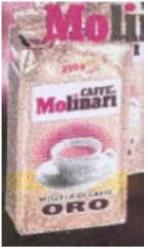
200 I am satisfied that the 250 g packs of CAFFÈ MOLINARI ORO coffee (product code 1525E) that Molinari supplied to CMS (invoice dated 25 September 1997) and Coffee Supplies Australia (invoices dated 26 July 2001 and 4 April 2002) were in the form of the packaging depicted at [125] above, and that the 250 g packs of CAFFÈ MOLINARI ORO coffee that Molinari supplied to Espresso Group (invoices dated 11 September 2001, 17 January 2002, 19 February 2002, 18 April 2002, 18 December 2002, 25 March 2004, 12 April 2005, 21 November 2006, and 8 June 2007) were either in the form of the packaging depicted at [125] above or at [199] above.
201 The packaging of the 1 kg pack of CAFFÈ MOLINARI ORO coffee (product code 6091) was also updated to the following:
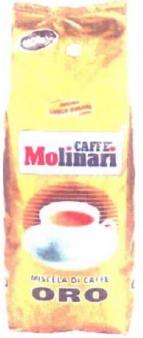
202 The evidence is unclear as to when this packaging change occurred. The best evidence that Mr Mengoli could give was that the change occurred sometime after the similar change to the packaging of the 250 g pack of CAFFÈ MOLINARI ORO coffee was made.
203 The spreadsheet records numerous supplies, in significant quantities, of CAFFÈ MOLINARI ORO coffee in 1 kg packs to both Espresso Group and then to Modena in the period 22 January 2001 to 22 October 2009. I am satisfied these supplies in the period after December 2003 included supplies to Espresso Group of 1 kg packs (product code 6091) in the form of the packaging depicted at [201] above: see invoices dated 25 March 2004; 27 May 2004; and 15 July 2004 totalling 13,540 packs. (I note that the spreadsheet records numerous supplies, in significant quantities, of CAFFÈ MOLINARI ORO in 1 kg packs to both Espresso Group and then to Modena in the same period under product code 6091E. There is no direct evidence of the packaging for this product code.)
204 Mr Mengoli said that, to the best of his recollection, 1 kg packs of CAFFÈ MOLINARI ORO coffee in the packaging depicted at [201] above were exported to Molinari’s Australian distributors until the packaging was further updated, as follows:
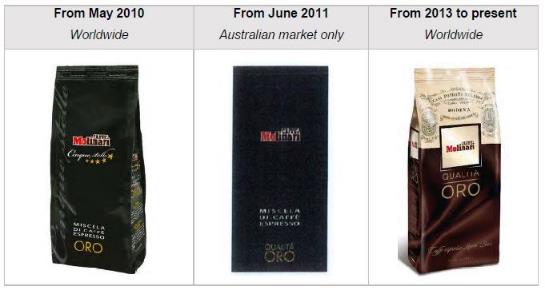
205 I understand from Mr Mengoli’s evidence, and find, that: (a) from May 2010 until June 2011, the packaging used for CAFFÈ MOLINARI ORO coffee supplied into the Australian market in 1 kg packs was the packaging shown immediately above under the heading “From May 2010 Worldwide”, and (b) from 2013, the packaging for this product has been the packaging shown immediately above under the heading “From 2013 to present Worldwide”. However, for the period from June 2011 to sometime in 2013, the packaging of 1 kg packs of CAFFÈ MOLINARI ORO coffee supplied into the Australian market was the packaging shown immediately above under the heading “From June 2011 Australian market only”.
206 The products that were supplied by Molinari to Modena in the period from May 2010 include 1 kg packs of CAFFÈ MOLINARI ORO coffee with product codes 6071, 6077, 6021A, and 6021E. With reference to the images depicted at [204] above, the packaging for these product codes was as follows:
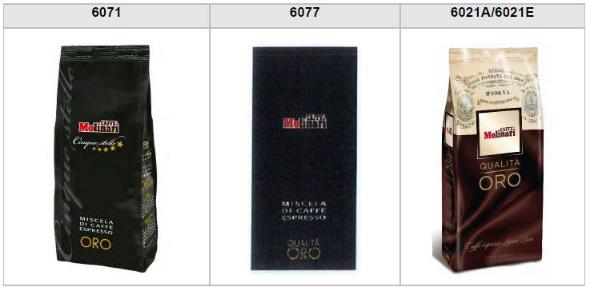
207 The packaging for product code 6021A was created to include the name and address of Modena. The evidence before me is that the packaging is otherwise the same as the packaging used for product code 6021E.
208 The spreadsheet records numerous supplies, in significant quantities, of CAFFÈ MOLINARI ORO coffee to Modena and Espresso Group in 1 kg packs under product code 6071 (in the period 25 March 2009 to 3 March 2011), and to Modena under product codes 6077 (in the period 6 May 2011 to 17 September 2013), 6021E (in the period 17 September 2013 to 29 June 2017), and 6021A (in the period 13 July 2017 to 17 September 2021).
The use of “oro” by other traders in Australia
209 In Annexure B of its third further amended defence and Annexure A of its further amended statement of cross-claim, Lavazza lists other suppliers of coffee in Australia who use, or have used, the words “oro” or “d’oro” in combination with other words in relation to their products.
210 In closing submissions, Lavazza relied on particular uses:
(a) before 1996;
(b) before 24 March 2000;
(c) before 30 September 2013; and
(d) since 2020.
211 These “uses” include applications made for certain registered trade marks. Although the evidence shows that a number of these applications proceeded to registration, the evidence also shows that some of the registrations have since been removed from the Register of Trade Marks (the Register).
212 La Casa is a family business operated through the corporate entity La Casa Del Caffe (Australia) Pty Ltd. La Casa sells its coffee products online (via a website) and through its roastery shop at Minto in New South Wales. La Casa offers a number of different coffee blends under the LA CASA DEL CAFFE brand, including a blend referred to as TAZZA D’ORO. This blend has been continuously roasted and sold by La Casa under that name since 1973.
213 On 8 March 1984, Bean Alliance Group Pty Ltd applied to register a composite mark which included the words GUSTO AROMA E QUALITA and TAZZA D’ORO:
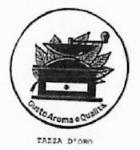
214 The mark was entered on the Register on 10 April 1987 as Trade Mark No. 404924 in respect of “coffee” in Class 30. There is no evidence that the mark was used.
215 On 3 January 1990, Mauro Demetrio SpA applied to register a composite mark which included the words MAURO; CAFFE SCELTA D’ORO ESPRESSO; and COFFEE – KAFFEE - CAFE:
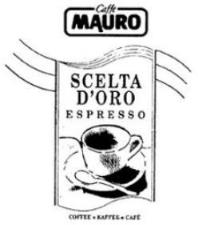
216 The mark was entered on the Register on 22 January 1992 as Trade Mark No. 526225 for “coffee” in Class 30. There is no evidence that the mark was used. The mark was removed from the Register on 20 January 1998 for non-payment of the renewal fee.
217 On 25 February 1992, Cipolla Imports Pty Ltd applied to register a composite mark which included the words ORO MIO:
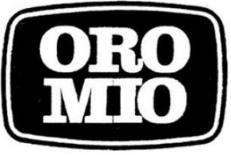
218 The mark was entered on the Register on 25 October 1993 as Trade Mark No. 573069 for “pasta, flour, sauces, coffee and cocoa” in Class 30. There is no evidence that the mark was used. The mark was removed from the Register on 13 March 2000 for non-payment of the renewal fee.
219 On 9 September 1993, an application to register the mark PIAZZA D’ORO was filed. The mark was entered on the Register on 31 January 1995 in the name of Koninklijke Douwe Egberts BV as Trade Mark No. 611223 for various goods in Class 30, including “coffee”.
220 Mokum International Trading Pty Ltd, which trades as Cafexpress, conducts a mobile cafe business that has been selling espresso-based coffee, food and other hot and cold beverages to customers in Victoria, Queensland, and New South Wales. Cafexpress commenced trading in 1996 and has supplied PIAZZA D’ORO coffee exclusively. It conducts its business using vans that have a particular livery which includes a PIAZZA D’ORO logo:
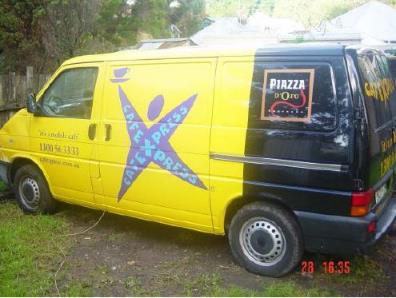
221 When Cafexpress first began supplying PIAZZA D’ORO coffee beverages, the packaging was in this form:
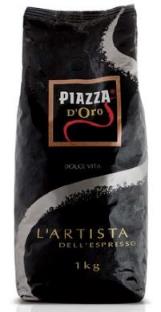
222 The packaging has been changed relatively recently:
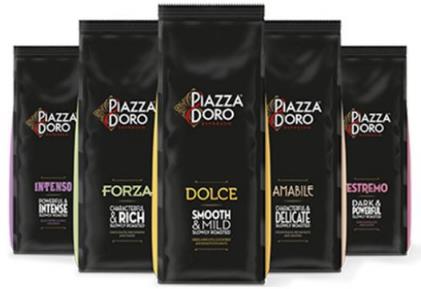
223 Lavazza adduced evidence of a webpage for a business called Coffee Lovers. A screenshot of the webpage, taken on 9 December 2002, indicates that, as at that date, the business, which apparently operated in Queensland, supplied coffee, coffee machines, coffee roasters, and coffee accessories through online and telephone sales. The screenshot shows that Coffee Lovers offered a blend of coffee called the COSTA D’ORO blend.
224 On 9 August 2001, Sara Lee/DE NV applied to register the mark TAZZA D’ORO. The mark was entered on the Register on 2 September 2004 as Trade Mark No. 885222 for various goods in Class 30, including “coffee”. There is no evidence that the mark was used. The mark was removed from the Register on 23 February 2012 for non-payment of the renewal fee.
225 On 28 June 2002, Swedish Match Cigars BV applied to register a composite mark which included the words CASA DEL ORO:
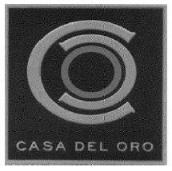
226 The mark was entered on the Register on 22 January 2003 as Trade Mark No. 926676 for various goods and services, including “coffee” in Class 30. There is no evidence that the mark was used. The mark was removed from the Register on 28 June 2013 for non-payment of the renewal fee.
227 On 20 November 2002, Coreco (Aust) Pty Ltd applied to register the mark STELLA D’ORO. The mark was entered on the Register on 24 December 2004 as Trade Mark No. 934942 for various goods in Class 30, including “coffee”. There is no evidence that the mark was used.
228 On 28 March 2003, Koninklijke Douwe Egberts BV applied to register a composite mark which included the words PIAZZA D’ORO:
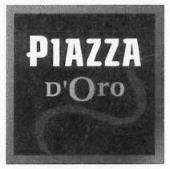
229 The mark was entered on the Register on 29 March 2004 as Trade Mark No. 963739 for various goods, including “coffee” in Class 30. This is the mark used by Cafexpress: see [220] – [221] above.
230 In 2003, Guy Thompson commenced a wholesale coffee distribution business which trades under the name CREMA D’ORO. This name is registered as a business name. A company associated with Mr Thompson—Thompson Management Consulting Pty Ltd (Thompson Management)—is the holder of that name. The business supplies coffee beans to commercial clients, including cafes and restaurants, throughout New South Wales. Some of the cafes include cafes owned or operated by Mr Thompson or one of his companies. The name CREMA D’ORO is also the name given by Mr Thompson to a coffee blend he created. This blend has received a number of awards.
231 On 16 October 2003, Mr Thompson’s wife, Virginia Thompson, applied to register a composite mark which included the words CREMA D’ORO:
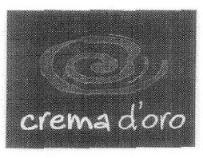
232 The mark was entered on the Register on 23 August 2004 as Trade Mark No. 974475 for “coffee” in Class 30, and certain services in Class 43. The mark was removed from the Register on 2 May 2014 for non-payment of the renewal fee. Mr Thompson’s evidence was that the non-payment of the renewal fee was an oversight and that this only came to his attention at the time he prepared his affidavit that was read in this proceeding.
233 Mr Thompson gave evidence that since at least 2007, Thompson Management has operated a website on which the trade mark CREMA D’ORO has been used. Mr Thompson also gave evidence that Thompson Management has used the trade mark on the packaging of CREMA D’ORO coffee beans; on coffee-related products such as espresso machine cleaners, ceramic cups and mugs; on invoices and business stationery, including business cards; and on outdoor café barriers.
234 On 3 March 2004, Sweets of Gold Pty Limited applied to register the mark DOLCI D’ORO. The mark was entered on the Register on 6 December 2004 as Trade Mark No. 991744 in respect of various goods in Class 30, including “coffee”. There is no evidence that the mark was used. The mark was removed from the Register on 17 September 2014 for non-payment of the renewal fee.
235 Lavazza adduced evidence of webpages for a business called Coffee Mio. Screenshots of the webpages, taken on 10 December 2004, 19 July 2008, 3 October 2008, and 25 October 2009, indicate that, as at those dates, the business, which operates in Victoria, supplied coffee of various blends, including blends called MIO D’ORO and BRAZIL ORO. A 500g pack of the MIO D’ORO blend (coffee beans) was purchased from the Coffee Mio website on 4 May 2020 and is in evidence:
|
|
|
236 A business called The Grind, which operates from five locations in Adelaide, supplies a blend of coffee called BRAZILIAN BLU ORO. It has been supplying the blend since 2005. Silvio Lombardi, who is one of the owners and operators of the business, gave evidence that The Grind uses various packaging for its coffee, which features The Grind’s logo and the name of the blend (there are various blends). He gave the following example:
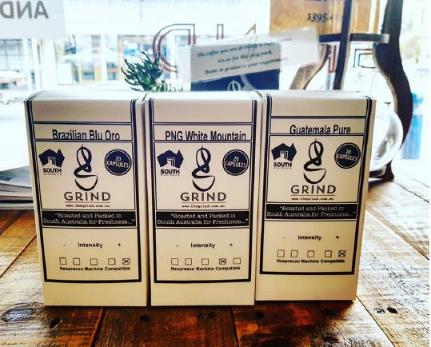
237 A 250g pack of beans said to have been purchased as the BRAZILIAN BLU ORO blend was purchased from the website for the business on 5 May 2020, and is in evidence. However, the pack does not bear the blend name.
238 On 23 August 2005, Primo Products Pty Ltd applied to register a composite mark which included the words PRIMO CAFFE TAZZA D’ORO and 100% ARABICA COFFEE; CAPPUCCINO, AFFAGATO, ESPRESSO LATTE:
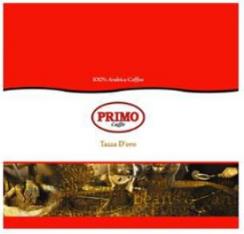
239 The mark was entered on the Register on 4 April 2006 as Trade Mark No. 1071434 for “coffee” in Class 30. The mark was removed from the Register on 8 March 2016 for non-payment of the renewal fee.
240 Lavazza has adduced evidence of screenshots of webpages for a business called Complete Coffee Pty Ltd, which operates in New South Wales, and a business called Primo Caffe. The webpages advertise the Primo Caffe coffee product range, including a blend called TAZZA D’ORO. A number of the screenshots of the webpages are undated. However, some are dated (23 August 2009; 19 February 2011; 17 March 2012; 22 March 2012; 21 June 2012; 17 August 2012; 18 August 2012; 13 April 2013; and 11 August 2013) and show the TAZZA D’ORO pack. An example is:
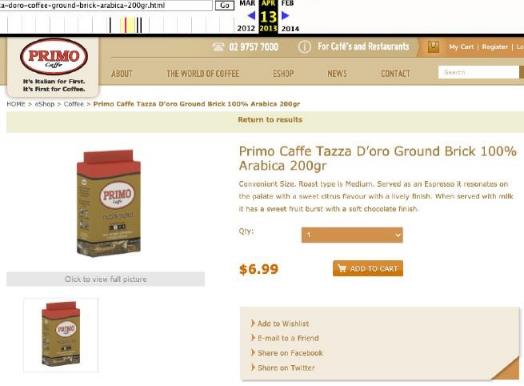
241 A 1 kg pack of TAZZA D’ORO (coffee beans) was purchased from the Primo Caffe website on 4 May 2020. An image of the product is in evidence:
|
|
|
|
242 On 27 March 2007, Miscela D’Oro SpA applied to register a composite mark which included the words MISCELA D’ORO:

243 The mark was entered on the Register on 11 February 2008 as Trade Mark No. 1200041 in respect of various goods in Class 30, including “coffee”.
244 Caffè Trombetta (Australia) Pty Ltd (Caffè Trombetta Australia) commenced business in Melbourne in 2008 supplying products and services to the Melbourne café, restaurant and European grocery market. The products it supplies are manufactured by the Italian company Caffè Trombetta SpA, which was established in Rome in 1890 by Vittorio Trombetta.
245 Caffè Trombetta Australia sells a range of coffee products including coffee beans and ground coffee in six different blends. One of the blends is CAFFÈ TROMBETTA ORO. Caffè Trombetta Australia has been supplying this blend since 2008. It is one of the company’s top three selling blends by volume. The blend is sold as coffee beans, ground coffee, and coffee capsules.
246 The packaging for CAFFÈ TROMBETTA ORO coffee beans is:
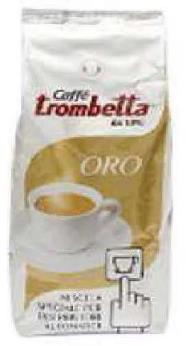
247 The packaging for CAFFÈ TROMBETTA ORO ground coffee is:
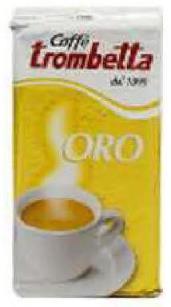
248 The packaging for CAFFÈ TROMBETTA ORO coffee capsules is:
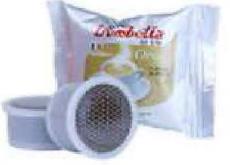
249 A 250g pack of CAFFÈ TROMBETTA ORO ground coffee was purchased on 4 May 2020. An image of the product is in evidence:
|
|
| ||
|
|
| ||
250 A 1 kg pack of CAFFÈ TROMBETTA ORO coffee beans was purchased on 8 December 2020. An image of the product is in evidence:
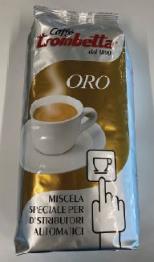
251 There is also evidence before me of a package in the same form having been purchased much earlier on 12 April 2011.
252 On 27 August 2010, Sara Lee Coffee and Tea France applied to register the mark L’ORO ESPRESSO. The mark was entered on the Register on 22 July 2011 as Trade Mark No. 1394827 for various goods in Class 30, including “coffee” and “packaged coffee”. The registration was cancelled on 8 September 2011 at the request of the International Bureau.
253 As at 28 March 2011, Caffe D’Italia Pty Ltd supplied a blend of coffee in Australia called CAFÉ MAURO ORO. A 250g pack of CAFÉ MAURO ORO ground coffee was purchased on this date. An image of the pack, as purchased, is in evidence:
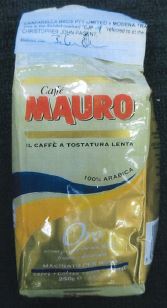
254 As at 28 March 2011, Crown Coffee International Pty Ltd (which traded as Casa & Bottega) supplied a blend of coffee in Australia called CAFÉ EL MUNDO MOKA ORO.
255 As at 28 March 2011, Global Coffee Solutions Pty Ltd supplied a blend of LÁ ZUMBA coffee in Australia called ZUMBA ORO. A 1 kg bag of LA ZUMBA ZUMBA ORO was purchased on this date. An image of the pack, as purchased, is in evidence:
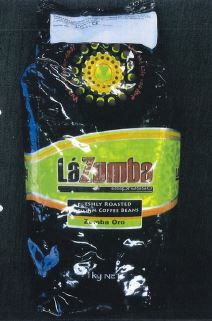
256 As at 30 March 2011, Casa Italia Gourmet Food and Wines supplied a blend of CAFFE INCAS coffee in Australia called ORO GOLD BLEND. A 1 kg pack of ORO GOLD BLEND was purchased on this date. An image of the pack, as purchased, is in evidence:
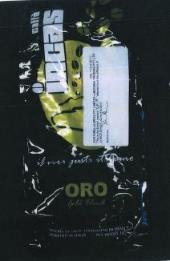
257 As at 28 April 2011:
(a) a business called Espresso Essential offered (on its website) to supply coffee beans in Australia called EL PRIMO D’ORO;
(b) Cadonite Pty Ltd offered (on its website) to supply coffee beans roasted by Miscela d’Oro SpA;
(c) a business called Mokador Direct offered (on its website) to supply in Australia a blend of Mokador brand ground coffee called ORO. A 250g pack of this product was purchased on 28 April 2011. An image of the product, as purchased, is in evidence. The packaging itself does not appear to include the word ORO:
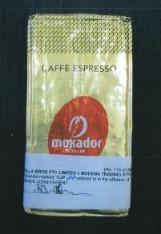
(d) P & T Basile Pty Limited (trading as Basile Imports) offered (on its website) to supply in Australia a blend of Caffe Camardo brand coffee called ESPRESSO ORO;
(e) Arte Antica International Pty Ltd (trading as Coffee n’ Coffee) offered (on its website) to supply in Australia a blend of Caffe Per Bar brand coffee called GOCCIA D’ORO.
258 As at 24 May 2011, Gulli Food Distributors Pty Ltd offered (on its website) to supply in Australia a blend of Caffe Giuglielmo brand coffee called ESPRESSO ORO.
259 On 29 September 2011, Camardo SpA applied to register a composite mark which included the words CAFFÈ CAMARDO and ESPRESSO ORO:
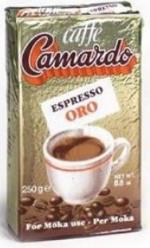
260 The mark was registered on 13 October 2014 as Trade Mark No. 1451349 for goods in Class 30, including “coffee” and “coffee beans”. There is no evidence that the mark was used.
261 Lavazza adduced evidence of webpages for a business called Caffè Bianchi. Screenshots taken as at 20 April 2013 and 9 May 2013 show that Caffè Bianchi offered to supply a blend of coffee called MISCELA D’ORO.
262 Lavazza adduced evidence of a number of uses in Australia in the period May to June 2020 of “oro” and “d’oro” on the packaging of the coffee of other traders. Typically, but not universally, the use of “oro” or “d’oro” was in conjunction with other words, such as “tazza”, “costa”, “bella”, “crema” and “nero”, or with respect to bean type, such as “Arabica”. In each case, the words “oro” or “d’oro” are clearly visible on the packaging.
263 I do not propose to descend to the detail of this evidence. In light of the conclusions to which I have come, I do not regard this evidence to be of probative value to the issues raised in this proceeding.
Earlier litigation involving the ORO word mark
264 This case takes place against the background of earlier litigation which Cantarella brought against Modena for infringement of the 098 mark and another registered trade mark—Trade Mark No. 878231 (the 231 mark) comprising the words CINQUE STELLE in class 30 for “Coffee, coffee essences and coffee extracts; coffee substitutes; and extracts of coffee substitutes’ coffee-based drinks; tea, tea extracts and tea-based drinks; cocoa, cocoa-based preparations and drinks” (the Modena proceeding). Cantarella advanced other causes of action against Modena (for contravention of the Trade Practices Act 1974 (Cth) and the Australian Consumer Law, and for passing-off). It is not necessary for me to dwell on the fate of these causes of action.
265 Cantarella established infringement of the two marks: Cantarella Bros Pty Ltd v Modena Trading Pty Ltd [2013] FCA 8; 299 ALR 752 (Cantarella (PJ)). Modena failed in its defence that it had not used the two marks as trade marks and had only used the words “oro” and “cinque stelle” in good faith to indicate the characteristics of the coffee products the subject of the infringements.
266 Modena also failed in its cross-claim that the registrations of the two marks should be cancelled on the ground that, with reference to s 41 of the Act in its then form, the marks were not capable of distinguishing Cantarella’s goods from the goods of other persons. (It is to be understood that, when referring to Cantarella’s “goods” and the “goods” of other persons, I am referring to the registered goods.)
267 Modena also brought a cross-claim seeking an order that the two marks be removed from the Register on the ground of non-use. It is not necessary for me to dwell on this aspect of the cross-claim beyond noting that it failed.
268 In relation to its allegation that the two marks were not capable of distinguishing Cantarella’s goods from the goods of other persons, Modena contended that, as words, “oro” and “cinque stelle” were not inherently adapted to distinguish Cantarella’s goods.
269 One plank in Modena’s case was that, based on data sourced from the Australian Bureau of Statistics, there were many Italian speakers or persons of Italian ancestry in Australia who would understand that “oro” and “cinque stelle” mean, respectively, “gold” and “five stars”.
270 Modena argued that, just as the English translations of the words—“gold” and “five stars”, respectively—would not be registrable as trade marks for the registered goods, so too the Italian words would not be registrable. This was because both the Italian words, and their English translations, were laudatory terms and, therefore, descriptive expressions that were incapable of indicating a connection in the course of trade between Cantarella and those goods.
271 At [117] and [118], the primary judge held:
117 It may be clear enough to an Italian speaker that Cinque Stelle signifies five stars and that Oro signifies some connection with gold. However, neither Cinque Stelle nor Oro means anything in English. While an educated English speaker, with some knowledge of Romance languages, or Latin, may well be able to deduce those meanings, I am not persuaded that any more than a very small minority of English-speaking people in Australia would understand the allusions made by Cinque Stelle and Oro. Modena relies on the census evidence summarised above in support of its proposition that there are sufficient numbers of Italian speakers in Australia to render the common meaning of Cinque Stelle and Oro sufficiently well understood in Australia. I am not persuaded, on the material before me, that the Italian language is so widely spread that the conclusion should be drawn that Cinque Stelle and Oro would be generally understood in Australia as having those meanings.
118 I consider that both Cinque Stelle and Oro are sufficiently inherently adapted to distinguish goods of Cantarella from goods of other persons. That is to say, the Italian words are not so obvious to ordinary English speaking persons in Australia that Cinque Stelle and Oro have a specific meaning. I am satisfied that Cinque Stelle and Oro are capable of distinguishing Cantarella’s goods from the goods of other persons. Accordingly, Modena has not established a basis for cancelling either of the trade marks under s 88 of the Trade Marks Act.
272 Another plank in Modena’s case (as to why the two marks were not inherently adapted to distinguish Cantarella’s goods from the goods of other persons) was summarised by the primary judge (at [103]) as follows:
103 Alternatively, Modena also relies on … the proposition that there is significant and extensive use of Oro on the packaging of coffee products by persons other than Cantarella, thus indicating that Oro is not inherently adapted to distinguish the Italian-style coffee products of Cantarella. Modena says that Oro and Cinque Stelle are words that other traders might, without improper motive, want to use as varietal indicators on their Italian-style coffee products. It says that a broad range of businesses use five star or 5 star in their business names. The word oro is used extensively in relation to coffee by other traders. Accordingly, traders such as Modena should be free to use gold and five star, and the Italian translations of those words.
273 At [106], the primary judge noted:
106 Modena says that the evidence demonstrates that Oro and Cinque Stelle are commonplace words in marketing generally and are commonplace words in the marketing of Italian-style coffee in Australia. Molinari was using the words before Cantarella and has used them continuously in Italy since 1996 and 1998 respectively. Therefore, Modena says, s 41(5) simply cannot have any application.
274 At [114], the primary judge again referred to Modena’s contention based on the use of “oro” and “cinque stelle” by other suppliers and distributors of coffee products in Australia. This reference was made in the context of noting, as well, Modena’s contention about the number of Italian speakers in Australia or persons of Italian ancestry who would understand “oro” to mean “gold” and “cinque stelle” to mean “five stars”. It is clear that, in reaching his conclusion at [118]—that both marks were capable of distinguishing Cantarella’s goods from the goods of other persons—the primary judge rejected both of Modena’s contentions. I draw attention to this finding because, in the present case, Lavazza submits that the primary judge’s analysis of s 41 in the Modena proceeding did not deal with the question of whether “oro” lacked capacity to distinguish “due to its commonality rather than its descriptiveness”. I do not accept that submission: see [409] below.
275 At [195] – [196], the primary judge concluded that injunctions against future trade mark infringement should lie, but that on the state of the evidence, damages for infringement should not be awarded. His Honour noted that no claim for an account of profits had been pressed. His Honour also concluded that Modena’s cross-claim challenging the validity of the registrations in suit should be dismissed.
276 Modena appealed to a Full Court of this Court against the dismissal of its cross-claim. The Full Court allowed the appeal: Modena Trading Pty Ltd v Cantarella Bros Pty Ltd [2013] FCAFC 110; 215 FCR 16. The primary judge’s findings of fact were not disturbed. However, at [49], the Full Court considered that, in rejecting Modena’s contention that, as words, “oro” and “cinque stelle” were not inherently adapted to distinguish Cantarella’s goods from the goods of other persons, the primary judge had adopted an approach that was “not apt to the present case”.
277 It is important to note that, in reaching that conclusion, the Full Court accepted that the general principle concerning whether a word mark is inherently adapted to distinguish is to be found in Kitto J’s statement in Clark Equipment Co v Registrar of Trade Marks (1964) 111 CLR 511 at 514 (Clark Equipment):
[T]he question whether a mark is adapted to distinguish be tested by reference to the likelihood that other persons, trading in goods of the relevant kind and being actuated only by proper motives—in the exercise, that is to say, of the common right of the public to make honest use of words forming part of the common heritage, for the sake of the signification which they ordinarily possess—will think of the word and want to use it in connexion with similar goods in any manner which would infringe a registered trade mark granted in respect of it.
278 In doing so, the Full Court rejected Modena’s contention that the correct test was to be found in an arguably wider statement of principle by Kitto J in FH Faulding & Co Ltd v Imperial Chemical Industries of Australia & New Zealand Ltd (1965) 112 CLR 537 (Faulding) which omitted reference to the following important parenthetical words used in Clark Equipment (see the quote immediately above):
… in the exercise, that is to say, of the common right of the public to make honest use of words forming part of the common heritage, for the sake of the signification which they ordinarily possess …
279 In rejecting Modena’s contention, the Full Court noted (at [67]) that Full Courts of this Court have consistently treated Kitto J’s statement in Clark Equipment as stating the general principle that informs the inquiry as to whether a word mark is inherently adapted to distinguish.
280 The Full Court noted (at [82]) that, in determining whether “oro” and “cinque stelle” were sufficiently inherently adapted to distinguish Cantarella’s goods from the goods of other persons, the primary judge had posited whether the Italian words were “commonly understood” or “generally understood” in Australia by “ordinary English speaking persons” as meaning “gold” and “five stars” respectively. The Full Court reasoned (at [83]) that this approach was “not appropriate”, and revealed “demonstrable error”, where “common Italian words descriptive of quality” are in issue.
281 At [85], the Full Court continued:
85 There is no necessity to approach the enquiry from an Anglocentric perspective in the Australian context which has rich cultural and ethnic diversities within its population. Adopting the language of Kitto J, to accommodate this reality in the marketplace, one may consider the relevant words against the collective diverse heritage. Viewed in that way, the “common heritage” here included that of traders in coffee products sourced from Italy. Such traders may well be Italian or local importers. They may be local distributors who have in mind the large Italian speaking population in Australia as well as other Australians who, when it comes to coffee, want something with an Italian look and feel. Much of this country’s coffee heritage in its language has its provenance in the Italian language e.g. caffè latte; cappuccino; affogato; caffè machiatto and espresso. It is evident that pure coffee in Australia is often associated with Italy and Italian coffee products.
282 Noting that distinctiveness is a question of fact involving contextual considerations, the Full Court said (at [88]):
88 It is unnecessary, in our opinion, that consumers know what the words mean in English. However, given that Italian is the second most spoken language in Australia, self-evidently many people in this country would in fact know what the words meant. Moreover, as the primary judge noted (at [86]), Cantarella explains on its packaging that “Oro” means “gold”. Many Italian speakers would have understood the words Cinque Stelle and Oro as common Italian laudatory and therefore descriptive words.
283 The Full Court concluded (at [103]) that, by applying Clark Equipment “in a way which is apt to this particular case”, “oro” and “cinque stelle” were not inherently adapted to distinguish Cantarella’s goods from the goods of other persons.
284 On the day that judgment was given by the Full Court (30 September 2013), Cantarella filed its application for the 290 mark. It provided evidence of its use of the ORO word mark. The application for the 290 mark proceeded to registration with an endorsement that evidence and/or other circumstances were provided under s 41(4) of the Act.
285 Cantarella was granted special leave to appeal to the High Court from the Full Court’s judgment. On appeal, the High Court, by majority (French CJ, Hayne, Crennan, and Kiefel JJ), found that, on the evidence that had been adduced in the proceeding, the 098 mark and the 231 mark were inherently adapted to distinguish Cantarella’s goods from the goods of other persons. Thus, the registrations of the 098 mark and the 231 mark were valid: Cantarella Bros Pty Ltd v Modena Trading Pty Ltd [2014] HCA 48; 254 CLR 337. In the following summary, I will concentrate on the majority’s findings and conclusions with respect to the 098 mark.
286 The majority recorded that the evidence at trial showed that coffee products were advertised, offered for sale, and sold by other traders in the coffee industry using composite marks that included “oro” as an Italian word, including in the form “d’oro”. The majority noted that “oro” is an Italian word meaning “gold”. The majority noted that “oro” is also a Spanish word meaning “gold”—both languages (being Romance languages) having derived the word “oro” from the Latin “aurum” (meaning, “gold”).
287 At [15], the majority said:
15 As in English, “gold” is used in Italian as a noun and has adjectival forms. Therefore, both the word “oro” and the form “d’oro” readily combine with other words to form composite trade marks, as in Cantarella’s registered trade marks “MEDAGLIA D’ORO” and “CHICCO D’ORO”. This can also be seen in examples of registered trade marks of numerous other registered proprietors in evidence at trial – “LAVAZZA QUALITA ORO plus device”, “CDO CASA DEL ORO plus device”, “PIAZZA D’ORO plus device”, “TAZZA D’ORO plus device”, “STELLA D’ORO” and “CREMA D’ORO plus device” – which are registered in respect of a variety of goods, including coffee. It was not contended that these registered composite marks, which included foreign words, were deceptively similar, whether visually, aurally or semantically.
288 After surveying various provisions of the Act, the majority said (at [22]):
22 The Act effected significant changes to Australian trade mark law: earlier legislation had specified the kinds of trade marks which were registrable; for the first time in Australia, the Act only specified the kinds of trade marks which were not registrable. However, it was common ground that the provisions of the Act which specify the applications for registration which must be rejected cannot be understood fully without some reference to the interpretation of provisions in the Trade Marks Act 1905 (Cth) (the 1905 Act) and the Trade Marks Act 1955 (Cth) (the 1955 Act) which specified the kinds of trade marks which were registrable. This is because the statutory language which gives rise to the question on this appeal has a well-understood provenance.
289 The majority noted Kitto J’s statement of principle in Clark Equipment and observed that the parenthetical words used by Kitto J were not only a particular focus of the argument before the Full Court, but a matter of dispute that was reiterated in the High Court.
290 At [28] and [29], the majority said:
28 Cantarella relied on the emphasised passage to support the proposition that the inherent adaptability of a trade mark consisting of a word (including a foreign word) is to be tested by checking the ordinary meaning (that is, the “ordinary signification”) of the word to anyone ordinarily purchasing, consuming or trading in the relevant goods, characterised by Cantarella as “the target audience”.
29 Modena asserted that the emphasised language was not essential to the test because Lord Parker of Waddington in Registrar of Trade Marks v W & G Du Cros Ltd stated the test in terms of the likelihood that other traders might legitimately desire to use the word in connection with their goods.
(Footnote omitted.)
291 The majority then referred to the legislative antecedents in the United Kingdom and in Australia to the present Act, in particular s 9(5) of the Trade Marks Act 1905 (UK) (on which s 16 of the Trade Marks Act 1905 (Cth) was based). Under that provision, a trade mark was registrable if it contained or consisted of at least one of certain “essential particulars” or was “any other distinctive mark”. A “distinctive” mark was defined to be a mark that was “adapted to distinguish the goods of the proprietor of the trade mark from those of other persons”. In determining whether a trade mark was so adapted, the extent to which a mark, in actual use, had been rendered “in fact distinctive” for the goods with respect to which it was registered or proposed to be registered, could be taken into account.
292 The majority then discussed the “trio of cases” constituted by In re Joseph Crosfield & Sons Ltd [1910] 1 Ch 130; In re California Fig Syrup Co [1910] 1 Ch 130; and In re H N Brock & Co Ltd [1910] 1 Ch 130. Their Honours also discussed In re R J Lea Ltd’s Application [1913] 1 Ch 446 and Registrar of Trade Marks v W & G Du Cros Ltd [1913] AC 624 (Du Cros). The majority quoted the statement in Lord Parker’s speech in Du Cros that the determination of whether a trade mark is “distinctive” for the purposes of s 9(5) of the Trade Marks Act 1905 (UK) should:
largely depend upon whether other traders are likely, in the ordinary course of their business and without any improper motive, to desire to use the same mark, or some mark nearly resembling it, upon or in connection with their own goods. It is apparent from the history of trade marks in this country that both the Legislature and the Courts have always shown a natural disinclination to allow any person to obtain by registration under the Trade Marks Acts a monopoly in what others may legitimately desire to use.
293 This is referred to as Lord Parker’s “other traders” test.
294 The majority identified two significant matters that emerged from these cases.
295 First, the majority noted (at [36] – [40]) that under s 9(5) of the Trade Marks Act 1905 (UK) the ordinary signification of a word affected whether the mark was registrable as a trade mark. If the ordinary signification of a word was: (a) directly descriptive of the goods; or (b) a laudatory epithet, used as an adjective in respect of the goods; or (c) a geographical name recognised as a place of manufacture or sale of the relevant goods; or (d) the phonetic equivalent of words that were directly descriptive of the goods; or (e) a mere surname (i.e., not represented in some distinctive style) that other traders might wish to use, then the word was not adapted to distinguish the goods of the proprietor from those of other persons.
296 In Du Cros it was held that the same result ensued under s 9(5) of the Trade Marks Act 1905 (UK) if the mark consisted of letters of the alphabet simply used as initials that other traders, without improper motives, might wish to use.
297 Secondly, the majority noted (at [41] – [44]) that, in considering whether a word mark was “adapted to distinguish” under s 9(5), it had been established that regard should be had to: (a) “the possible impairment of the rights of honest traders to do that which, apart from the grant of a monopoly, would be their natural mode of conducting business”; and (b) “the wider point of view of the public”.
298 The majority then noted (at [45]) that establishing the “ordinary signification” of a trade mark consisting of a word was just as critical for a word that is found in a dictionary of a foreign language. After discussing a number of cases, the majority said (at [48]):
48 These authorities show that it is not the meaning of a foreign word as translated which is critical, although it might be relevant. What is critical is the meaning conveyed by a foreign word to those who will be concerned with the relevant goods.
299 Further, the majority noted (at [50] – [52]) that there is a practical difference between a word mark that makes some “covert and skilful illusion” to the goods and a word having a “direct reference” to goods—the former being prima facie registrable (for example, the words TUB HAPPY in respect of cotton garments (Mark Foy’s Ltd v Davies Coop & Co Ltd (1956) 95 CLR 190 (Mark Foy’s)) or KIKU (a phonetic representation of the Japanese for chrysanthemum) in respect of perfume (Kiku Trade Mark [1978] FSR 246) and the latter being prima facie not registrable (for example, DIABOLO for “tops” (i.e., the toys) because it applied to a well-known game in England called “the devil on two sticks”: Philippart v William Whiteley Ltd [1908] 2 Ch 274).
300 The majority then discussed the provenance of the concept of a mark being “inherently adapted to distinguish” (the concept adopted in s 41 of the Act and s 26(2)(a) of the Trade Marks Act 1955 (Cth)) and the relationship of that concept to the ordinary signification of a word that is sought to be registered as a trade mark. The majority discussed Kitto J’s judgment Faulding before returning to his Honour’s statement of general principle in Clark Equipment which (at [57]) the majority described as an elaboration of the principle derived from Lord Parker’s speech in Du Cros. The majority also discussed Burger King Corporation v Registrar of Trade Marks (1973) 128 CLR 417, where Gibbs J applied Kitto J’s statement of general principle.
301 At [59], the majority said:
59 The principles settled by this Court (and the United Kingdom authorities found in this Court to be persuasive) require that a foreign word be examined from the point of view of the possible impairment of the rights of honest traders and from the point of view of the public. It is the “ordinary signification” of the word, in Australia, to persons who will purchase, consume or trade in the goods which permits a conclusion to be drawn as to whether the word contains a “direct reference” to the relevant goods (prima facie not registrable) or makes a “covert and skilful allusion” to the relevant goods (prima facie registrable). When the “other traders” test from Du Cros is applied to a word (other than a geographical name or a surname), the test refers to the legitimate desire of other traders to use a word which is directly descriptive in respect of the same or similar goods. The test does not encompass the desire of other traders to use words which in relation to the goods are allusive or metaphorical. In relation to a word mark, English or foreign, “inherent adaption to distinguish” requires examination of the word itself, in the context of its proposed application to particular goods in Australia.
302 The majority said (at [63]) that the Full Court considered, correctly, that the applicable principle to apply, in interpreting s 41(3) of the Act, was Kitto J’s statement in Clark Equipment.
303 At [70] and [71], their Honours said:
70 In accordance with the principles established in Mark Foy’s and restated in Clark Equipment, Faulding and Burger King, determining whether a trade mark is “inherently adapted to distinguish”, as required by s 41(3), requires consideration of the “ordinary signification” of the words proposed as trade marks to any person in Australia concerned with the goods to which the proposed trade mark is to be applied.
71 As shown by the authorities in this Court, the consideration of the “ordinary signification” of any word or words (English or foreign) which constitute a trade mark is crucial, whether (as here) a trade mark consisting of such a word or words is alleged not to be registrable because it is not an invented word and it has “direct” reference to the character and quality of goods, or because it is a laudatory epithet or a geographical name, or because it is a surname, or because it has lost its distinctiveness, or because it never had the requisite distinctiveness to start with. Once the “ordinary signification” of a word, English or foreign, is established an inquiry can then be made into whether other traders might legitimately need to use the word in respect of their goods. If a foreign word contains an allusive reference to the relevant goods it is prima facie qualified for the grant of a monopoly. However, if the foreign word is understood by the target audience as having a directly descriptive meaning in relation to the relevant goods, then prima facie the proprietor is not entitled to a monopoly of it. Speaking generally, words which are prima facie entitled to a monopoly secured by registration are inherently adapted to distinguish.
(Footnotes omitted.)
304 The majority found (at [72]) that the primary judge’s consideration of the ordinary significations of the words “oro” and “cinque stelle” accorded with settled principles, whereas the Full Court’s rejection of what it called an “Anglocentric” approach revealed a misunderstanding of the expression “ordinary signification” as it had been used in Australia and in the United Kingdom since at least 1905.
305 At [73] – [77], the majority held:
73 Both Modena in argument and the Full Court in its reasons misunderstood Lord Parker’s reference in Du Cros to the desire of other traders to use the same or similar mark in respect of their goods. Lord Parker was not referring to the desire of traders to use words, English or foreign, which convey an allusive or metaphorical meaning in respect of certain goods. What Lord Parker’s “other traders” test means in practice is well illustrated by the fate of the marks considered in Faulding, Clark Equipment and Burger King. Like “TUB HAPPY” in respect of cotton goods, “ORO” and “CINQUE STELLE” were not shown to convey a meaning or idea sufficiently tangible to anyone in Australia concerned with coffee goods as to be words having a direct reference to the character or quality of the goods.
74 The evidence, relied on by Modena at trial, did not show that “ORO” and “CINQUE STELLE” should not be registered as trade marks (and should be removed from the Register as trade marks) because their registration would preclude honest rival traders from having words available to describe their coffee products either as Italian coffee products or as premium coffee products or as premium blend coffee products.
75 The evidence led by Modena purporting to show that rival traders used (or desired to use) the word “oro” to directly describe their coffee products showed no more than that the word “oro” or the form “d’oro” had been employed on internet sites and coffee product packaging in respect of coffee products in a range of composite marks featuring Italian words which ostensibly were distinguishable aurally, visually and semantically. Further, the presence on the Register, before Cantarella’s trade mark “ORO” was registered, of another proprietor’s composite mark “LAVAZZA QUALITA ORO plus device” and Cantarella’s own composite mark “MEDAGLIA D’ORO” in respect of coffee products fell well short of proving that the word “oro”, standing alone, is understood in Australia by persons concerned with coffee products to be directly descriptive of the character or quality of such goods.
76 The evidence led by Modena to show that some traders in Australia used the expression “five star” on packaging of coffee and many traders used “five star” in respect of a range of services including restaurant and accommodation services also fell well short of proving that “cinque stelle” is understood in Australia by persons concerned with coffee products to be directly descriptive of the character or quality of such goods.
77 Modena’s complaint that the primary judge insufficiently considered the desires of rival traders to use the words “oro” or “cinque stelle” to directly describe their coffee goods was premised on a misconception that such was demonstrated by the evidence. The primary judge was right to reject Modena’s submission, based on the evidence, that honest traders might legitimately wish to use the words to directly describe, or indicate, the character or quality of their goods.
306 The reference in this quotation to “LAVAZZA QUALITA ORO plus device” is notable. It is a reference to the Lavazza device mark (depicted at [43] above) registered in the name of LL SpA.
307 In his dissenting judgment, Gageler J (at [80]) expressed his agreement with the Full Court’s “construction and application of s 41” of the Act. His Honour reasoned (at [84]) that the concept of a mark being inherently adapted to distinguish, which originated from s 9(3) of the Trade Marks Act 1938 (UK) and was first introduced in Australia in s 26(2)(a) of the Trade Marks Act 1955 (Cth), has always been treated as giving expression to the public policy that a trader ought not be allowed to obtain, by registration, a monopoly in what other traders may legitimately desire to use: Chancellor, Masters and Scholars of the University of Oxford v Registrar of Trade Marks (1990) 24 FCR 1. His Honour observed (at [85] – [86]) that this public policy was expressed in Lord Parker’s speech in Du Cros and was given “succinct authoritative expression” by Kitto J in Faulding.
308 In this connection, his Honour said (at [94]) that the test in Faulding:
is not exhausted by an inquiry into the intrinsic capacity of a word or other sign to acquire connotations which would in fact distinguish the goods or services of an applicant for registration from the goods or services of rival traders. … [T]he test is not exhausted by an inquiry into how the mark might be expected to be understood in Australia by “ordinary persons” or by actual or potential purchasers of goods or services of the relevant kind. The relevant perspective is, rather, that of another trader, located in Australia or elsewhere, who might desire to use the word or other sign in the ordinary course of its business.
309 Gageler J distinguished the “Faulding test” from the “Tub Happy test”, the latter being a reference to the decision in Mark Foy’s which concerned the criterion in s 16(1)(d) of the Trade Marks Act 1905 (Cth) (as amended by the Trade Marks Act 1912 (Cth)) that permitted registration of a mark containing or consisting of a word or words “having no direct reference to the character or quality of the goods, and not being according to its ordinary signification a geographical name or surname” (emphasis added). As to that criterion, Dixon CJ in Mark Foy’s said (at 195):
… The test must lie in the probability of ordinary persons understanding the words, in their application to the goods, as describing or indicating or calling to mind either their nature or some attribute they possess.
310 At [98], Gageler J said:
98 What is significant for present purposes is that a conclusion, based on the application of the Tub Happy test, that a word does not have direct reference to the character or quality of goods or services, is not itself a conclusion that the word is inherently adapted to distinguish the goods or services of the applicant from the goods or services of other persons. In the case of an ordinary English word, the considerations affecting each conclusion will often be similar. In the case of a technical word or a word in another language, other considerations will almost certainly arise.
311 At [100], his Honour said:
100 The Full Court held that his Honour erred in equating the F H Faulding test with the Tub Happy test, and in applying the latter to the exclusion of the former. That conclusion was correct. The central contention of the appellant (Cantarella) in this Court is that the two tests are the same. They are not.
(Footnote omitted.)
312 At this juncture, the following matters should be emphasised.
313 First, the appeal to the High Court in the Modena proceeding squarely raised the legal question: what is the correct test to be applied when determining, for the purposes of s 41 of the Act, whether a word mark is inherently adapted to distinguish? This was the same question raised in the intermediate appeal before the Full Court. As the majority in the High Court noted at [28] – [29], the battle lines were drawn up between the principle stated by Kitto J in Clark Equipment and the arguably broader principle stated by Lord Parker in Du Cros.
314 Secondly, the High Court held, by majority, that the correct test is the principle stated by Kitto J in Clark Equipment, including where the word mark is a foreign word. The Full Court reached the same conclusion, noting (at [67]) that Full Courts of this Court have consistently treated Clark Equipment as setting out the general principle. What emerges from the majority judgment in the High Court is that the Full Court in the Modena proceeding had misunderstood, and therefore misapplied, what Kitto J had said in Clark Equipment.
315 Thirdly, while Kitto J’s statement of general principle in Clark Equipment is derived from Lord Parker’s speech in Du Cros, it is an elaboration of what Lord Parker had said. The majority in the High Court in the Modena proceeding made clear that, in Australian trade mark law, Kitto J’s elaboration states the correct principle, not the arguably broader principle stated by Lord Parker.
316 Fourthly, and relatedly, the majority in the High Court rejected the case advanced by Modena, which was that, having regard to Lord Parker’s speech in Du Cros, the test of whether a word mark is inherently adapted to distinguish is the broadly-stated likelihood that other traders might legitimately desire to use the word in connection with their own goods.
317 Fifthly, in applying Kitto J’s statement of principle in Clark Equipment, the first step, which is crucial, is to establish the ordinary signification of the word or words (for which registration, as a trade mark, is or are sought) to all persons in Australia concerned with the goods. This involves a finding of fact based on the evidence before the Court.
318 As to the decision in Clark Equipment, it is important to note that Kitto J was specifically addressing the requirements of s 26 of the Trade Marks Act 1955 (Cth) in the context of s 25 of that Act.
319 Section 25 provided for the registration of a mark in (former) Part B of the Register if the mark was distinctive or, if not distinctive, if the mark was capable of becoming distinctive of the goods for which registration was sought, being goods with which the trade mark applicant was or might be connected in the course of trade.
320 At the relevant time, s 26(1) provided that a trade mark was not distinctive of the goods of a person unless it was “adapted to distinguish” the goods with which the applicant was or might be connected in the course of trade from goods which did not have that connection. Section 26(2) provided the following criteria for distinctiveness:
In determining whether a trade mark is distinctive, regard may be had to the extent to which—
(a) the trade mark is inherently adapted so to distinguish; and
(b) by reason of the use of the trade mark or of any other circumstances, the trade mark does so distinguish.
321 In Clark Equipment (at 513), Kitto J said that s 26(2) dissected the expression “adapted to distinguish” in s 26(1) into two inquiries—an inquiry concerning acquired distinctiveness (s 26(2)(b)) and an inquiry concerning “the inherent fitness of the mark for the purpose of distinguishing the applicant’s goods from those of other persons” (s 26(2)(a)). In that context, Kitto J said:
It is undeniable that a mark which, considered by itself, would seem unadapted to that purpose, because its natural signification is against a notion that goods to which it is applied are the goods of the applicant and of no one else, may yet come by actual use or by virtue of special circumstances to be so closely associated with the applicant's goods in the minds of the relevant public that its apparently disqualifying signification is effectually obscured, and distinctiveness in fact is thus achieved. But although such a measure of practical success with the mark may well provide a sufficient foundation for a passing-off action, the Trade Marks Act does not accept it as necessarily sufficient for the special protection which it affords to registered trade marks. True, the Act does not say that a mark which has any degree of natural unsuitability to distinguish an applicant’s goods shall be refused registration notwithstanding that it has acquired a degree of distinctiveness in relation to his goods; but it does require that if the mark is to any extent inherently unadapted for the purpose that fact shall be weighed in the scales against the degree of acquired distinctiveness in determining the ultimate question whether the mark is registrable as being “adapted to distinguish” the applicant's goods.
322 Three matters should be noted in this part of Kitto J’s judgment. First, his Honour was addressing, directly and as a matter of principle, the notion of a mark being “inherently adapted to distinguish” within the meaning of s 26(2)(a) as a step on the path to determining whether a mark is “adapted to distinguish” (within the meaning of s 26(1)). Secondly, his Honour saw that notion as referring to the “inherent fitness” of a word mark for registration as a trade mark. Thirdly, his Honour identified that a word’s “inherent fitness” for registration as a trade mark is tied to its “natural signification”.
323 It was in this context that Kitto J referred to, and quoted from, Lord Parker’s speech in Du Cros. By doing so, his Honour recognised the need, when considering whether a word is inherently adapted to distinguish, to take account of the desire of other traders to use the word in relation to the goods in respect of which the mark is registered or is sought to be registered. However, his Honour did not see this as some desire considered in the abstract. It was a desire conditioned on a particular need to use the word—namely, for its “natural” signification in relation to those goods.
324 Thus, when Kitto J came to apply those principles to the case at hand (an application for the registration of MICHIGAN—a word having a prima facie geographical signification in respect of particular types of earth-moving equipment) his Honour said (at 514 – 515):
It is well settled that a geographical name, when used as a trade mark for a particular category of goods, may be saved by the nature of the goods or by some other circumstance from carrying its prima facie geographical signification, and that for that reason it may be held to be adapted to distinguish the applicant's goods. Where that is so it is because to an honest competitor the idea of using that name in relation to such goods or in such circumstances would simply not occur: see per Lord Simonds in the Yorkshire Copper Works Case. This is the case, for example, where the word as applied to the relevant goods is in effect a fancy name, such as “North Pole” in connexion with bananas: A. Bailey & Co. Ltd. v. Clark, Son & Morland Ltd. (the Glastonbury Case) (see also the Livron Case), or where by reason of user or other circumstances it has come to possess, when used in respect of the relevant goods, a distinctiveness in fact which eclipses its primary signification. Cf. in the case of a descriptive word: Dunlop Rubber Co.’s Application. But the probability that some competitor, without impropriety, may want to use the name of a place on his goods must ordinarily increase in proportion to the likelihood that goods of the relevant kind will in fact emanate from that place. A descriptive word is in like case: the more apt a word is to describe the goods, the less inherently apt it is to distinguish them as the goods of a particular manufacturer. This may seem at first blush a paradox, as Lord Simonds and Lord Asquith suggested in the Yorkshire Copper Works Case, but surely not when Lord Parker's exposition of the subject is borne in mind.
(Footnotes omitted.)
325 Kitto J reasoned (at 515 – 516) that the name of a place or area can hardly ever be “adapted to distinguish” when used by itself, or with no addition except a description or designation of the goods, if goods of that kind are produced at that place or in that area, or if it is reasonable to suppose that the goods may be produced in that place or in that area. His Honour referred in particular to words that are the names of large and important industrial towns and districts, as well as smaller towns and districts if they are a seat of manufacture of the goods for which registration is sought. He concluded that MICHIGAN was such a word in respect of the goods for which registration was sought.
326 Subsequently, Kitto J undertook the same analysis in Faulding when considering the validity of the registration of BARRIER for “chemical substances prepared for use in medicine and pharmacy”. His Honour said (at 554):
… the word Barrier, unexceptionable though it may be as a trade mark for other kinds of chemical substances prepared for use in medicine and pharmacy, is, in its application to skin protective creams, one of that class of words which are “so apt for normal description that no trade mark use and momentary distinctiveness can justify a permanent monopoly”: Dunlop rubber Co.’s Application.
327 In explaining this conclusion, Kitto J observed (at 555) that it would not only be difficult but “surely impossible” to find that a word mark was distinctive when its “descriptiveness” referred to the distinguishing characteristic of a whole class of goods of which the trade mark owner’s goods are examples.
328 Although the mark in question had been registered under the Trade Marks Act 1905 (Cth), Kitto J’s analysis was directed also to the requirement of s 26(1)(a) of the Trade Marks Act 1955 (Cth) and hence whether BARRIER was inherently adapted to distinguish.
329 As to this, Kitto J said (at 555):
But for the evidence, it might have been said that the word, though inherently suited to be used adjectivally for the purpose of referring to the distinguishing characteristic of skin protective creams generally, is not one which would spring instantly to the mind of a person who wanted a word for the purpose but had never known Barrier to be so employed. This might have been said with the general principle in mind that the question to be asked in order to test whether a word is adapted to distinguish one trader’s goods from the goods of all others is whether the word is one which other traders are likely, in the ordinary course of their businesses and without any improper motive, to desire to use upon or in connexion with their goods: Registrar of Trade Marks v W. & G. Du Cros Ltd; Eclipse Sleep Products Inc. v The Registrar of Trade Marks; Clark Equipment Co. v Registrar of Trade Marks. But the evidence shows clearly, and it satisfied the learned primary Judge, that Barrier has long appealed to persons in industry, in pharmacy and in allied occupations as meeting their need for a word to describe succinctly and yet exactly the essential characteristic of protection which distinguishes the whole of the relevant class of creams.
(Footnotes omitted).
330 Kitto J then considered various aspects of the evidence, before concluding (at 556):
The conclusion seems inevitable that at least by the year of the initial registration of the appellant’s trade mark (1943) the word Barrier had caught on as a word peculiarly apt, according to its ordinary signification, for descriptive use in connexion with skin protective creams, so that any trader in such creams would be very likely indeed, in the ordinary course of business and without any improper motive, to desire to use the word in order to distinguish such creams in general from creams intended for other purposes.
(Emphasis added).
331 Kitto J’s analysis in Faulding makes plain that, when determining whether a word mark is inherently adapted to distinguish, any consideration of the desire of other traders to use the word for the goods or services in question is anchored in the word’s ordinary signification in respect of those goods or services. Hence, the emphasis given by the majority in the High Court in the Modena proceeding to the importance of determining, as a first step, the ordinary signification of the word.
Introduction
332 The case on infringement is based on s 120(1) of the Act:
(1) A person infringes a registered trade mark if the person uses as a trade mark a sign that is substantially identical with, or deceptively similar to, the trade mark in relation to goods or services in respect of which the trade mark is registered.
Note 1: For registered trade mark see section 6.
Note 2: For deceptively similar see section 10.
Note 3: In addition, the regulations may provide for the effect of a protected international trade mark: see Part 17A.
333 Cantarella’s case on infringement concerns the packaging of LAVAZZA QUALITÀ ORO coffee sold in Australia incorporating the “Perfect Pack” revisions to which I have referred. In its evidence and submissions, Cantarella refers to this packaging as the “2016 Product Packaging”. I note, however, that Simona Musso (LL SpA’s General Counsel) said that the “Perfect Pack” revisions were rolled out in 2017.
334 Cantarella’s case also concerns the “new” packaging of LAVAZZA QUALITÀ ORO coffee introduced in 2019 following the market research carried out by Lavazza in 2018: see [106] to [109] above. This packaging includes the packaging of the “Mountain Grown” sub-blend. In its submissions, Cantarella refers to this packaging as the “2019 Product Packaging” and, in the case of the “Mountain Grown” sub-blend, as the “2019 Mountain Grown Product Packaging”.
335 Further, Cantarella’s case concerns the packaging of the LAVAZZA QUALITÀ ORO NCCCs. I will refer to this as the NCCC Packaging.
336 When I refer to the 2016 Product Packaging, the 2019 Product Packaging, the 2019 Mountain Grown Product Packaging, and the NCCC Packaging in the context of infringement, I mean the 2016 Product Packaging, the 2019 Product Packaging, the 2019 Mountain Grown Product Packaging, and the NCCC Packaging as particularised by Cantarella in its second further amended statement of claim: see Schedule 1 to these reasons.
337 The issue that dominates the case on infringement is whether, in respect of the 2016 Product Packaging, the 2019 Product Packaging, the 2019 Mountain Grown Product Packaging, and the NCCC Packaging as particularised, Lavazza has used the word “oro” as a trade mark. There can be no question that if Lavazza has used the word “oro” as a trade mark on that packaging, then it has used the 098 mark and the 290 mark (i.e., the ORO word mark). Subject to Lavazza establishing that the registrations of the 098 mark and 290 mark are invalid, or that one or more of the defences on which it relies are made out, infringement will have been established.
338 In E & J Gallo Winery v Lion Nathan Australia Pty Ltd [2010] HCA 15; 241 CLR 144 (E & J Gallo Winery), the plurality in the High Court said (at [41]) that the concept of “use” of a trade mark must be understood in the context of s 17 of the Act, which provides:
17 What is a trade mark?
A trade mark is a sign used, or intended to be used, to distinguish goods or services dealt with or provided in the course of trade by a person from goods or services so dealt with or provided by any other person.
Note: For sign see section 6.
339 Although their Honours’ statement was made with respect to the “removal” provisions of the Act, the same consideration applies with respect to the “infringement” provisions of the Act.
340 The plurality explained (at [42] – [43]):
42 Whilst that definition contains no express reference to the requirement, to be found in s 6(1) of the Trade Marks Act 1955 (Cth), that a trade mark indicate “a connexion in the course of trade” between the goods and the owner, the requirement that a trade mark “distinguish” goods encompasses the orthodox understanding that one function of a trade mark is to indicate the origin of “goods to which the mark is applied”. Distinguishing goods of a registered owner from the goods of others and indicating a connection in the course of trade between the goods and the registered owner are essential characteristics of a trade mark. There is nothing in the relevant Explanatory Memorandum to suggest that s 17 was to effect any change in the orthodox understanding of the function or essential characteristics of a trade mark.
43 In Coca-Cola Co v All-Fect Distributors Ltd a Full Court of the Federal Court of Australia said:
Use “as a trade mark” is use of the mark as a “badge of origin” in the sense that it indicates a connection in the course of trade between goods and the person who applies the mark to the goods … That is the concept embodied in the definition of “trade mark” in s 17 — a sign used to distinguish goods dealt with in the course of trade by a person from goods so dealt with by someone else.
That statement should be approved.
(Footnotes omitted.)
341 More recently, in Self Care IP Holdings Pty Ltd v Allergan Australia Pty Ltd [2023] HCA 8; 408 ALR 195 (Self Care IP Holdings), the High Court said (at [23] – [24]):
23 Use of a trade mark in relation to goods means use of a trade mark upon, or in physical or other relation to, those goods, and so can include use of the mark on product packaging or marketing such as on a website. There is a distinction, although not always easy to apply, between the use of a sign in relation to goods and the use of a sign as a trade mark. A trade mark is a sign used, or intended to be used, to distinguish goods dealt with by one trader from goods dealt with by other traders; that is, as a badge of origin to indicate a connection between the goods and the user of the mark.
24 Whether a sign has been “use[d] as a trade mark” is assessed objectively without reference to the subjective trading intentions of the user. As the meaning of a sign, such as a word, varies with the context in which the sign is used, the objective purpose and nature of use are assessed by reference to context. That context includes the relevant trade, the way in which the words have been displayed, and how the words would present themselves to persons who read them and form a view about what they connote. A well known example where the use was not “as a trade mark” was in Irving’s Yeast-Vite Ltd v FA Horsenail (t/as The Herbal Dispensary), where the phrase “Yeast tablets a substitute for ‘Yeast-Vite’” was held to be merely descriptive and not a use of “Yeast-Vite” as a trade mark. Therefore, it did not contravene the YEAST-VITE mark.
(Footnotes omitted.)
342 In Anheuser-Busch Inc v Budejovický Budvar [2002] FCA 390; 56 IPR 182 (Anheuser-Busch), Allsop J said (at [185] – [186]):
185 The task is to examine the way the words are used in their context, including the totality of the packaging, to assess their nature and purpose in order to see whether they are used to distinguish the goods from goods of others: The Shell Co, supra at 422-25; Mark Foys Ltd, supra at 198-200; Johnson & Johnson Aust Pty Ltd v Sterling Pharmaceuticals Pty Ltd (1991) 30 FCR 326, 335, 342-45, 347-49; Pepsico Australia, supra at 162-63, 167-69 and 178-82; Musidor BV v Tansing (t/as Apple Music House) (1994) 52 FCR 363, 376-77; Koninklijke Philips Electronics NV v Remington Products Australia Pty Ltd (2000) 48 IPR 257, 265-66; and Aldi Stores, supra at [22] to [30] and [54] to [58].
186 The assessment is made from the perspective of what a person looking at the label would see and take from it, as to the purpose and nature of its use: The Shell Co, supra at 425; Wrigley's (Australasia) Ltd v Life Savers (Australasia) Ltd (1936) 37 SR (NSW) 9, 16; Aldi Stores, supra at [22] to [24] and [76].
343 In considering the way in which the words have been displayed, and how they would present themselves to persons who read them and form a view about what they connote, it is important to understand that the use of a word or words in relation to goods or services may function as a trade mark whilst nevertheless having a descriptive element.
344 In Johnson & Johnson Australia Pty Ltd v Sterling Pharmaceuticals Pty Ltd (1991) 30 FCR 326 (Johnson & Johnson), Gummow J noted (at 347 – 348):
When the issue is one of infringement, a pivotal question is whether the use complained of is use by the alleged infringer as a trade mark. The answer to that question requires an understanding of the “purpose and nature” of the impugned use: see Shell Company of Australia Ltd v Esso Standard Oil (Australia) Ltd (the Shell case) (1963) 109 CLR 407 at 426, per Kitto J. As his Honour there points out, with reference to Edward Young & Co Ltd v Grierson Oldham & Co Ltd (1924) 41 RPC 548, and as s 66 of the present Act also indicates, the nature of the allegedly infringing use may be considered in the light of a usage common in the relevant trade. The relevant context, where the mark is a word mark, includes a consideration of the way in which the word has been displayed in relation to the goods and advertisements of which complaint is made: see Mars GB Ltd v Cadbury Ltd [1987] RPC 387 at 402, per Whitford J.
Where the trade mark allegedly used by the defendant comprises ordinary English words (such as “Page Three”, considered by Slade J in News Group Newspapers Ltd v The Rocket Record Co Ltd [1981] FSR 89 at 102) then, as this decision illustrates, that circumstance may be taken into account by the court in the process of reasoning by which it accepts or rejects a submission that the use in question is not a trade mark use but a description of the goods in question. To say that is not to gainsay the point made by Dixon CJ in Mark Foys Ltd v Davies Coop and Co Ltd (the Tub Happy case) (1956) 95 CLR 190 at 194-195 that language is not always used to convey a single, clear idea; a mark may have a descriptive element but still serve as a badge of trade origin. However, where the issue is one of infringing use by use of a word mark (as in the present case), the fundamental question remains, to paraphrase what was said by Williams J in the same case (supra) (at 205), whether those to whom the user is directed are being invited to purchase the goods (or services) of the defendants which are to be distinguished from the goods of other traders “partly because” (emphasis supplied) they are described by the words in question.
345 In Woolworths Ltd v BP plc (No 2) [2006] FCAFC 132; 154 FCR 97 (Woolworths), the Full Court said (at [77]):
77 Whether or not there has been use as a trade mark involves an understanding from an objective viewpoint of the purpose and nature of the use, considered in its context in the relevant trade. How the mark has been used may not involve a single or clear idea or message. The mark may be used for a number of purposes, or to a number of ends, but there will be use as a trade mark if one aspect of the use is to distinguish the goods or services provided by a person in the course of trade from the goods or services provided by any other persons, that is to say it must distinguish them in the sense of indicating origin: see Shell Company of Australia Ltd v Esso Standard Oil (Australia) Ltd (1963) 109 CLR 407 at 422-425, the Caplets case, Musidor BV v Tansing (1994) 52 FCR 363, Coca-Cola Co v All-Fect Distributors Ltd (1999) 96 FCR 107 at 115-116 [19]-[20], Sports Break Travel Pty Ltd v P & O Holidays Ltd (2000) 50 IPR 51 at 57-58 [14], Koninklijke Philips Electronics NV v Remington Products Australia Pty Ltd (2000) 100 FCR 90 at 100-101 [12], Aldi Stores Ltd Partnership v Frito-Lay Trading Co Gmbh (2001) 54 IPR 344 at 353 [22]-[23] and 365 [76].
346 In the same vein, the High Court in Self Care IP Holdings said (at [25]):
25 The existence of a descriptive element or purpose does not necessarily preclude the sign being used as a trade mark. Where there are several purposes for the use of the sign, if one purpose is to distinguish the goods provided in the course of trade that will be sufficient to establish use as a trade mark. Where there are several words or signs used in combination, the existence of a clear dominant “brand” is relevant to the assessment of what would be taken to be the effect of the balance of the label, but does not mean another part of the label cannot also act to distinguish the goods.
(Footnotes omitted.)
347 In a given case there may be more than one sign which, in practical application, serves to distinguish, for trade mark purposes, particular goods or services. An example is provided by Johnson & Johnson where the word CAPLETS on the packaging of PANADOL and PANADEINE branded pharmaceutical products was found to function as a trade mark in its own right, independently of the other branding elements: see, for example, the remarks by Gummow J at 352 – 353.
348 In Anheuser-Busch, the respondent’s bottled beer product was branded BUDEJOVICKY BUDVAR. However, the label of the product also included the words BUDWEISER BUDVAR as part of the respondent’s corporate name. The use of BUDWEISER, in this particular context, was found by Allsop J to be an infringement of the applicant’s registered trade mark BUDWEISER. His Honour said (at [191]):
191 It is not to the point, with respect, to say that because another part of the label (the white section with ‘Budejovický Budvar’) is the obvious and important ‘brand’, that another part of the label cannot act to distinguish the goods. The ‘branding function’, if that expression is merely used as a synonym for the contents of ss 7 and 17 of the TM Act, can be carried out in different places on packaging, with different degrees of strength and subtlety. Of course, the existence on a label of a clear dominant ‘brand’ is of relevance to the assessment of what would be taken to be the effect of the balance of the label.
349 The decisions in Kolotex Glo Australia Pty Ltd v Sara Lee Personal Products (Australia) Pty Ltd (t/as Hilton Hosiery) (1993) 26 IPR 1 and Wellness Pty Ltd v Pro Bio Living Waters Pty Ltd [2004] FCA 438; 61 IPR 242 provide further examples of the use of multiple word marks functioning independently of one another as trade marks in relation to goods.
350 It follows that where multiple signs are used as trade marks, each sign functions in its own right as a “badge of origin” to denote trade source.
351 Cantarella draws attention to a number of features of the 2016 Product Packaging, the 2019 Product Packaging, the 2019 Mountain Grown Product Packaging, and the NCCC Packaging on which it relies to support its case on infringement and, in particular, Lavazza’s trade mark use of the word “oro”.
352 First, on this packaging the brand LAVAZZA is separated from the circular device of the previous packaging and placed at the top of the packaging, leaving the words “qualità oro” within the device centred on the packaging. This is in contrast to the previous packaging, where LAVAZZA was positioned inside the circular device. Cantarella submits that, so placed, the device functions as a “bullseye, target or spotlight” to immediately draw the eye of the viewer to the words within it.
353 Secondly, Cantarella submits that, within the circular device, the word “oro” is presented as “an attractive-looking symmetrical mark (a palindrome)” with the word represented:
(a) in a significantly larger font size compared to the word “qualità”;
(b) against a contrastingly coloured background; and
(c) in “shadowed” bold text which gives the word “a three-dimensional appearance … standing in relief from the plane of the package”.
354 Thirdly, Cantarella submits (with respect to products other than the capsule products) that, apart from being represented in a significantly smaller font size, the word “qualità” appears in a “plain” typeface similar to the typeface of the words “selezione premium” immediately above the word “qualità”, as well as the words and symbols “Torino, Italia, 1895” and “100% Arabica” also appearing on the face of the packaging. Cantarella contends that the relative location of “qualità” and “selezione premium” in this typeface forms a particular association between those words, which conveys a (descriptive) statement of quality.
355 Cantarella submits that, by these measures, two “distinct” marks appear on the packaging — LAVAZZA and ORO, with ORO “magnified”.
356 Although sharing these features, I note that there are differences between the 2016 Product Packaging, the 2019 Product Packaging, the 2019 Mountain Grown Product Packaging, and the NCCC Packaging.
357 First, the word “oro” in the 2016 Product Packaging is represented in a different font to the word “oro” on the 2019 Product Packaging, the 2019 Mountain Grown Product Packaging, and the NCCC Packaging. As Cantarella puts it, in the 2016 Product Packaging, “oro” is represented in a “unique typeface with an unusual tip on the top left of the letter ‘R’” against a contrastingly coloured background circle. In the 2019 Product Packaging, the 2019 Mountain Grown Product Packaging, and the NCCC Packaging, the word “oro” is also represented in a unique font. However, the font is different, with “oro” coloured red with white shadowing in the 2019 Product Packaging and the NCCC Packaging, and gold with white shadowing in the 2019 Mountain Grown Product Packaging.
358 Secondly, although in the 2019 Product Packaging, the 2019 Mountain Grown Product Packaging, and the NCCC Packaging the word “oro” is also set against a contrastingly coloured background, unlike the 2016 Product Packaging the background in the 2019 Product Packaging, the 2019 Mountain Grown Product Packaging, and the NCCC Packaging takes on the predominant colour of the packaging itself—gold in the case of the 2019 Product Packaging and the NCCC Packaging, and black in the case of the 2019 Mountain Grown Product Packaging.
359 Thirdly, in the 2019 Product Packaging and the NCCC Packaging, the word “qualità” is represented in “plain black or brown typeface”, which is the same colour as other descriptive wording on the packaging.
360 Fourthly, in the 2019 Mountain Grown Product Packaging, the word “qualità” is represented in “plain white typeface”, which is the same colour as other descriptive wording on the packaging.
361 Fifthly, the perimeter of the circular device in the 2019 Product Packaging, the 2019 Mountain Grown Product Packaging and the NCCC Packaging is represented differently to the perimeter of the circular device in the 2016 Product Packaging. Further, the words and symbols “selezione premium” and “100% Arabica” no longer appear as part of the circular device in the 2019 Product Packaging in the 2019 Mountain Grown Product Packaging. I observe that these words and symbols do not appear in the circular device used in the packaging of the capsule products, including the NCCC Packaging.
362 Sixthly, the ribbon device in the 2019 Product Packaging and the 2019 Mountain Grown Product Packaging that is associated with the circular device is represented differently to the corresponding ribbon device in the 2016 Product Packaging. Further, the ribbon device in the 2019 Product Packaging and the 2019 Mountain Grown Product Packaging contains the words “selezione premium”.
363 Seventhly, in the packaging for some of the capsule products, the circular device is not associated with a ribbon device: see, for example, the NCCC Packaging.
364 Eighthly, the box of the NCCC Packaging depicts a capsule with the word “oro” conspicuously printed on it in stylised script. The capsules inside the box are also printed conspicuously with the word “oro” in stylised script.
365 There are other minor differences that need not be mentioned.
366 Despite these differences, the 2016 Product Packaging, the 2019 Product Packaging, the 2019 Mountain Grown Product Packaging, and the NCCC Packaging conform to the general packaging layout and design concepts to which I have referred at [352] to [355].
367 Cantarella’s case is that the location and depiction of the word “oro” in the 2016 Product Packaging, the 2019 Product Packaging, the 2019 Mountain Grown Product Packaging, and the NCCC Packaging renders that word as the dominant feature of the packaging. Cantarella submits that, considered contextually and objectively, the word “oro” is being used, in this packaging, as a trade mark and therefore infringes the 098 mark and the 290 mark.
368 Lavazza submits, firstly, that, when the totality of the packaging of each example of the 2016 Product Packaging, the 2019 Product Packaging, the 2019 Mountain Grown Product Packaging, and the NCCC Packaging is considered, a retailer or a customer “could not fail to notice the dominant and distinctive LAVAZZA brand”, which “clearly indicates the commercial source of the product”. Lavazza argues that, in each case, LAVAZZA is the “headline brand” and that the words “qualità oro” play only a subsidiary role. As Lavazza puts it, “[e]ven if the eye forced onto ORO, it moves straight up to LAVAZZA at the top of the pack”.
369 Secondly, Lavazza accepts that, on this packaging, “oro” is represented in larger typeface than “qualità”. However, it contends that the word “oro” invariably appears as part of the phrase “qualità oro” such that there is “no basis to pretend that the word QUALITÀ is absent or invisible”.
370 It then argues that the evidence of LL SpA’s research in Germany, France, and Italy in March to April 2016 shows the consumers in Germany and France preferred packaging which includes the word “qualità”. Lavazza submits that this illustrates that the word “qualità” is “clearly noticeable to and read by consumers on the packaging” and is not an “unimportant” packaging element.
371 Thirdly, Lavazza submits that the question of infringing use should be considered in light of (what it says is) the common use by other traders of the word “oro” in relation to coffee products. As Lavazza puts it, “the common use by many coffee traders of ORO weighs further against a perception by customers or traders that the word ORO here identifies a unique brand of coffee”. Lavazza argues that consumers would see “ORO as a word common to the coffees across a number of clear brands … and in ways in which ORO does not function as a brand”.
372 Fourthly, Lavazza submits that retailers and customers would understand that LAVAZZA brand coffee products emanate from Italy. According to Lavazza, even a retailer or customer who speaks only English (and not Italian) is likely to equate the Italian word “qualità” with the English word “quality”. Therefore, a “reasonable and ordinary customer or retailer is likely to surmise that QUALITÀ ORO is an Italian reference to the quality of the product, whether or not they know that ORO denotes gold, or at least high-quality”: see also in that regard, paragraph 11(c) of Lavazza’s third further amended defence.
373 Fifthly, Lavazza submits that the LAVAZZA QUALITÀ ORO product has been presented to customers and retailers in Australia for many decades as a core variant within the range of LAVAZZA coffee products, such that the reference to “qualità oro” or simply “oro” on the impugned packaging will be perceived as denoting a variant within the LAVAZZA range: see also in that regard, paragraph 11(b) of Lavazza’s third further amended defence.
374 Sixthly, Lavazza submits that the word “oro”, as printed on the capsules within the box of the NCCC Packaging, cannot be a trade mark use of that word because “the individual capsules are contained within the packet until it is purchased and opened” and, therefore, “are not seen until after the purchase is complete”. According to Lavazza, this means that the capsules themselves are not “in the course of trade”. Therefore, the use of the word “oro” on the capsules themselves is not relevant to the infringement analysis.
375 Although I do not accept Cantarella’s submission that the representation of the word “oro” on the 2016 Product Packaging, the 2019 Product Packaging, the 2019 Mountain Grown Product Packaging, and the NCCC Packaging is the dominant feature of that packaging, I accept that it is one of the dominant features, along with the name LAVAZZA. I am persuaded that the use of the word “oro” on this packaging is trade mark use of the word, substantially for the reasons advanced by Cantarella.
376 As to Lavazza’s submissions, I accept that LAVAZZA is also used as a trade mark on the packaging. But this acceptance does not gainsay the fact that the word “oro”, as represented, is also used as a trade mark. I do not accept that, in this packaging, the word “oro” is used as part of a composite mark LAVAZZA QUALITÀ ORO. The word LAVAZZA and the word “oro” are functioning, independently, as trade marks on the packaging. Further, the fact that the use of LAVAZZA on the packaging might, itself, denote the trade source of the product does not mean that the word “oro” is not, independently, functioning as a trade mark.
377 Similarly, I do not accept that, in this packaging, the word “oro” is used as part of a composite mark QUALITÀ ORO. Whilst, on the packaging, the word “oro” is used in proximity to the word “qualità”, I do not accept that there is any necessary connection between the two words for trade mark purposes. In my view, for trade mark purposes, the two words function independently of each other, particularly given the different sizes and stylistic representations of the two words, with the word “oro” functioning as a trade mark. The word “qualità” is not functioning as a trade mark. Even if traders or customers were to associate the two words because of their proximity to each other on the packaging, it does not follow that the word “oro” is not functioning, in its own right, as a trade mark. As explained above, the existence of a descriptive element or purpose does not necessarily preclude the sign being used as a trade mark: [343] – [346] above.
378 Whilst it may be accepted that other traders have used the word “oro” in relation to their coffee products, this does not mean that the word “oro”, as represented in the impugned packaging, is not being used as a trade mark. (As an aside, the assumption that is implicit in Lavazza’s submission on common use of the word “oro” is that other traders have not used, or are not using, the word as a trade mark or as part of the trade mark on their own packaging. In my view, that assumption is not warranted.)
379 Further in this regard, I do not accept that mere common use of a particular word in a given trade means that the word is precluded from functioning as a trade mark in that trade. The circumstances and manner of use of the word in question are critical to determining whether trade mark use of the word is involved. In the present case, whilst background circumstances cannot be ignored, the focus must be on the way in which the word “oro” is used on the impugned packaging.
380 Further still, it is not to the point that customers and retailers in Australia understand from the use of the word “oro” on the impugned packaging that the products in question are a variant—even a core variant— within the LAVAZZA range of coffee products. The question is whether, on that packaging, the word “oro” is being used as a trade mark: Self Care IP Holdings at [25]; Woolworths at [77]; Johnson & Johnson at 347 – 348; see also Pinnacle Runway Pty Ltd v Triangl Ltd [2019] FCA 1662; 375 ALR 251 at [171] – [173]. In my view, it is.
381 Finally, I do not accept Lavazza’s submission that the use of the word “oro” on the capsules within the box of the NCCC Packaging is not use of that word in the course of trade. On the contrary, it is a plain use of that word in the course of trade and as a trade mark.
382 Therefore, Cantarella has established that the 2016 Product packaging, the 2019 Product Packaging, the 2019 Mountain Grown Product Packaging, and the NCCC Packaging, as particularised, are instances of use of the ORO word mark and, hence, infringements of the 098 mark and the 290 mark, unless Lavazza establishes that the registrations of the 098 mark and the 290 mark are not valid or that one or more of the defences to infringement under ss 122 and 124 of the Act exist.
383 I have considered, but refrained from summarising, at this point, a number of submissions made by the parties about LL SpA’s intention in developing its packaging in the way that led to the 2016 Product Packaging, the 2019 Product Packaging, the 2019 Mountain Grown Product Packaging, and the NCCC Packaging. It is sufficient for me to record and comment on the following matters only.
384 Cantarella’s submissions on trade mark use proceed on the basis that the increased prominence given to the word “oro” in that packaging (by removing LAVAZZA from the medallion device and increasing the size of “oro”) was undertaken by LL SpA to transform the word “oro” into a trade mark in its own right, independently of LAVAZZA. Cantarella submits that this intention supports a finding that, in fact, the word “oro” is used as a trade mark on the impugned packaging.
385 In this connection, it calls in aid the following observations of Dixon and McTiernan JJ in Australian Woollen Mills Ltd v F S Walton & Co Ltd (1937) 58 CLR 641 at 657:
… The rule that if a mark or get-up for goods is adopted for the purpose of appropriating part of the trade or reputation of a rival, it should be presumed to be fitted for the purpose and therefore likely to deceive or confuse, no doubt, is as just in principle as it is wholesome in tendency. In a question how possible or prospective buyers will be impressed by a given picture, word or appearance, the instinct and judgment of traders is not to be lightly rejected, and when a dishonest trader fashions an implement or weapon for the purpose of misleading potential customers he at least provides a reliable and expert opinion on the question whether what he has done is in fact likely to deceive. Moreover, he can blame no one but himself, even if the conclusion be mistaken that his trade mark or the get-up of his goods will confuse and mislead the public.
386 As the above passage makes clear, Dixon and McTiernan JJ were there referring to cases of commercially dishonest conduct in the context of the adoption of a trade mark that is calculated to mislead or deceive the public. The evidence in this case falls far short of that or any similar circumstance. In fairness to LL SpA, I should make clear that I make no such finding in relation to its adoption of the 2016 Product Packaging, the 2019 Product Packaging, the 2019 Mountain Grown Product Packaging, and the NCCC Packaging. My findings on the trade mark use of the word “oro” on this packaging are based solely on my objective appraisal of the packaging in question.
387 Relatedly, Cantarella relies on the findings of market research conducted in 2018 by LL SpA in Australia and Italy relating to (then) possible updated packaging for LAVAZZA QUALITÀ ORO. I note that this research, which also considered the introduction of the “Mountain Grown” sub-blend (see [106] above), was conducted after the introduction of the packaging changes brought about by the “Perfect Pack” project which led to the introduction of the 2016 Product Packaging. In other words, it was conducted after LL SpA removed LAVAZZA from the medallion device and increased the size of “oro” within that device.
388 As to this research, Cantarella points to a slide that records (apparently with respect to Australian consumers) that 54% of those surveyed considered the 2019 Product Packaging to be “Recognisable, stand out” and that 59% considered it to be “Simple easy to understand”. I place little weight on this evidence in coming to my findings on trade mark use. The survey findings were made in respect of the packaging as a whole. Cantarella seeks to rely on the survey results as if they were referable only to the use of the word “oro” on the packaging, and not to any other packaging element, including the brand LAVAZZA. That assumption is not warranted.
389 Cantarella also submits that it is open to the Court to find that LL SpA and Lavazza were aware of Cantarella’s trade mark rights in respect of the 098 mark and the 290 mark and appreciated, or ought to have appreciated, the risk of infringing those rights in Australia.
390 However, having advanced that contention, Cantarella accepts—indeed, advances—the proposition that, for the purposes of establishing infringement in Australia, Lavazza’s awareness, or lack of awareness, concerning the local consequences of LL SpA’s global rebranding are not relevant. I accept that submission.
391 Finally, contrary to the suggestion made in Lavazza’s submissions, it does not follow from the fact that Cantarella has not advanced a case on trade mark infringement in respect of the use in Australia of other or earlier packaging of LAVAZZA QUALITÀ ORO (for example, the packaging of the twin packs of LAVAZZA QUALITÀ ORO containing the ESTERO medallion) that trade mark use of the word “oro” is not established, on objective grounds, with respect to the 2016 Product Packaging, the 2019 Product Packaging, the 2019 Mountain Grown Product Packaging, and the NCCC Packaging.
The case on invalidity: no capacity to distinguish
Introduction
392 Sections 88(1)(a) and 88(2)(a) of the Act provide that the registration of a mark can be cancelled on any of the grounds on which the registration could have been opposed. Section 41, which is directed to a mark’s capacity to distinguish the trade mark applicant’s goods or services for which the mark is sought to be registered from the goods or services of other persons, is one such ground.
393 Section 41 of the Act (as it applies in relation to the validity of the 098 mark) provides:
41 Trade mark not distinguishing applicant’s goods or services
(1) For the purposes of this section, the use of a trade mark by a predecessor in title of an applicant for the registration of the trade mark is taken to be a use of the trade mark by the applicant.
Note 1: For applicant and predecessor in title see section 6.
Note 2: If a predecessor in title had authorised another person to use the trade mark, any authorised use of the trade mark by the other person is taken to be a use of the trade mark by the predecessor in title (see subsection 7(3) and section 8).
(2) An application for the registration of a trade mark must be rejected if the trade mark is not capable of distinguishing the applicant’s goods or services in respect of which the trade mark is sought to be registered (designated goods or services) from the goods or services of other persons.
Note: For goods of a person and services of a person see section 6.
(3) In deciding the question whether or not a trade mark is capable of distinguishing the designated goods or services from the goods or services of other persons, the Registrar must first take into account the extent to which the trade mark is inherently adapted to distinguish the designated goods or services from the goods or services of other persons.
(4) Then, if the Registrar is still unable to decide the question, the following provisions apply.
(5) If the Registrar finds that the trade mark is to some extent inherently adapted to distinguish the designated goods or services from the goods or services of other persons but is unable to decide, on that basis alone, that the trade mark is capable of so distinguishing the designated goods or services:
(a) the Registrar is to consider whether, because of the combined effect of the following:
(i) the extent to which the trade mark is inherently adapted to distinguish the designated goods or services;
(ii) the use, or intended use, of the trade mark by the applicant;
(iii) any other circumstances;
the trade mark does or will distinguish the designated goods or services as being those of the applicant; and
(b) if the Registrar is then satisfied that the trade mark does or will so distinguish the designated goods or services—the trade mark is taken to be capable of distinguishing the applicant’s goods or services from the goods or services of other persons; and
(c) if the Registrar is not satisfied that the trade mark does or will so distinguish the designated goods or services—the trade mark is taken not to be capable of distinguishing the applicant’s goods or services from the goods or services of other persons.
Note 1: For goods of a person and services of a person see section 6.
Note 2: Use of a trade mark by a predecessor in title of an applicant and an authorised use of a trade mark by another person are each taken to be use of the trade mark by the applicant (see subsections (1) and 7(3) and section 8).
(6) If the Registrar finds that the trade mark is not inherently adapted to distinguish the designated goods or services from the goods or services of other persons, the following provisions apply:
(a) if the applicant establishes that, because of the extent to which the applicant has used the trade mark before the filing date in respect of the application, it does distinguish the designated goods or services as being those of the applicant—the trade mark is taken to be capable of distinguishing the designated goods or services from the goods or services of other persons;
(b) in any other case—the trade mark is taken not to be capable of distinguishing the designated goods or services from the goods or services of other persons.
Note 1: Trade marks that are not inherently adapted to distinguish goods or services are mostly trade marks that consist wholly of a sign that is ordinarily used to indicate:
(a) the kind, quality, quantity, intended purpose, value, geographical origin, or some other characteristic, of goods or services; or
(b) the time of production of goods or of the rendering of services.
Note 2: Use of a trade mark by a predecessor in title of an applicant and an authorised use of a trade mark by another person are each taken to be use of the trade mark by the applicant (see subsections (1) and 7(3) and section 8).
394 Section 41 of the Act (as it applies in relation to the validity of the 290 mark) provides:
41 Trade mark not distinguishing applicant’s goods or services
(1) An application for the registration of a trade mark must be rejected if the trade mark is not capable of distinguishing the applicant’s goods or services in respect of which the trade mark is sought to be registered (the designated goods or services) from the goods or services of other persons.
Note: For goods of a person and services of a person see section 6.
(2) A trade mark is taken not to be capable of distinguishing the designated goods or services from the goods or services of other persons only if either subsection (3) or (4) applies to the trade mark.
(3) This subsection applies to a trade mark if:
(a) the trade mark is not to any extent inherently adapted to distinguish the designated goods or services from the goods or services of other persons; and
(b) the applicant has not used the trade mark before the filing date in respect of the application to such an extent that the trade mark does in fact distinguish the designated goods or services as being those of the applicant.
(4) This subsection applies to a trade mark if:
(a) the trade mark is, to some extent, but not sufficiently, inherently adapted to distinguish the designated goods or services from the goods or services of other persons; and
(b) the trade mark does not and will not distinguish the designated goods or services as being those of the applicant having regard to the combined effect of the following:
(i) the extent to which the trade mark is inherently adapted to distinguish the goods or services from the goods or services of other persons;
(ii) the use, or intended use, of the trade mark by the applicant;
(iii) any other circumstances.
Note 1: Trade marks that are not inherently adapted to distinguish goods or services are mostly trade marks that consist wholly of a sign that is ordinarily used to indicate:
(a) the kind, quality, quantity, intended purpose, value, geographical origin, or some other characteristic, of goods or services; or
(b) the time of production of goods or of the rendering of services.
Note 2: For goods of a person and services of a person see section 6.
Note 3: Use of a trade mark by a predecessor in title of an applicant and an authorised use of a trade mark by another person are each taken to be use of the trade mark by the applicant (see subsections (5) and 7(3) and section 8).
(5) For the purposes of this section, the use of a trade mark by a predecessor in title of an applicant for the registration of the trade mark is taken to be a use of the trade mark by the applicant.
Note 1: For applicant and predecessor in title see section 6.
Note 2: If a predecessor in title had authorised another person to use the trade mark, any authorised use of the trade mark by the other person is taken to be a use of the trade mark by the predecessor in title (see subsection 7(3) and section 8).
395 Despite the different forms of s 41 at play in this proceeding, a common consideration is whether (and to what extent), at the relevant time, each registered mark—the ORO word mark—was “inherently adapted to distinguish the designated goods or services from the goods or services of other persons”.
396 In its further amended statement of cross-claim, Lavazza pleads that the registrations of the 098 mark and the 290 mark should be cancelled under s 88(2)(a) and s 41 of the Act because, at the filing date of each registration, the word “oro” was not capable of distinguishing, and did not distinguish, Cantarella’s “coffee” from the “coffee” dealt with or provided by other persons. This is because “other persons had registered and/or used in Australia, and/or were continuing to use in Australia, and/or without any improper motive would desire to use in Australia the word ORO in respect of their coffee products”.
397 In other words, Lavazza contends that, because of this alleged fact, the ORO word mark is not to any extent inherently adapted to distinguish the goods for which it is registered, either as the 098 mark or the 290 mark.
398 The particulars to this allegation refer to coffee products that have been supplied in Australia under various names which include “oro” and “d’oro”. I have referred to this evidence at [35] – [263] above.
399 In opening, Lavazza referred to this as the “Du Cros point”: regardless of whether a word is “descriptive” (see below), it may lack an inherent capacity to distinguish simply because of its “commonality” (i.e., “it is likely to be used by numerous traders”): Transcript p 71, lines 27 – 30. In closing submissions, Lavazza elaborated on this point—“commonality”—which, it argued, was not before the High Court in the Modena proceeding.
400 Despite the obvious limitation of its pleading of the further amended statement of cross-claim—which, on this ground of invalidity, is directed only to a lack of inherent capacity to distinguish based on “commonality”—Lavazza also seeks to address the “descriptiveness” of “oro” in relation to the registered goods as an additional and separate reason why the marks are not inherently adapted to distinguish.
401 In this connection, Lavazza contends that a significant part of the Australian public would understand the ordinary signification of the word “oro” as a laudatory reference to “gold” and, therefore, to “premium quality”. In other words, Lavazza contends that the word “oro”, when used in relation to the registered goods, is no more than descriptive of the quality of the goods and, for that reason, has no inherent capacity to distinguish.
402 Despite the fact that the further amended statement of cross-claim does not plead Lavazza’s case on “descriptiveness”, it was addressed fully by the parties in submissions and I propose to consider and determine that case.
403 Lavazza submits that the test for whether a word mark is inherently adapted to distinguish is to be drawn from Lord Parker’s speech in Du Cros. Lavazza submits that this speech has been adopted by the High Court on numerous occasions, including in the Modena proceeding itself. According to Lavazza, “descriptiveness” is not the only factor that can deprive a trade mark of the inherent capacity to distinguish under the test established in Du Cros. A trade mark can lack an inherent capacity to distinguish by reason of its “commonality” rather than its “descriptiveness”.
404 Lavazza contends that, by the time of the High Court’s decision in Eclipse Sleep Products Inc v Registrar of Trade Marks (1957) 99 CLR 300 (Eclipse), Lord Parker’s test in Du Cros had been adopted, without qualification, by the High Court. It contends that, since that time, Du Cros has been “binding law in Australia” on the question of whether a trade mark is inherently adapted to distinguish.
405 Lavazza submits that Clark Equipment is to be understood as a case dealing only with a lack of inherent capacity to distinguish by reason of descriptiveness. According to this submission, nothing that was said by Kitto J in Clark Equipment trespasses on or denies the applicability of Du Cros in an appropriate case. As Lavazza puts it: (a) Lord Parker’s test in Du Cros does not only apply to descriptive terms; (b) nothing in Clark Equipment confines Lord Parker’s test to descriptive terms; and (c) Lord Parker’s test has not been supplanted by Kitto J’s “reformulation” in Clark Equipment.
406 Lavazza submits that, in the High Court’s later decision in Faulding, Kitto J (at 555), with whom Barwick CJ and Taylor and Windeyer JJ agreed, cited Du Cros, Eclipse, and Clark Equipment for the general principle that:
… the question to be asked in order to test whether a word is adapted to distinguish one trader’s goods from the goods of all others is whether the word is one which other traders are likely, in the ordinary course of their businesses and without improper motive, to desire to use upon or in connexion with their goods.
407 Lavazza submits that Faulding “ought to put it beyond any doubt that there is no material difference between the test as stated by Lord Parker in Du Cros and Kitto J’s reformulation of that test in Clark Equipment”.
408 Lavazza submits that nothing in the present Act (i.e., in s 41) alters the “ongoing authority of Lord Parker’s decision in Du Cros as adopted by the High Court”.
409 Lavazza submits, further, that the primary judge’s analysis of s 41 in the Modena proceeding did not deal with the question of whether “oro” lacked capacity to distinguish “due to its commonality rather than its descriptiveness” (noting what I have said above at [274], I do not accept that submission), and that his Honour made no reference to Du Cros.
410 Lavazza also submits that “the question of descriptiveness was fundamental to the Full Court’s reasoning” in the Modena proceeding. According to Lavazza, it was:
not necessary for the Full Court to consider any broader question of whether ORO lacked capacity to distinguish Cantarella’s coffee simply because it was, or might be, commonly used by numerous other coffee traders such that it could not distinguish one trader’s coffee from those other traders’ coffees – regardless of the question of descriptiveness.
411 Finally, Lavazza submits that the appeal to the High Court in the Modena proceeding:
determined the question of inherent adaptation to distinguish by reference to the narrow question of descriptiveness and did not consider the broader question of whether ORO lacked capacity to distinguish Cantarella’s coffee simply because it was commonly used by numerous other coffee traders and thus could not distinguish one trader’s coffee.
412 Lavazza submits that, in this proceeding, the Court ought to consider the “broader question” raised by Du Cros which was not considered in the Modena proceeding.
413 Lavazza’s invitation to consider the “broader question” is not an invitation that a judge at first instance can accept. Acceptance is foreclosed by the High Court’s decision in the Modena proceeding, which authoritatively decided that the correct test to apply when determining whether a word mark is inherently adapted to distinguish for the purposes of s 41 of the Act is the test stated by Kitto J in Clark Equipment, not the arguably broader “traders test” found in Lord Parker’s speech in Du Cros.
414 As I have noted above, the majority in the High Court in the Modena proceeding rejected the notion that a word mark will not be inherently adapted to distinguish simply because it is likely that other traders might legitimately desire to use the word in connection with their own goods. Lavazza’s argument on “commonality”—which it says is the “broader question” raised by Du Cros—is, in substance, the same argument rejected by the majority in the High Court.
415 I do not accept that the majority’s reasons for judgment can be read as accommodating the notion that the inquiry as to whether a word mark is inherently adapted to distinguish has, as it were, discrete strands, and that their Honours’ reasons were dealing with only one strand (a word’s “descriptiveness” when applied to the relevant goods), leaving undecided and untouched another strand (the desire of other traders to use the word, regardless of its descriptiveness) which, if established as a matter of fact, would be reason alone to deny that a word mark is inherently adapted to distinguish. As the majority explained, the desire of other traders to use the word in question is a function of the meaning that that word bears, according to its ordinary signification, in relation to the goods or services for which the mark is, or is sought to be, registered. Further, as I have endeavoured to explain above (at [326] – [331]), Kitto J was not positing a test in Faulding that was broader than the test he applied in Clark Equipment.
416 Faced with the prospect that I would reach this conclusion, Lavazza proffered another invitation—to depart from the authoritative decision of the High Court and follow the Full Court’s judgment and Gageler J’s judgment in the Modena proceeding. That, too, is not an invitation that a judge at first instance can accept.
417 As framed and advanced in closing submissions, this part of Lavazza’s case is based on Kitto J’s test in Clark Equipment and depends on Lavazza establishing that at the relevant time—24 March 2000 in the case of the 098 mark and 30 September 2013 in the case of the 290 mark—the word “oro” had an ordinary signification in relation to the registered goods.
418 In formulating the test in Clark Equipment, Kitto J referred to “the exercise … of the common right of the public to make honest use of words forming part of the common heritage, for the sake of the signification which they ordinarily possess”.
419 Relevantly to the present issue, two strands of thought emerge from this statement.
420 First, the word that is the subject of the inquiry must form part of the “common heritage”—meaning, the common stock of language that is available to be used: Apple Inc v Registrar of Trade Marks [2014] FCA 1304; 227 FCR 511 (Apple) at [11] cited with approval in Bendigo & Adelaide Bank Ltd v Community First Credit Union Ltd [2021] FCAFC 31; 389 ALR 196 at [64], Aldi Foods Pty Ltd v Moroccanoil Israel Ltd [2018] FCAFC 93; 261 FCR 301 at [13] and [126], Goodman Fielder Pte Ltd v Conga Foods Pty Ltd [2020] FCA 1808; 158 IPR 9 at [211], Urban Alley Brewery Pty Ltd v La Sirène Pty Ltd [2020] FCA 82 at [123], Bohemia Crystal Pty Ltd v Host Corporation Pty Ltd [2018] FCA 235; 354 ALR 353 at [93], Primary Health Care Limited v Commonwealth of Australia [2016] FCA 313; 117 IPR 73 at [14] and Buchanan Turf Supplies Pty Ltd v Registrar of Trade Marks [2015] FCA 756 at [28].
421 Kitto J’s reference to the “common heritage” makes clear that his Honour was referring to words that have been received into the stock of language that extends generally throughout the community, not merely to some part of it.
422 In the context of legislation that deals with the registrability of a trade mark, the common stock of language can only be the common stock of language that falls within the geographical operation of that legislation. As the operation of the Act extends to Australia, and the external Territories and other areas identified in s 4, that language is, relevantly, Australian English—in other words, the Australian lexicon.
423 Secondly, if the word is part of the “common heritage”, does it have a “signification”—in other words, a “meaning”—which can be characterised as one that the word “ordinarily” possesses as part of that language? This is what is captured by the notion of the “ordinary signification” of a word.
424 Bringing these strands together, for presently relevant purposes a word will have an “ordinary signification” if it has been received into Australian English and has a commonly understood and commonly shared meaning by ordinary members throughout the Australian community at large.
425 It is not uncommon for foreign words to be incorporated into a local language and bear an ordinary signification in this sense. Ready examples in the Australian lexicon are “encore”, “en route”, and “tour de force” from the French language, and “bravo” from the Italian language. This is confirmed by the fact that these foreign words have accepted dictionary meanings in Australian English: e.g., Macquarie Dictionary (8th ed, 2020); Applicant S1983 of 2003 v Minister for Immigration and Citizenship [2007] FCA 854 at [27].
426 However, the mere fact that a foreign word has been used, for example, in the course of trade in a particular locality—such as on the packaging of products supplied in that locality or in advertisements for such products— or might be associated in some way with a particular trader or the product of a particular trader—or, more broadly, associated with particular traders or the products of particular traders—does not mean that the word has thereby been incorporated into the language of the locality or that it has a commonly understood and shared meaning throughout the community at large. This is so even where a numerically significant number of people either know the meaning of the foreign word or can deduce its meaning. The Modena proceeding provides a convenient illustration of these propositions.
427 In that proceeding, the primary judge referred to the frequent use in Australia of the word “oro” in relation to coffee products. His Honour surveyed the evidence before him in which “oro” was included in sales and distribution materials and on the packaging of coffee that could be bought in various places in Australia: Cantarella (PJ) at [92] – [99]. He considered a submission that the evidence before him demonstrated that both “oro” and “cinque stelle” were commonplace words in marketing generally as well as commonplace words in the marketing of Italian-style coffee in Australia: Cantarella (PJ) at [106].
428 The primary judge also considered a submission that there were many people in Australia who understood the meaning of “oro” and “cinque stelle”, as well as the related submission that “oro” and “cinque stelle” would be understood in Australia as laudatory, and therefore descriptive, terms rather than indicating a connection in the course of trade between Cantarella and the products in question: Cantarella (PJ) at [102].
429 In this regard, the primary judge referred to the fact that, in submissions, Modena attached considerable significance to the fact that there were many Italian speakers in Australia, and the fact that other suppliers and distributors of coffee in Australia use the words “oro” and “cinque stelle”: Cantarella (PJ) at [114]. His Honour summarised the data of the Census conducted in 2001, and the Census conducted in 2006, by the Australian Bureau of Statistics concerning the number of people living in Australia who identified themselves as having been born in Italy; the number of people living in Australia who identified themselves as having Italian ancestry, either alone or in combination with other ancestry; the number of people living in Australia who spoke Italian at home; and the number of Italian-speaking people living in Australia who rated their ability to speak English as not well or not at all, or well or very well: Cantarella (PJ) at [115] – [116].
430 The primary judge accepted that, to an Italian speaker, “oro” signifies some connection with gold and “cinque stelle” signifies “five stars”. His Honour also accepted that an educated English speaker with some knowledge of Romance languages or Latin may be able to deduce those meanings for those words: Cantarella (PJ) at [117].
431 However, with reference to all the evidence before him, the primary judge was not persuaded that these meanings would be “generally understood in Australia”. Indeed, his Honour found that “oro” and “cinque stelle” did not mean anything in English. The Italian words were “not so obvious to ordinary English speaking persons in Australia” that they had a specific meaning. For that reason, the primary judge was persuaded that “oro” and “cinque stelle” were sufficiently inherently adapted to distinguish Cantarella’s goods from the goods of other persons: Cantarella (PJ) at [117] – [118].
432 On appeal, the Full Court relied on the evidence before the primary judge to reach the contrary conclusion. However, as I have noted, the majority of the High Court found that the Full Court had proceeded on an incorrect application of Kitto J’s test in Clark Equipment and a misunderstanding of the expression “ordinary signification” as it has been used in Australian and United Kingdom trade mark law since at least 1905. The majority held that, because coffee is a commodity and a familiar beverage consumed by many, the consideration of the “ordinary signification” of the words “oro” and “cinque stelle” in Australia undertaken by the primary judge accorded with settled principles: Cantarella (HC) at [72].
433 The above observations and remarks are directed to the general position, where the inquiry concerns the ordinary signification of a word referable to goods or services in a trade that involves the community at large. Different considerations may apply where the trade is more specialised and directed to, for example, those possessing special vocational or technical interests: see the observations of Dixon J in Howard Auto-Cultivators Ltd v Webb Industries Pty Ltd (1946) 72 CLR 175 at 184. It is, however, unnecessary for me to pursue these considerations in the present case.
434 Lavazza submits that, in the present case, there is a “different and larger” body of evidence before the Court which was not considered in the Modena proceeding (which concerned the 098 mark, not the 290 mark) and which, it argues, establishes that a significant part of the Australian public would understand the ordinary signification of the word “oro” as a laudatory reference to “gold” and, therefore, premium quality.
435 In this connection, Lavazza relies on:
(a) the use of the word “oro” by Lavazza and other traders prior to March 2000 and September 2013, as summarised above (see [35] – [264] above);
(b) the promotion of LAVAZZA QUALITÀ ORO by Lavazza and its distributors in conjunction with the English word “gold”;
(c) the permeation of the Italian language and Italian “coffee culture” in the Australian coffee market;
(d) the direct evidence of witnesses involved in the coffee trade in Australia (who did not give evidence in the Modena proceeding) to the effect that “oro” means “gold” and, when used in the coffee trade in Australia, is, on their understanding, a reference to quality; and
(e) census data that was not adduced as evidence in the Modena proceeding.
436 It is necessary to say something more about the evidence referred to in subparagraphs (d) and (e) above.
437 In closing submissions, Lavazza drew attention to 9 witnesses who gave evidence to the effect noted in subparagraph (d). Most of those witnesses were from Italian immigrant families, and spoke or understood Italian.
438 One witness, Mr Eveleens is of Dutch heritage and grew up in the Netherlands before migrating to Australia in 1987. Mr Eveleens does, however, speak Italian. He is also a director of the company that conducts the Cafexpress business which supplies PIAZZA D’ORO coffee beverages: see [220] – [222] above.
439 Another witness, Mr Fichera, is a director of Caffè Trombetta Australia which supplies CAFFÈ TROMBETTA ORO coffee as the distributor of the Italian coffee company Caffè Trombetta SpA, which was established in Rome in 1890: see [244] – [251] above.
440 Only two of the witnesses declared that they were not Italian speakers but, because of their involvement in the “coffee industry”, gained an understanding that “oro” in Italian means “gold” in English.
441 Lavazza also relies on the evidence given by Mr Bull, Lavazza’s Operations Manager, who said that, although he is not of Italian descent, he knows that “qualità oro” means “gold quality”. However, this understanding was gained from his experience “working with LL SpA and in the coffee industry”. Mr Bull did not say when he gained that understanding, but he commenced working for Lavazza in June 2015. Prior to that, he worked as the Group Supply Chain Manager for Valcorp for seven years (between September 2008 and June 2015). His employment before then was not in the “coffee industry”. Given his particular association with LL SpA, it is little wonder that Mr Bull has this understanding of the meaning of “qualità oro”.
442 I do not consider that the evidence noted in subparagraph (d) materially advances Lavazza’s case beyond the other evidence on which it relies.
443 As to the data referred to in subparagraph (e), the evidence before me includes data from the Censuses conducted by the Australian Bureau of Statistics in 1976, 1981, 1986, 1991, 1996, 2001, 2006, 2011, and 2016, and data from the Australian Bureau of Statistics 1985 Year Book. As I have noted, the data before the Court in the Modena proceeding was from the 2001 and 2006 Censuses.
444 The data before me not only includes data on persons who were, at the various times, speakers of Italian or who were born in Italy, but data on speakers of Spanish, French, Portuguese, or Romanian or who were born in Spain, France, Portugal or Romania, or in countries in which those languages are spoken. The rationale for adducing this evidence is that the words for “gold” in:
(a) Spanish are “oro” and “el oro”;
(b) French are “or” and “l’or”,
(c) Portuguese is “ouro”; and
(d) Romanian is “aur”.
445 Lavazza’s contention appears to be that it can be expected that foreign language speakers in this cohort might be expected to understand that the word “oro” means “gold”.
446 The data before me also includes data on persons who have ancestry in the countries to which I have referred or who have travelled to and from these countries.
447 Lavazza submits that the number of people who spoke these languages at home was over 500,000 as at 1986, 1991, 1996, 2001, 2006, and 2011 which, it points out, is a population equivalent to the State of Tasmania, or 1.5 times the population of the Australian Capital Territory, or more than twice the population of the Northern Territory.
448 Lavazza submits that, as at 1996, when Cantarella claims to have first commenced using the ORO word mark, over 1.6 million people in Australia had a parent who was born in a country in which one of these languages is spoken. It also points out that, during 1996, over 400,000 people in Australia travelled to and from one of those countries, with that figure rising to over 600,000 in 2001, over 800,000 in 2006, and over 1.1 million in 2011.
449 Whilst this evidence provides a more extensive data set than the data that was apparently before the Court in the Modena proceeding, I do not think that it adds materially to the proposition that there are many Italian speakers in Australia (a proposition which, I note, was accepted in the Modena proceeding: Cantarella (PJ) at [114]).
450 The data on speakers of Spanish, French, Portuguese, or Romanian adds only incrementally to the number of persons who might have an understanding of the meaning of “oro” when used in relation to the registered goods.
451 The data on persons who were born in, or who have ancestry in, or who have visited countries in which Italian, Spanish, French, Portuguese, or Romanian is spoken does not materially advance Lavazza’s case beyond the data on the number of speakers of those languages in Australia at relevant times.
452 Lavazza also relied on what it described as third party use of the word “gold” to “describe LAVAZZA QUALITÀ ORO”. Lavazza’s argument is that the use of the word “gold” by third parties to describe LAVAZZA QUALITÀ ORO is evidence that the word “oro” has (and had) an ordinary signification—namely, “gold”.
453 Some of this evidence refers to use of the word “gold” well after the dates of registration of the 098 mark and the 290 mark. All examples after 24 March 2000 and 30 September 2013 require careful treatment. Examples after 24 March 2000 cannot inform the question whether the ORO word mark, registered as the 098 mark, had an ordinary signification at the relevant time (and hence was not inherently adapted to distinguish Cantarella’s goods at that time). Examples after 30 September 2013 cannot inform the question whether the ORO word mark, registered as the 290 mark, had an ordinary signification at the relevant time (and hence was not inherently adapted to distinguish Cantarella’s goods at that time).
454 Lavazza also advances a case that, by 2000, it (perhaps meaning LL SpA) had “a very significant and valuable reputation in Australia for its LAVAZZA QUALITÀ ORO product that had been built up through sales, advertising and promotion for over 25 years”. Lavazza submits that Italian speakers and “Italian-familiar customers”, to whom advertising featuring the word “oro” alone is directed, would understand “oro” to mean “gold” or to be a reference to LAVAZZA QUALITÀ ORO coffee. It also submits that, by reason of the reputation of LAVAZZA QUALITÀ ORO coffee as at 2000, the Court could “readily infer … that among a not insignificant number of English-only speaking people in Australia, the meaning of the word ORO (alone) in the year 2000 was also likely to be understood as a reference to the QUALITÀ ORO product within the LAVAZZA range”.
Analysis
455 I commence by acknowledging that this aspect of Lavazza’s challenge to the validity of the registrations of the 098 mark and the 290 mark must be considered on the evidence presently before the Court.
456 In opening, Cantarella submitted that it is not open to the Court in the present proceeding to make any finding in relation to “the s 41 ground” which conflicts with the decision of the High Court in the Modena proceeding. It also submitted that Lavazza was “misguided” in relation to its s 41 ground and that Cantarella should be awarded indemnity costs should Lavazza persist with its challenge.
457 To the extent that these submissions contend that the finding by the majority in the High Court in the Modena proceeding that the word “oro” is inherently adapted to distinguish the goods for which it is registered in respect of the 098 mark from the goods of other persons (Cantarella (HC) at [78]) is binding on the parties in this proceeding, I reject the contention. It overstates the application of the doctrine of stare decisis on which Cantarella relies.
458 That said, I do accept Cantarella’s submission that the “new evidence” adduced by Lavazza in the present proceeding—I refer in particular to the evidence discussed at [436] – [451] above—is “more of the same type of evidence” that was before the High Court in the Modena proceeding.
459 Having regard to all the evidence on which Lavazza relies on this aspect of its challenge to the validity of the registrations of the 098 mark and the 290 mark ([435] above), I am not satisfied that Lavazza has established that, as at 24 March 2000 or as at 30 September 2013, the word “oro” was not inherently adapted to distinguish Cantarella’s goods from the goods of other persons.
460 Whilst I accept that, speaking generally, a numerically large number of persons in Australia might understand, by their knowledge of Italian or another Romance language, that the word “oro” means “gold” in English, I am far from persuaded that the evidence before me shows that, even at the present time, “oro” has been received into Australian English such that the ordinary signification of “oro” is “gold”. I am satisfied, therefore, that the word “oro” does not have an ordinary signification. It follows that I am not satisfied that, as at 24 March 2000 or as at 30 September 2013, the Australian public, at large, would have understood that the word “oro”, when used in relation to the registered goods, meant “gold”, or was a laudatory reference to “gold”, and, therefore, “premium quality”.
461 Lavazza’s case in this regard proceeds on the basis that it is sufficient for it to show that, at the relevant times, a numerically significant number of members of the Australian public had these understandings. Lavazza submits that the correct approach is to:
… take the class of Italian-speaking Australians who include those from Italy, those raised in Italian homes and also those who have studied or learnt Italian; it would also include to some degree those who have simply visited Italy. To that number would also be added persons falling into similar groups with the Spanish language. Then one would ask is that class of people a not insignificant, or substantial, number of people. The answer is Yes. Then one would ask whether ORO was the sort of word that would be known by most of that class. Put in that way, the answer must be Yes.
462 This is not the test in Clark Equipment, and it is not what is contemplated by the notion of a word’s ordinary signification as it applies in the present case.
463 As I have explained, to speak of a word as having an ordinary signification in the Australian lexicon is to speak of a word that has been received into Australian English and has a commonly understood and commonly shared meaning throughout the Australian community at large by ordinary members of that community—as the primary judge in the Modena proceeding put it, a meaning that would be “generally understood in Australia”. The evidence falls short of establishing that fact.
464 It is important to bear in mind that the trade in question in the present case is not confined to a specialised group. It is a trade that involves traders and members of the public comprising the Australian community at large.
465 Lavazza’s case in this regard is not advanced by arguing that, as at 24 March 2000 or even as at 13 September 2013, LAVAZZA QUALITÀ ORO had a significant reputation in Australia. The fact that a product might have a significant reputation does not mean that, where the name of the product includes a foreign word, members of the public at large understand the meaning of that word.
466 Similarly, the fact that in advertising or in commercial documents the word “gold” had been used to describe the LAVAZZA QUALITÀ ORO product, does not mean that, where used, “gold” stands as a translation of the “oro” component of the product name. The use of “gold” in most of the (relevant) examples raised by Lavazza is equivocal. More likely than not it has been used as a description of the LAVAZZA QUALITÀ ORO product by reference to its gold packaging, and nothing more.
467 In the examples where “oro” has been explicitly translated as “gold” it can be taken that the translation was provided because the word “oro” does not have a commonly understood and commonly shared meaning by ordinary members of the Australian community at large.
468 For these reasons, this aspect of Lavazza’s challenge under s 41 of the Act also fails.
Other matters
469 The parties raised a number of additional matters in submissions on this aspect of the case. In light of the findings I have made and conclusions to which I have come, it is now not necessary for me to deal with all those submissions. I will, nevertheless, briefly deal with the following matters.
470 First, Cantarella contends that Lavazza has not pleaded that it is an “aggrieved person” within the meaning of s 88(1) of the Act and that this is “fatal to Lavazza’s entire cross-claim under s 88(2)(a)”. I do not accept that contention. In any event, it is contrary to the position taken by Cantarella during the course of the trial when it indicated that it did not require Lavazza to amend the pleading of its cross-claim in order to apply for cancellation of the registrations of the 098 mark and the 290 mark: Transcript pp 138 – 139.
471 Secondly, Cantarella contends that, in relation to its challenge under s 41 of the Act, Lavazza cannot be an “aggrieved person” because its entire challenge is foreclosed by the High Court’s decision in the Modena proceeding. I do not accept that contention. Lavazza is plainly an “aggrieved person” in light of the fact that Cantarella has sued it on the basis of the registrations of the 098 mark and the 290 mark. Lavazza has a real interest in challenging the validity of those registrations and its challenge is not foreclosed by the High Court’s decision in the Modena proceeding.
472 Thirdly, Cantarella contends that the High Court’s finding in the Modena proceeding that the 098 mark is inherently adapted to distinguish necessarily means that the 290 mark is inherently adapted to distinguish. I do not accept that contention. The question of a mark’s capacity to distinguish within the meaning of s 41 of the Act must be considered at the time the application (here, each application) is made for registration of the mark.
473 Fourthly, Cantarella contends that Lavazza’s challenge to the 290 mark under s 41 of the Act faces the twin obstacles that: (a) the form of s 41 applicable to that challenge was introduced by the Intellectual Property Laws Amendment (Raising the Bar) Act 2012 (Cth) which enshrines the presumption of registrability; and (b) the application for registration of that mark was accepted under s 41(4) of the Act (Cantarella says, on the basis of acquired distinctiveness). As to the last-mentioned obstacle, Cantarella contends that Lavazza has not presented evidence to challenge that, at the priority date of the 290 registration, the ORO word mark was distinctive of Cantarella’s goods. This, Cantarella argues, is a complete answer to the s 41 challenge in relation to the registration of the 290 mark.
474 In raising these matters, Cantarella’s obvious intent is to contend that Lavazza’s challenge to the validity of the registrations of the ORO word mark faces additional difficulties in the case of the registration of the 290 mark which are not present in Lavazza’s challenge to the registration of the 098 mark.
475 Lavazza’s response is that numerous other traders both before and after the application for the 290 mark used the word “oro”, and that this should lead to the conclusion that, at the date of application, the 290 mark did not and could not distinguish Cantarella’s coffee from the coffee of other persons, having regard to the observation by Allsop J in Colorado Group Ltd v Strandbags Group Pty Ltd [2007] FCAFC 184; 164 FCR 506 at [136] (Kenny J and Gyles J agreeing at [30] and [35], respectively) that the fact of concurrent use may mean that the Court will not be persuaded that a mark is capable of distinguishing a trade mark applicant’s (or, as here, the registered owner’s) goods or services for the purposes of s 41 of the Act: see also Yarra Valley Dairy Pty Ltd v Lemnos Foods Pty Ltd [2010] FCA 1367; 191 FCR 297 at [256] – [257].
476 Lavazza also contends that Cantarella’s use of the ORO word mark is, and has been, accompanied by the VITTORIA house mark (which Lavazza calls “a proper trade mark”). According to Lavazza, the ORO word mark, in Cantarella’s hands, has been at best a “limping” trade mark which, as at 30 September 2013, had not acquired a capacity to distinguish.
477 The debate between Cantarella and Lavazza on this matter is arid. It cannot lead to any different outcome in this case.
478 To start with, the debate is directed only to the validity of the registration of the 290 mark and not to the validity of the earlier registered 098 mark.
479 Further, as a matter of broad analysis, all trade marks seeking registration can be considered as falling within one of three categories: (a) marks that are sufficiently inherently adapted to distinguish and are, therefore, capable of distinguishing in the relevant sense; (b) marks that are to some extent inherently adapted to distinguish but, without more, are not sufficiently inherently adapted to distinguish in the relevant sense; and (c) marks that are not to any extent inherently adapted to distinguish in the relevant sense and must rely on other criteria for registration.
480 Section 41, in the form in which it applies to the registration of the 290 mark, provides for only two circumstances when a trade mark is taken to be not capable of distinguishing in the relevant sense.
481 The first circumstance—covered by s 41(3)—is when the trade mark is not to any extent inherently adapted to distinguish. The application for registration of such a mark will only be rejected if the trade mark applicant has not used the trade mark before the filing date to such an extent that it can be concluded the trade mark does not, in fact, distinguish the designated goods or services, at the date of application, as being those of the trade mark applicant.
482 The second circumstance—covered by s 41(4)—is when the trade mark is to some extent, but not sufficiently, inherently adapted to distinguish in the relevant sense. The application for registration of such a mark will only be rejected if it is demonstrated that, at the date of application, the mark does not, and will not, distinguish in the relevant sense having regard to the combination of: (a) the extent to which the mark is inherently adapted to distinguish; (b) the use or intended use of the mark; and (c) “any other circumstances” leading to the conclusion that the mark does not, and will not, distinguish.
483 My finding that the word “oro”, in relation to coffee, did not have an ordinary signification as at 30 September 2013 carries with it the finding that, at that date, “oro” was sufficiently inherently adapted to distinguish Cantarella’s coffee from the goods or services of other persons. Therefore, s 41(3) and (4) do not have any practical application in the present case. The debate between Cantarella and Lavazza on this issue is unnecessary.
484 The debate between Cantarella and Lavazza on this issue also proceeds on a false basis. The registration of the 290 mark bears the endorsement: “Evidence and/or other circumstances provided under subsection 41(4)”. This means that the Registrar accepted the application for the 290 mark on the basis of evidence or other circumstances. However, this was in the context of the Full Court in the Modena proceeding having found that the word “oro” did have an ordinary signification in relation to coffee and that, as a mark, it was not inherently adapted to distinguish in the relevant sense. That finding was subsequently found by the majority in the High Court to be in error. What is more, it is not the finding I have made in this case.
485 Finally, strictly speaking it is not correct to say that the 290 mark was registered on the basis of acquired distinctiveness. The most that can be said is that, on the basis of the evidence filed by Cantarella to support its application for the 290 mark, the Registrar was not satisfied that s 41(4) (or, for that matter, s 41(3)) applied.
The case on invalidity: ownership
Introduction
486 As I have noted, ss 88(1)(a) and 88(2)(a) of the Act provide that the registration of a mark can be cancelled on any of the grounds on which the registration could have been opposed.
487 Section 58 of the Act provides:
58 Applicant not owner of trade mark
The registration of a trade mark may be opposed on the ground that the applicant is not the owner of the trade mark.
Note: For applicant see section 6.
488 In its further amended statement of cross-claim, Lavazza alleges that the registrations of the 098 mark and the 290 mark should be cancelled under s 88(2)(a) of the Act on the basis that, as of the filing date of each registration, Cantarella was not the owner of the ORO word mark because:
(a) Cantarella was not the first person to use, in Australia, the ORO word mark in respect of coffee; and
(b) the ORO word mark was not a trade mark that was capable of ownership for the purposes of s 58 of the Act.
489 The second contention is based on the proposition that the ORO word mark could not operate as a trade mark within the meaning of s 17 of the Act because other persons had used and were continuing to use it in Australia in relation to coffee products.
490 This proposition appears to be based, in turn, on Lavazza’s “commonality” point advanced in relation to its case under s 41 of the Act—namely that the ORO word mark is not to any extent inherently adapted to distinguish the goods for which it is registered, either as the 098 mark or the 290 mark. I say this because, for this contention, Lavazza relies on that part of the definition of “trade mark” in s 17 of the Act that refers to a trade mark being a sign used or intended to be used to distinguish goods or services by “a person” from the goods or services of “any other person”. It seems to me that the capacity to distinguish referred to in the definition of “trade mark” in s 17 cannot be read in isolation from the capacity to distinguish referred to in s 41. On this theory, Lavazza’s argument appears to be that if the word “oro” cannot function as a registered trade mark (because it is not inherently adapted to distinguish), it cannot be “owned” as a trade mark. If that is Lavazza’s case, it cannot succeed in light of my rejection of its case under s 41 of the Act based on the “commonality” point.
491 If, however, this is not Lavazza’s case, and it advances some freestanding contention to the effect that a person cannot “own” a trade mark that is a word mark because others also use, or might wish to use, or are likely to use, the word in question as a trade mark, then I reject the contention. It cannot be supported on orthodox trade mark principles.
492 The focus must be, therefore, on whether Lavazza has established that Cantarella is not the owner of the ORO word mark registered as the 098 mark or registered as the 290 mark because it was not the first person to use, in Australia, that trade mark in respect of coffee.
493 At common law it was recognised that, based on public use, a trade mark was a form of incorporeal property. Such property was, however, an adjunct of, and inseparable from, the goodwill of a business. Property in a trade mark could only be acquired by public use and, correspondingly, could be lost by disuse: General Electric Co (of USA) v General Electric Co Ltd [1972] 1 WLR 729.
494 Modern trade mark legislation recognises that ownership of a trade mark can be acquired even if the mark has not been used. Ownership of a mark that has not been publicly used rests on the combined effect of authorship of the mark; the intention to use the mark in relation to the goods or services for which registration is sought; and applying for registration.
495 The touchstone of ownership—whether of a mark that has been used or of a mark that is yet to be used—is local authorship: Pham Global Pty Ltd v Insight Clinical Imaging Pty Ltd [2017] FCAFC 83; 251 FCR 379 at [29]. Authorship is the origination or first adoption of the mark as and for a trade mark: Shell Co of Australia Ltd v Rohm & Haas Co (1949) 78 CLR 601 at 628.
496 As I have noted, Lavazza’s case is that Cantarella was not the first person to use the ORO word mark in Australia as a trade mark in relation to coffee.
497 In Moorgate Tobacco Co Ltd v Philip Morris Ltd (No 2) (1984) 156 CLR 414, Deane J said (at 432):
The prior use of a trade mark which may suffice, at least if combined with local authorship, to establish that a person has acquired in Australia the statutory status of “proprietor” of the mark, is public use in Australia of the mark as a trade mark, that is to say, a use of the mark in relation to goods for the purpose of indicating or so as to indicate a connection in the course of trade between the goods with respect to which the mark is used and that person: see, generally, Shell Co. of Australia Ltd. v. Esso Standard Oil (Australia) Ltd.; Re Registered Trade Mark “Yanx”; Ex parte Amalgamated Tobacco Corporation Ltd.; and the definition of “trade mark” in s. 6(1) of the Trade Marks Act. The requisite use of the mark need not be sufficient to establish a local reputation and there is authority to support the proposition that evidence of but slight use in Australia will suffice to protect a person who is the owner and user overseas of a mark which another is seeking to appropriate by registration under the Trade Marks Act.
(Footnotes omitted.)
498 When a mark is registered in respect of goods, a prior and defeating use (for the purposes of ownership) need not be use of the mark on the goods themselves. It may be sufficient that the prior use be in correspondence, invoices, shipping documents, brochures, and similar documents, in relation to the goods: Thunderbird Products Corp v Thunderbird Marine Products Pty Ltd (1974) 131 CLR 592 at 600; Bing! Software Pty Ltd v Bing Technologies Pty Ltd [2009] FCAFC 131; 180 FCR 191 at [68] and [120]; Scandinavian Tobacco Group Eersel BV v Trojan Trading Company Pty Ltd [2016] FCAFC 91; 243 FCR 152 at [63]. However, in order to be defeating, the prior use must be in the course of trade in Australia: see the discussion in Rackman International Pty Ltd v Boss Fire & Safety Pty Ltd [2022] FCA 464; 166 IPR 264 at [526] – [537].
499 In its pleaded case, Lavazza relies on the use of the ORO word mark as set out in the particulars provided by Annexure A to its further amended statement of cross-claim. These particulars refer not only to the use of the word “oro” but also the use of the word “oro” in combination with other words. However, as Lavazza recognised in its closing submissions, its challenge in relation to ownership must be based on the prior use of the word “oro” itself as a trade mark, or at least a mark that is substantially identical to “oro”. Anything less than substantial identity will not suffice: Carnival Cruise Lines Inc v Sitmar Cruises Ltd (1994) 120 ALR 495 at 513. This is perhaps the reason why in its closing submissions Lavazza effectively confined its challenge to Cantarella’s ownership of the ORO word mark to two broad strands of evidence.
500 The first strand concerns the alleged use of the word “oro” as a trade mark in newspaper advertising, and in invoices, for LAVAZZA QUALITÀ ORO coffee supplied in Australia before Cantarella’s claimed use. The second strand concerns the alleged use of the word “oro” as a trade mark for CAFFÉ MOLINARI ORO coffee supplied in Australia before Cantarella’s claimed use.
501 It is appropriate, however, that I commence with Cantarella’s evidence of its alleged first use of the ORO word mark in Australia in relation to coffee.
502 Cantarella submits that its first use of the ORO word mark in Australia in relation to coffee was “at least” from 20 August 1996.
503 Cantarella’s attempts to prove this as a fact occupied much time at the hearing of the proceeding. It involved the preparation, during the course of the hearing in December 2020, of a number of affidavits by Cantarella’s Group Financial Controller, Fadi Fred Audi. Mr Audi made three affidavits that were relied upon (with, eventually, agreed rulings): 4 December 2020; 9 December 2020; and 11 December 2020. Cantarella’s attempt to prove, through Mr Audi’s affidavits, its first use of the ORO word mark in Australia is the substantial reason why it was necessary to adjourn the hearing in December 2020 as part-heard.
504 Later in the proceeding, Cantarella called in aid an affidavit made by Syed Arshad Karim on 16 September 2021. Mr Karim was employed by Cantarella in various roles between November 1989 and 31 August 2020. He worked on Cantarella’s packaging line (from around 1989 to 1992); he worked as a machine operator (from around 1992 to 2002) and then as an inventory and stock controller (from around 2003 to 2009); and then became a Production Manager (a position he occupied from around 2010 until his retirement).
505 Cantarella’s computer system, which records and stores financial and other information about its customers, is known as the ANZIO System. It records details of all orders placed by customers, goods dispatched to customers, invoices issued to customers, and payments received from customers. The ANZIO System records and holds information for approximately the past three financial years from any given date.
506 The orders and sales information stored in the ANZIO System are periodically and systematically archived. This occurs at the end of each month and at the end of each financial year in July.
507 In the case of annual archives, the archive is created, initially, as a “read-only snapshot” for the most recent three years. The “snapshot” can be accessed through a back-up tape system. The monthly archives are also stored at the end of each month on back-up tapes. Cantarella retains archived storage tapes which allow it to retrieve information back to the 1997 financial year commencing on 1 June 1996.
508 The ANZIO System also records the individual product codes for each product and stock keeping unit (SKU) in Cantarella’s range of products. Each SKU is unique for individual pack sizes for coffee products sold under Cantarella’s various brands.
509 The ANZIO System records the product code COVIBON3. This product code was created on 2 August 1996. The product description is: VITT BK ORO BNS. The letters “BK” mean “bulk”. The letters “BNS” means “beans”. The entry identifies the product as a 3 kg pack.
510 Cantarella accessed an archived back-up tape which contains data from the ANZIO System for the period including 1996 to June 2001. With the assistance of a third-party provider, Cantarella extracted sales data containing the following information: customer code, product code, first sold date and last sold date, and sales quantities (month to date and year to date) for sales of the product designated as COVIBON3.
511 The data show that the first sale of COVIBON3 was on 20 August 1996 to the firm of solicitors formerly known as Mallesons Stephen Jaques. The data also show sales of COVIBON3 to New Farm Continental Deli (24 August 1996); Fratelli Italian Restaurant (5 September 1996); Belvedere Rest Griffith NSW (12 September 1996); and D & S Trading Company (Tas) (14 September 1996), amongst other sales.
512 The evidence shows that there were substantial sales in Australia (by dollar value and by weight) of COVIBON3 from the 1996/1997 to the 2006/2007 fiscal years.
513 Mr Karim gave evidence about the general processes by which Cantarella’s coffee products were manufactured and packaged during the period of his employment. He referred, in particular, to packaging using rewind film, which is a particular kind of packaging solution in the form of pre-printed film supplied on a roll that is inserted into an automated in-line packaging machine to create (in Cantarella’s operations) the bags in which specific coffee products are packaged.
514 Mr Karim’s evidence was that, from 1989 until around 2000, Cantarella’s 3 kg roasted coffee bean products were packaged using (in his words) “generic” rewind film. This evidence was directed to Cantarella’s SPECIAL BAR COFFEE range supplied under the VITTORIA brand. The film used for this packaging was pre-printed with the words “SPECIAL BAR COFFEE”, “VITTORIA”, and the pack size “3 kg”, together with images of roasted coffee beans and cups of coffee. Other words were stamped onto the generic rewind film in white, using a thermal printer, before each pack was filled with beans and sealed.
515 By reference to a copy of a brochure promoting Cantarella’s “Vittoria Coffee College”, Mr Karim identified images of 3 kg packs of VITTORIA roasted coffee beans that were part of the SPECIAL BAR COFFEE range packaged in the generic rewind film with other words stamped on the front of the packaging. The other words depended on the blend of coffee beans being packaged. Mr Karim said that the illustrated generic rewind packaging was used for all of Cantarella’s 3 kg roasted coffee bean products prior to about 2000. This included a 3 kg pack with “ORO” stamped in white on the front of the packaging underneath the words “SPECIAL BAR COFFEE”:
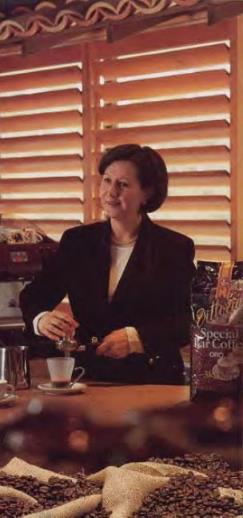
516 The following is an enlarged image of the pack shown above revealing, more clearly, the use of “ORO”:
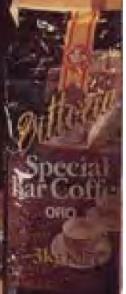
517 Mr Karim said that use of the thermal printer required the operator to manually select and insert into the printer an aluminium plate bearing the word that was to be printed on the generic rewind film.
518 Mr Karim gave this evidence in his affidavit:
23. I recall that in around the mid-1990s, Cantarella commenced producing a blend of coffee under the brand name ORO in a 3kg-sized pack of roasted coffee beans (ORO 3kg Product). As with all of Cantarella’s 3kg roasted coffee bean products produced and packaged at the Ryde Factory at that time, the ORO 3kg Product was packaged in the Generic Rewind Packaging, with the brand ORO stamped on the front of the pack in white, using the process I described … involving the aluminium plates and the Thermal Printer.
24. I am very familiar with the ORO 3kg Product. As one of the Machine Operators during the 1990s, I personally changed the aluminium plate and operated the Thermal Printer and the packaging machines, to produce the ORO 3kg Product in the Generic Rewind Packaging, in the manner that I described … as part of my regular duties.
519 I should record that Mr Karim’s use of the words “brand” and “brand name” were admitted into evidence subject to a limitation under s 136 of the Evidence Act 1995 (Cth) (the effect of which was to place no greater significance on the word “ORO” than was revealed by the packaging itself).
520 Returning to the brochure and the image reproduced above, Mr Karim said:
25. … This is the same packaging that I recall creating to package thousands of packs of the ORO 3kg Product while working on Cantarella’s production line from the time when ORO was first manufactured and sold in around the mid-1990s. …
521 In his cross-examination, Mr Karim suggested that, in this part of his affidavit, the “mid-1990’s” could be 1993 or 1994. I do not accept that evidence. It is inconsistent with Cantarella’s case on first use, which is based on the creation of the COVIBON3 product code.
522 Mr Karim recalled that, “in or around 2000”, Cantarella developed a new rewind film for use in packaging this product. He referred to a copy of another brochure for VITTORIA coffee which is titled “Extracts” and designated as “No. 4 2000”. The content of the brochure suggests that it was created before the commencement of the Summer Olympic Games held in Sydney in 2000 (15 September to 1 October 2000). Mr Karim identified the following image as depicting the new packaging:
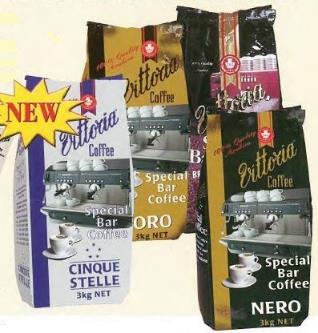
523 The question that is presented is: was COVIBON3 the VITTORIA SPECIAL BAR COFFEE product that Mr Karim said was packaged in the generic rewind film with “ORO” printed on the front of the pack? On balance, I am satisfied that it was.
524 Based on Mr Karim’s evidence, I accept that Cantarella supplied a product that was packaged as a 3 kg pack of roasted coffee beans using the generic rewind film on which “ORO” was stamped on the front of the pack before it was filled with the beans. I accept that this was a particular blend of coffee beans roasted by Cantarella and that, before 2000, the packaging of this product was in the form shown in the image reproduced at [515] and [516] above. I accept that, on this packaging, “ORO” was used as a trade mark. As I have noted, Mr Karim’s evidence was that Cantarella commenced producing this product “in or around the mid-1990s”.
525 Mr Audi interrogated the ANZIO System for SKUs relating to products with the description “ORO”. This yielded a list of 45 discrete products, including products whose listing had been discontinued or was about to be discontinued. COVIBON3 is the only product corresponding to the product that Mr Karim described. Indeed, only one other 3 kg coffee product was identified. This was a product packaged in a canister (plainly, not the product described by Mr Karim). As I have noted, the product code COVIBON3 was created on 2 August 1996 and the first supply of the product was on 20 August 1996 with other supplies to other customers on 24 August 1996, 5 September 1996, 12 September 1996, 14 September 1996, and on succeeding dates.
526 Lavazza argues for a different conclusion.
527 First, it submits that neither Mr Audi’s affidavit nor Mr Karim’s affidavit connects COVIBON3 with particular packaging at a relevant time. Lavazza submits that the evidence of first use of the packaging by Cantarella at a particular point in 1996 is non-existent. For the reasons given above, I disagree. The evidence allows the connection to be deduced on the balance of probabilities.
528 Secondly, Lavazza submits that the brochure promoting the Vittoria Coffee College, by reference to which Mr Karim identified the packaging of the 3 kg product, is not dated and includes images of other products which, Lavazza argues, could not have been in existence earlier than July 1999. Moreover, Lavazza points to the fact that the image on which Mr Karim relies has been reproduced by Cantarella in other, much later dated, brochures. None of those matters (assuming their correctness) contradicts Mr Karim’s evidence of his recollection of the appearance of the 3 kg product packaged in the generic rewind packaging film on which “ORO” was printed.
529 Thirdly, Lavazza points to a letter dated 30 June 1998 that was written by Cantarella’s then solicitors, Mallesons Stephen Jaques, in relation to a coexistence proposal concerning the use of the ORO word mark. The proposal was put to Societe La Froid (SLF), which was the applicant for registration of the word “oro” as a trade mark in respect of “Non-alcoholic drinks; fruit drinks and fruit juices; nectars of fruit” (Trade Mark Application No. 668329). The proposal was that Cantarella would withdraw its opposition to Trade Mark Application No. 668329 if, amongst other things, SLF did not object to Cantarella’s use of the ORO word mark in respect of “coffee goods”. At that time, Cantarella was registered as the owner of Trade Mark No. 714946 (ORO NERO). The proposal included the following sentence which was provided by way of background information:
Apart from the ORO NERO trade mark, our client will also be using the ORO trade mark in respect to coffee goods alone.
530 As I understand it, Lavazza contends that this sentence should be understood as conveying that, as at 30 June 1998, Cantarella had not used the ORO word mark in relation to coffee but was intending to do so in the future.
531 I do not read the letter in that way. Although the letter is referring to a future state of affairs, I do not accept that the author’s use of the future continuous tense necessarily conveys that Cantarella had not already used the ORO word mark for coffee. In my view, the letter is silent on that matter.
532 Fourthly, Lavazza submits that the records produced through Mr Audi do not support a finding that the first sale and supply of COVIBON3 was to Mallesons Stephen Jaques in the packaging to which I have referred. Lavazza points to the fact that the summary of data provided by Mr Audi does not show the quantity of the product that was supplied or that the supply was “a normal commercial sale” or even “a commercial transaction”. Lavazza submits that a “more reasonable assumption” is that Cantarella provided COVIBON3 to Mallesons Stephen Jaques in connection with Cantarella’s trade mark application for NERO ORO (which was filed on 12 August 1996). In advancing that submission, Lavazza does not suggest why COVIBON3 would have been supplied to Mallesons Stephen Jaques for that purpose.
533 I am not persuaded by these submissions. Mr Audi produced a sales report from the archived data of the ANZIO System in a form which he described as one he “regularly use[s] to extract information from ANZIO” (Report ZRCNT299). This report contains data in respect of orders placed by Mallesons Stephen Jaques, Fratelli Italian Restaurant, and D & S Trading Company (Tas). The report also includes, separately, under the column “Customer Name”, data for “PROMOTIONAL ITEMS ONLY” (Customer code PROMOS2) and data for “PROMOTIONAL ISSUES” (Customer code PROMOM3). I infer that the last-mentioned customer codes were used by Cantarella to account for the supply of promotional goods and services that were not, themselves, actual commercial sales of the goods and services that are recorded.
534 The entries for Mallesons Stephen Jaques indicate that, on 7 October 1993, Cantarella supplied the firm with equipment on loan, valued at $5,500.17. The entries also record that Cantarella made a number of sales to Mallesons Stephen Jaques for a variety of goods, such as coffee in various forms and packaging, drinking chocolate, sugar sticks and sweeteners, filter paper, cleaner, and various spare parts. The goods include COVIBON3, with the first sale recorded for that product on 20 August 1996 and the last sale (for the period of the report) on 23 June 1999. Other than the equipment supplied on loan, there is no reason to think that the supply of the other products were other than by sale in the ordinary course of trade, as the report before me indicates.
535 In the light of this report, I do not think it is realistic to suggest that Cantarella supplied COVIBON3 to Mallesons Stephen Jaques on 20 August 1996 in connection with Cantarella’s trade mark application for ORO NERO. I also note that the report does not record any supply of ORO NERO to Mallesons Stephen Jaques in the period up to 30 June 1999.
536 It is true that the data extracted by Mr Audi does not show the quantity of COVIBON3 supplied to Mallesons Stephen Jaques on 20 August 1996. However, once it is accepted (as I do) that the supply was by sale in the ordinary course of trade, the quantity that was supplied on that occasion is not as important as Lavazza would have it. The evidence of supply on 20 August 1996 must be taken with the other evidence, including the fact that COVIBON3 was supplied at around the same time to other customers of Cantarella, and Mr Karim’s evidence of the commercial production of the ORO 3 kg product at around that time. All these matters combine to show that the supply of COVIBON3 to Mallesons Stephen Jaques on 20 August 1996 was part of a substantial commercial undertaking by Cantarella at that time.
537 For these reasons, none of the matters raised by Lavazza persuade me to a conclusion other than that Cantarella first used the ORO word mark in relation to coffee on 20 August 1996.
The use of ORO in relation to LAVAZZA QUALITÀ ORO coffee
538 In closing submissions, Lavazza directed its case on the prior use of the word “oro” in relation to LAVAZZA QUALITÀ ORO coffee to two sets of advertisements placed in the period 1982 to 1988, and in certain invoices.
539 The first set of advertisements comprises the advertisements placed in La Fiamma newspaper by various retailers (the retailers’ advertisements): see [59] – [60] above. In these advertisements, Lavazza points not only to the use of the word “oro” (sometimes represented in inverted commas), but also the use of the word “marca” which precedes “oro” in each case. For completeness, I record that there are similar advertisements in evidence which include the word “tipo” or the word “pacco” preceding “oro”. Unfortunately, some of the reproductions of the advertisements that are in evidence are of poor quality.
540 Mr Valmorbida gave evidence that “Lavazza Marca Oro” is Italian for “Lavazza Brand Oro”; that “Lavazza Tipo Oro” is Italian for “Lavazza Type Gold”; and that “Lavazza Pacco Oro” is Italian for “Lavazza Pack Oro”.
541 In relation to the advertisements using the words “marca oro”, which include a depiction of the LAVAZZA QUALITÀ ORO product (apparently in packaging bearing the Lavazza device mark), Lavazza submits that the word “oro” is used as a trade mark, indicating a connection in the course of trade between the depicted product and LL SpA.
542 Mr Valmorbida was cross-examined on his evidence concerning the meaning of “Lavazza Marca Oro” as used in these advertisements:
Did you have to ask the – what – anybody at that time what marca meant or is that something you already knew?---Like, a – it wasn’t – it’s not a popular term, but it – you know, obviously, it means mark. It’s gold mark. It means – that’s what it means, marca. Being of Italian origin, you know, I – I – I can understand that. That wouldn’t have been external.
You would have understood it as gold mark?---It would’ve been - - -
Correct?---I would have, probably. Yep.
As in, what, like, gold standard or something?---Yeah. Gold quality.
Yes?---I’m surprised to see that, to be honest, but – yeah – because, you know, we always refer to Lavazza Oro or Lavazza Qualità Oro.
Yes. Affidavits can serve as a surprise sometimes. …
543 In cross-examination, Mr Valmorbida was also taken to Trade Mark No. 248906 for the words MARCA D’ORO registered in the name of Conga Foods Pty Ltd (Conga Foods) from 9 June 1971. Consistently with Mr Valmorbida’s cross-examination quoted above, the entry in the Register for that registered mark records that MARCA D’ORO means “golden mark”.
544 The second set of advertisements comprise the advertisements placed by Conga in La Fiamma in the period 25 November 1982 to 6 December 1984 (the Conga advertisements): see [61] above.
545 Lavazza submits that the uses on which it relies pre-date, by many years, any claimed use by Cantarella of the ORO word mark. Lavazza submits that this evidence shows that Cantarella was not the first person to use the word “oro” as a trade mark and that Cantarella was not the owner of the ORO word mark as at the date of registration of the 098 mark or the date of registration of the 290 mark.
546 Lavazza also relies on 43 invoices issued by LL SpA to Conga Amalgamated or to Conga Foods in the period 17 January 1992 to 29 June 1994 in relation to coffee supplied by LL SpA in Italy to Conga Amalgamated and to Conga Foods in Australia (the Conga invoices). Various line items in these invoices use the word “oro” in combination with other words and symbols. These combinations appear in the invoices under the heading DESCRIZIONE UNITA DI VENDITA.
547 In closing submissions, Lavazza provided the following table as a representative sample of the uses of “oro” on which it relies in this regard:
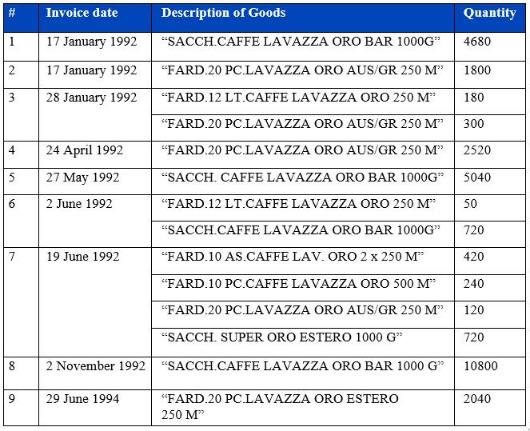
548 Lavazza contends that the various uses of the word “oro” in the Conga invoices are to LAVAZZA QUALITÀ ORO coffee in the Classic Packaging. I accept that this is possible, although I observe that some of the advertisements to which I have referred show packaging that bears the Lavazza device mark. As I have noted, the Lavazza device mark is not the Classic medallion appearing on the Classic Packaging. That said, I do not accept that LAVAZZA QUALITÀ ORO coffee in the Classic Packaging or in packaging that bears the Lavazza device mark uses the word “oro” as a trade mark.
The use of ORO in relation to CAFFÈ MOLINARI ORO coffee
549 Lavazza’s alternative case (to the case based on the use of the word “oro” in respect of the LAVAZZA QUALITÀ ORO product) is that Molinari used the word “oro” as a trade mark in Australia in relation to coffee on, or soon after, 18 September 1995, 17 October 1995, and 26 March 1996 by CMS ordering CAFFÈ MOLINARI ORO in 3 kg and 1 kg packs; Molinari invoicing CMS for those orders; Molinari shipping those products to Australia in the packaging shown at [125] above in accordance with those orders; and CMS receiving those products in Australia.
550 Lavazza also relies on other shipments of CAFFÈ MOLINARI ORO coffee to CMS (or Saeco) of 1 kg packs (based on invoices dated 24 July 1996, 18 September 1996, 15 October 1996, and 9 December 1996) and 250 g packs (based on an invoice dated 25 September 1997), in the packaging shown at [125] above.
551 Although in its written submissions Lavazza focussed on the invoices and supplies to which I have referred, it also advanced a more general contention that the use of the word “oro” in the invoices issued by Molinari to CMS, Saeco, Coffee Supplies Australia, and Russo that are in evidence for the period up to 1999, and the goods shipped under those invoices, amount to trade mark use of the word “oro” that is “superior” to any use by Cantarella of the word “oro” as a trade mark before the priority date of the 098 mark. Lavazza contends that “all those invoices represent prior use of ORO that defeats Cantarella’s title”. I understand this to be a submission that the invoices in and of themselves—that is to say, considered separately from the packaging of the goods in question to which the invoices refer—constitute a trade mark use of the word “oro”.
Analysis
552 This aspect of the case depends on whether Lavazza has established that there was use of the word “oro” as a trade mark for coffee by a person or persons other than Cantarella before 20 August 1996.
553 I am not persuaded that the retailers’ advertisements for LAVAZZA QUALITÀ ORO on which Lavazza relies establish use of “oro” as a trade mark. Plainly, the word “oro” is used in the advertisements. However, when viewed in context, the use in each advertisement is no more than an idiosyncratic use by an independent trader, through whose hands the goods were passing at the time, to refer, in a truncated way, to the LAVAZZA QUALITÀ ORO product that was depicted in the advertisement. When each advertisement is considered as a whole, the use of the word “oro” in this way merely functions to highlight or draw attention to the advertised product (on which the word “oro” is not used as a trade mark), in a manner of the particular retailer’s own choosing. I do not accept that, in these circumstances, the word “oro” (in the form of ORO or “ORO”) is functioning as a discrete or independent use of that word as a trade mark. Rather, ORO or “ORO” is functioning only as a shortened description of the product itself.
554 My assessment is no different when the Italian word “marca” is used in the advertisements in conjunction with “oro”. Even if Mr Valmorbida’s evidence in chief is taken at face value, such that “Marca ORO” or “Marca ‘ORO’” means “Brand ORO”, the use of ORO or “ORO” in these cases is still no more than a shortened, descriptive reference, of the retailer’s own choosing that is functioning to highlight and draw attention to the depicted product itself.
555 Mr Valmorbida’s evidence in cross-examination is, however, revealing. Notwithstanding his evidence in chief, the effect of Mr Valmorbida’s evidence in cross-examination is that the conjunction of “Marca” with ORO or “ORO” is a statement about quality, not trade source. On the basis of this evidence, I accept that some readers of these advertisements would have understood the use of ORO or “ORO” in conjunction with “marca” to be no more than a statement about quality, such as “gold quality”.
556 However, whether as a descriptive reference to the depicted product, or as a descriptive statement about quality of the depicted product, the word “oro” in these advertisements (in the form of ORO or “ORO”) is not functioning as a trade mark in its own right.
557 I am of the same view in respect of the advertisements in which ORO or “ORO” is used in conjunction with “tipo” or “pacco”. I accept that “tipo” means “type”, and that “pacco” means “pack”, in English. But, once again, when the word “oro” is used in these advertisements (in the form of ORO or “ORO”) with “tipo” or “pacco”, it is no more than a shortened, descriptive reference to the depicted product itself.
558 The use of ORO in the Conga advertisements stands in the same position. In these advertisements, the word LAVAZZA is prominent and functions as a trade mark. The words ORO, ARGENTO, and ROSSA are given as varieties of the LAVAZZA coffee product. I do not accept that, in these advertisements, ORO functions as a trade mark. In these advertisements, ORO functions merely as a description of product type, not as a badge of origin.
559 I now turn to Lavazza’s reliance on the 43 invoices issued by LL SpA to Conga Amalgamated and Conga Foods.
560 During the course of the trial, Lavazza sought to tender 19 documents which purported to be invoices. I rejected the tender: Cantarella Bros Pty Ltd v Lavazza Australia Pty Ltd [2020] FCA 1895. In reaching that view, I observed that the tender was simply of the documents themselves without evidence explaining the documents, the process by which they were created, or the function they actually performed. I stated that it was not even possible to find that the documents had been sent to Australia or that it was possible to link them to any particular transaction. I considered these to be significant obstacles to the tender being accepted, for the reasons I then expressed.
561 At [4] I also observed:
4 The place where the word “Oro” appears in the documents is a product description. “Oro” is used with other words. It is far from self-evident that “Oro” is there being used as a trade mark. In my view, the use relied on is entirely equivocal as to trade mark use and certainly distinguishable, in fact, from the example provided in Thunderbird Products Corporation v Thunderbird Marine Products Pty Ltd (1974) 131 CLR 592. As the evidence in this case already shows, and by way of example only, the word “Oro” can refer to the colour of the packaging used for a product; it can refer to the quality or standard of the product, as a premium or first-ranking product. Indeed, the respondents themselves argue that it can also refer to a blend or, at least, part of a description of a blend. There are clear indications in the documents themselves that the descriptions are, in fact, idiosyncratic statements about the products to which they refer. I would infer that these statements are of the authors of the documents. I do not know what was in the authors’ minds when the documents were created, in particular the reason or reasons why they chose to describe the products in the way they variously did.
562 Although the 43 invoices that are now in question were explained in Ms Musso’s evidence (as copies of invoices issued by LL SpA to Conga Amalgamated or to Conga Foods, which were retrieved from LL SpA’s archives and which concern the supply of Lavazza coffee, including LAVAZZA QUALITÀ ORO, to Conga Amalgamated or Conga Foods pursuant to the Distributorship Agreement entered into on 16 November 1990), the observations quoted above are pertinent to these invoices as well.
563 The representative examples given in Lavazza’s table refer to the following descriptions of goods:
(a) SACCH.CAFFE LAVAZZA ORO BAR 1000G (4 invoices);
(b) FARD.20 PC.LAVAZZA ORO AUS/GR 250 M (4 invoices);
(c) FARD.12 LT.CAFFE LAVAZZA ORO 250 M (2 invoices);
(d) FARD.10 AS.CAFFE LAV.ORO 2 x 250 M (1 invoice);
(e) FARD.10 PC.CAFEE LAVAZZA ORO 500 M (1 invoice);
(f) SACCH.SUPER ORO ESTERO 1000 G (1 invoice); and
(g) FARD.20 PC.LAVAZZA ORO ESTERO 250 M (1 invoice).
564 I have not been provided with evidence as to how the product descriptions came to be used in the invoices, such as whether they were obtained from a list of standardised descriptions or whether they were simply descriptions left to be determined at the discretion of the creator of each invoice. In either case, I have no evidence as to why these particular descriptions were used or how they were arrived at.
565 However, what is tolerably clear is that, in each case, the description is simply that of a specific LAVAZZA coffee product that was being supplied to Conga Amalgamated or to Conga Foods at the time. In these descriptions, I am not persuaded that the word “oro” is functioning in its own right as a badge of origin.
566 First, it is obvious that the invoices have been prepared in the Italian language. The use of “oro” is, at best, equivocal given that the word means “gold” in Italian. The use of “oro” in the invoices is consistent with it performing an entirely descriptive function, providing only a convenient, shortened reference to the LAVAZZA QUALITÀ ORO product in its gold coloured packaging.
567 Secondly, I interpret the words LAVAZZA ORO or LAV ORO as referring, once again, in no more than a convenient short form way to the LAVAZZA QUALITÀ ORO product line, with the other words and symbols in each description combining with LAVAZZA ORO or LAV ORO to confine each description to a specific coffee product within that line. Each description must be considered as a whole and in context. The use of “oro” in these descriptions cannot be simply isolated from the somewhat complex combinations of words and symbols of which, in each case, the word “oro” merely forms a part, and then considered in the abstract.
568 I am not persuaded, therefore, that the invoices on which Lavazza relies constitute, in and of themselves, use of the word “oro” as a trade mark.
569 The case based on Molinari’s use of the word “oro” in respect of the supply of CAFFÈ MOLINARI ORO coffee stands in a different position.
570 Cantarella frames this issue as whether Molinari is the owner of the ORO word mark in Australia. In that connection, it contends that Molinari is not the owner of the mark. Indeed, it contends that Molinari is not even a “person” who “claims to be the owner of the trade mark”, i.e., for the purposes of s 27(1)(a) of the Act.
571 These contentions do not address the correct question. The correct question is whether, at the time it applied for registration under the Act of the ORO word mark in respect of coffee, Cantarella was the owner of that mark in respect of those goods. For the purposes of the Act, Cantarella could not have been the owner of that mark in respect of those goods if some other person had used the word “oro” as a trade mark in Australia in respect of coffee before Cantarella first used it.
572 Thus, if it is established that Molinari used the word “oro” as a trade mark in Australia in respect of coffee before Cantarella used it then, absent special circumstances (such as those discussed at [581] – [582] below), Cantarella’s claim to ownership cannot be sustained and the ground of opposition under s 58 of the Act will have been made out. This is how Lavazza puts its case. Lavazza does not need to establish that Molinari is the owner in Australia of the ORO word mark in respect of coffee. It only has to establish that Cantarella was not, and could not claim to have been, the owner of the mark at the times that it applied for the 098 mark and the 290 mark.
573 I am satisfied that Lavazza has established that, before Cantarella’s first use, Molinari used the word “oro” as a trade mark in Australia on the 3 kg packs of CAFFÈ MOLINARI ORO coffee that Molinari supplied to CMS under the invoices dated 18 September 1995, 17 October 1995, and 26 March 1996.
574 I reach this conclusion having regard to the size, colour, positioning, and prominence of the word “oro” on the packaging in relation to the other packaging elements. I observe that the word “oro” on that packaging is as conspicuous as the other trade mark used—CAFFÈ MOLINARI. I do not accept Cantarella’s contention that the word “oro” is used only as an element in the composite mark MISCELA DI CAFFE ORO, and not as a trade mark its own right.
575 Subject to the matter discussed in more detail at [581] – [593] below, this finding is sufficient to deprive Cantarella of its claim of ownership of the ORO word mark in Australia in relation to coffee as at the priority date of the 098 mark and as at the priority date of the 290 mark.
576 For completeness, I record that I am not persuaded that the use of ORO BAR on the packaging of 1 kg packs of CAFFÈ MOLINARI ORO coffee (as depicted at [125] above) is trade mark use of the ORO word mark. I do not consider that, as a trade mark, ORO BAR is the same as, or substantially identical with, ORO simpliciter.
577 The position in relation to the invoices issued by Molinari to CMS, Saeco, Coffee Supplies Australia, and Russo is substantially the same as the position in relation to the 43 invoices issued by LL SpA to Conga Amalgamated and Conga Foods. I am not persuaded that the use of the word “oro” in the product descriptions given in the invoices issued by Molinari is the use of that word as a badge of origin. As for the 43 invoices issued by LL SpA, the Molinari invoices are expressed in the Italian language and use the word “oro” in combination with other words and symbols to perform the purely descriptive function of identifying particular products in a particular product line. In each case, the use of the word “oro” in the description cannot be isolated from the complete description and considered in the abstract. Of course, unlike the 43 invoices issued by LL SpA, some of the invoices issued by Molinari to CMS and Coffee Supplies Australia do cover products on which the packaging does use the word “oro” as a trade mark. If, in relation to these particular products, the descriptions given in the invoices do include the use of “oro” as a badge of origin (contrary to what I have found), such use cannot rise higher than the use of “oro” on the products themselves, and does not add materially to Lavazza’s case.
578 It is appropriate that I also make findings in relation to the CAFFÈ MOLINARI ORO coffee supplied by Molinari to its Australian distributors as at the priority date of the 098 mark and before the priority date of the 290 mark. This is necessary because Cantarella contends that if, at any time, Molinari had been the “owner” of the ORO word mark in respect of coffee, Molinari ceased to be the owner of that mark as at the priority date of the 098 mark (24 March 2000) and as at the priority date of the 290 mark (30 September 2013). Cantarella contends that, at those dates, Molinari had ceased to use the ORO word mark and, had Molinari registered the ORO word mark in Australia in its own name, that registration would have been vulnerable to removal under s 92(4)(a) or (b) of the Act for non-use of the mark.
579 Cantarella raises a similar contention in relation to the date that Lavazza filed its notice of cross-claim seeking cancellation of the registrations of the 098 mark and the 290 mark.
580 These contentions are based on the common law notion of abandonment.
581 Cantarella contends, correctly, that ownership of a registered trade mark can be lost. Property in a registered trade mark is not permanent: JT International SA v Commonwealth [2012] HCA 43; 250 CLR 1 at [31]. Proprietorship of a registered trade mark can be lost upon an established general law basis, such as estoppel, acquiescence, or abandonment: Riv-Oland Marble Co (Vic) Pty Ltd v Settef SpA (1988) 19 FCR 570 at 571 (Riv-Oland).
582 However, in the case of abandonment, the proprietary title to a registered trade mark is lost not by mere non-use or slightness of use, but by intentional abandonment: Settef SpA v Riv-Oland Marble Co (Vic) Pty Ltd (1987) 10 IPR 402 at 421 – 422; Riv-Oland at 571 – 572; Mouson & Co v Boehm (1884) 26 Ch D 398 (Mouson) at 405; Blogg v Anderson (1900) 21 NSWR Eq 238 at 242; “Weston” Trade Mark [1968] RPC 167 at 183. Whether an intention to abandon is established in a given case is a question of fact to be determined having regard to all the circumstances of that case. For that reason, I now turn to the evidence that is relevant to this aspect of the case.
583 I am satisfied that Molinari used the word “oro” as a trade mark in Australia on the 250 g packs of CAFFÈ MOLINARI ORO coffee that Molinari supplied to CMS, Coffee Supplies Australia, and Espresso Group to which I have referred at [199] above. Similarly, I am satisfied that Molinari used the word “oro” as a trade mark in Australia on the 1 kg packs of CAFFÈ MOLINARI ORO coffee that Molinari supplied to Espresso Group and Modena to which I have referred at [201] above. Once again, I reach these conclusions having regard to the size, colour, positioning, and prominence of ORO on the packaging in relation to the other packaging elements of the packs in question.
584 Further, I am satisfied that Molinari used the word “oro” as a trade mark in Australia on the 1 kg packs of CAFFÈ MOLINARI ORO coffee that Molinari supplied to Modena in the period from May 2010 to which I have referred at [205] – [207] above in respect of product codes 6071, 6077 and 6021A/6021E. Again, I reach these conclusions having regard to the size, colour, positioning, and prominence of ORO on the packaging in relation to the other packaging elements of the packs in question.
585 In reaching these conclusions, I have taken into account that, on the packaging for product codes 6077 and 6021A/6021E, the word “oro” appears below the word “qualità”. In my estimation, the proximity of the word “oro” to the word “qualità” does not diminish the prominence given to “oro” (which, in each case, is rendered in larger font than “qualità”) or its significance as a packaging element. Even if traders or customers were to associate the two words because of their proximity to each other on the packaging it does not follow that the word “oro” is not functioning, in its own right, as a trade mark. Once again, the existence of a descriptive element or purpose does not necessarily preclude the sign being used as a trade mark.
586 That said, I would accept that the word “oro”, as used on the packaging for product codes 6021A/6021E, is a clearer use of “oro” as a trade mark than the use of the word “oro” on the packaging for product code 6077. This is because “oro” is rendered in still larger font than “qualità” and is separated from “qualità” by the use of a horizontal line. Also, “oro” appears in the middle of the pack, which I consider to be somewhat more prominent positioning because of its central location on the pack. I do not regard the use of “oro” on the packaging for product codes 6021A/6021E as any less a trade mark use of “oro” than the use of “oro” on the LAVAZZA QUALITÀ ORO packaging which I have found to infringe the 098 mark and the 290 mark.
587 I also note that products in the packaging for product codes 6021E were invoiced by Molinari, and thus despatched for supply into the Australian market, on 17 September 2013, before the priority date of the 290 mark.
588 The consequence of the findings at [583] – [584] above is that Cantarella’s case on abandonment, insofar as it is based on non-use by Molinari of the ORO word mark in Australia in respect of coffee, cannot be sustained as a matter of fact. The evidence establishes that before Cantarella’s first use of the ORO word mark in relation to coffee, before the priority date of the 098 mark, and before and after the priority date of the 290 mark, as well as at the commencement of the present proceeding (including the commencement of Lavazza’s cross-claim), Molinari used the word “oro” as a trade mark in Australia in relation to coffee.
589 Indeed, Cantarella’s reliance on abandonment in relation to the 098 mark is inconsistent with its commencement and prosecution of the Modena proceeding in 2011. Plainly, by commencing that proceeding, Cantarella considered that, at that time, the supply of CAFFÈ MOLINARI ORO coffee by Modena was an infringement, and continuing infringement, of the 098 mark.
590 Molinari’s conduct from June 2011—and particularly from 2013 by supplying 1 kg packs of CAFFÈ MOLINARI ORO coffee into the Australian market in the form of the packaging for products codes 6021A/6021E—reveals its continuing preparedness to use “oro” as a trade mark, although, perhaps, not in a form about which Cantarella wishes to complain. But, an absence of complaint from Cantarella does not mean that Molinari has not used, and is not continuing to use, the word “oro” as a trade mark for coffee in Australia.
591 Moreover, although the fact that Molinari has never attempted to register the word “oro” as a trade mark in Australia for coffee is a relevant matter for consideration, it is only one matter to be taken into account: Mouson at 405. There may be many reasons why Molinari has not attempted to take the step of seeking trade mark registration of the word “oro”. The fact that Molinari has not taken the overt step of claiming ownership of the ORO word mark for itself does not mean that Cantarella can legitimately claim that it is the owner of the mark.
592 For these reasons, I am satisfied that Lavazza has made out this ground of its cross-claim and that the registrations of the 098 mark and the 290 mark are not valid.
593 As with the case based on s 41 of the Act, the parties raised a number of additional matters in submissions on the trade mark ownership aspect of the case. In light of the findings I have made and the conclusions to which I have come, it is now not necessary for me deal with those matters.
594 Section 88(1) of the Act confers a discretion on the Court not to cancel the registration of a mark in circumstances where the power to cancel is enlivened: Anchorage Capital Partners Pty Ltd v ACPA Pty Ltd [2018] FCAFC 6; 259 FCR 514 (Anchorage) at [146]. Cantarella contends that, if it be found that Molinari is the owner of the ORO word mark in Australia, or was the owner at a relevant time (meaning, I assume, that I find that Cantarella was not the owner of the ORO word mark), the Court should exercise its discretion not to cancel the registrations of the 098 mark and the 290 mark. In this connection, Cantarella relies on the considerations listed in paragraph 3 of its further amended defence to the cross-claim.
595 In summary, those considerations are:
(a) Cantarella has adopted and continuously used the ORO word mark in Australia in relation to coffee honestly and in good faith since at least 20 August 1996;
(b) it has been registered as the owner of the 098 mark and the 290 mark since their respective dates of registration;
(c) in the Modena proceeding the High Court found that the 098 mark was inherently adapted to distinguish the registered goods from the goods of other traders and that that state of affairs should not be disturbed;
(d) Cantarella has established a strong reputation and goodwill in the 098 mark and the 290 mark;
(e) the supply by any other person of coffee under or by reference to the ORO word mark will likely lead to confusion amongst consumers as to the source of the goods;
(f) until the filing of the notice of cross-claim, no person had challenged the registrations of the 098 mark and the 290 mark on the basis of trade mark ownership;
(g) none of the persons identified in Annexure A to the further amended cross-claim has challenged Cantarella’s ownership of the ORO word mark;
(h) the circumstances giving rise to cancellation of the registrations of the 098 mark and the 290 mark on ownership grounds had ceased to exist as at the date of filing the notice of cross-claim and at the present time;
(i) it would be contrary to public policy to permit the registrations of the 098 mark and the 290 mark to be cancelled when Molinari itself does not make a claim to ownership of the ORO word mark or seek to register the ORO word mark itself;
(j) Cantarella will be subject to inconvenience if the registrations of the 098 mark and the 290 mark are cancelled;
(k) there is no utility in cancelling the registrations of the 098 mark in the 290 mark because Cantarella would obtain registration of the ORO word mark were it to apply for registration now; and
(l) the public interest will not be adversely affected if the registrations of the 098 mark and the 290 mark are not cancelled.
596 Cantarella submits that the Court should be particularly reluctant to cancel the registration of the 290 mark which, it says, was registered on the basis of acquired distinctiveness: as to which, see my comment at [485] above.
597 I am not persuaded that any of these matters, whether individually or together, stands as a sufficient reason not to cancel the registrations of either the 098 mark or the 290 mark. To allow these registrations to stand would not be in the public interest. Regardless of the registrability of the ORO word mark (at least at certain times), Cantarella is not, itself, entitled to be the owner of that mark. Its claim to ownership cannot depend on the nature or scope of its reputation in the mark: Anchorage at [164]. Other traders should not be vexed with the prospect that these registrations might be deployed by Cantarella to inhibit their trading activities, as has happened in the present case.
598 In Anchorage (at [166]) the Full Court observed that if a registered owner has used a mark over a number of years without causing any deception then that is a consideration that may be relevant to the exercise of the discretion. However, the Full Court did not accept that such a consideration is of significant weight. I do not think it is of significant weight in the present case. If, through use, Cantarella has established a strong reputation and goodwill in the ORO word mark (as Cantarella alleges), and if another trader’s use of the word “oro” in Australia in relation to coffee leads to deception or confusion, Cantarella will continue to hold the rights (if any) it has acquired by reason of its reputation. Those rights will not be lost if the registrations of the 098 mark and the 290 mark are cancelled. If, for some other reason, another trader’s use of the ORO word mark leads to deception or confusion, then that will not be addressed appropriately by allowing the registrations to remain so that Cantarella can assert rights it cannot legitimately hold. Cantarella might well be “inconvenienced” if the registrations are cancelled, but that is, plainly, not a reason why the registrations should be maintained.
599 Further, I do not accept that if Cantarella were to re-apply to register the word “oro” as a trade mark, it would necessarily obtain that registration. Therefore, I do not accept that there is no utility in cancelling the registrations (assuming that to be a legitimate reason in any event).
600 I am satisfied, therefore, that the registrations of the 098 mark and the 290 mark should be cancelled on the ground that the registrations are not valid.
601 It follows that, notwithstanding my findings at [382] above, Cantarella’s case on infringement cannot succeed.
Introduction
602 Given my conclusion that the registrations of the 098 mark and the 290 mark should be cancelled, and that, for that reason, Cantarella’s case on infringement cannot succeed, the defences to infringement raised by Lavazza need not be determined. Nevertheless, I will briefly state my views on the availability of those defences.
603 Section 124(1) of the Act relevantly provides:
(1) A person does not infringe a registered trade mark by using an unregistered trade mark that is substantially identical with, or deceptively similar to, the registered trade mark in relation to:
(a) goods similar to goods (registered goods) in respect of which the trade mark is registered; or
(b) …
(c) …
(d) …
if the person, or the person and the person’s predecessor in title, have continuously used in the course of trade the unregistered trade mark in relation to those goods or services from a time before:
(e) the date of registration of the registered trade mark; or
(f) the registered owner of the registered trade mark, or a predecessor in title, or a person who was a registered user of the trade mark under the repealed Act, first used the trade mark;
whichever is earlier.
604 This defence is raised in paragraph 11(d) of Lavazza’s third further amended defence.
605 In this connection, Lavazza contends that, before Cantarella’s first use of the ORO word mark, LL SpA and its authorised users continuously used LAVAZZA QUALITÀ ORO and QUALITÀ ORO as trade marks in Australia. According to Lavazza, this use engages the s 124 defence. However, Lavazza’s pleading of the s 124 defence in paragraph 11(d) of the third further amended defence sits inconsistently with the allegations it makes in paragraph 11(a) of that defence. It is necessary, therefore, to turn immediately to paragraph 11(a).
606 In paragraph 11(a) of the third further amended defence, Lavazza pleads (amongst other things) that it has not used the ORO word mark but only the unregistered marks LAVAZZA QUALITÀ ORO and QUALITÀ ORO for coffee. (I leave to one side Lavazza’s allegation in paragraph 11(a) concerning its use of the Lavazza device mark (Trade Mark No. 340868) because s 124 of the Act is only concerned with the prior continuous use of an unregistered mark.)
607 Contrary to these pleaded allegations, I have found that Lavazza has used the ORO word mark, and I have rejected the case that it has only used the word “oro” as part of the composite mark LAVAZZA QUALITÀ ORO or the composite mark QUALITÀ ORO. Therefore, paragraph 11(a) of the defence cannot be established on the findings I have made.
608 However, more importantly for present purposes, Lavazza also pleads in paragraph 11(a) that LAVAZZA QUALITÀ ORO and QUALITÀ ORO are not the same as, and not substantially identical with or deceptively similar to, the ORO word mark. Cantarella does not dispute that proposition.
609 Therefore, even if I had found that Lavazza had used LAVAZZA QUALITÀ ORO and QUALITÀ ORO as trade marks, Lavazza’s pleading of paragraph 11(a) precludes its reliance on LAVAZZA QUALITÀ ORO and QUALITÀ ORO for the defence under s 124(1) of the Act (because, for the s 124 defence to operate, the unregistered mark must be substantially identical with or deceptively similar to the registered mark that is infringed).
610 Therefore, had it been necessary for me to decide the question, I would not have been persuaded that the defence under s 124(1) is available to either Lavazza Australia or Lavazza OCS.
The defence under s 122(1)(b)(i)
611 Section 122(1)(b)(i) of the Act provides that, in spite of s 120 of the Act, a person does not infringe a registered trade mark when:
(b) the person uses a sign in good faith to indicate:
(i) the kind, quality, quantity, intended purpose, value, geographical origin, or some other characteristic, of goods or services;
612 This defence is raised in paragraph 11(f) of Lavazza’s third further amended defence. Lavazza contends that it has used the word “oro” in good faith to indicate the quality of coffee goods and/or to denote a variant within LL SpA’s range of coffees sold under the LAVAZZA trade mark.
613 I have rejected the case that LL SpA’s use of the word “oro” on the impugned packaging was commercially dishonest conduct adopted for the purpose of appropriating part of Cantarella’s trade or reputation, or with an intention to otherwise mislead or deceive. Cantarella does not, of course, sue LL SpA for infringement of the 098 mark or the 290 mark. It sues LL SpA’s Australian distributors—Lavazza Australia and Lavazza OCS. As I have noted, Lavazza Australia is a wholly-owned subsidiary of LL SpA, and Lavazza OCS is a wholly-owned subsidiary of Lavazza Australia. In closing submissions, Lavazza made clear its position that the decision-making process in respect of the design of LAVAZZA coffee products, including the origination of products, takes place in Italy. Lavazza referred to LL SpA as the “clear epicentre of decision-making in relation to Lavazza packaging worldwide, including for Australia”. I accept that submission on the evidence before me.
614 There is nothing before me to suggest that, in respect of matters involving the packaging and presentation of LAVAZZA coffee in Australia, the intentions and motives of Lavazza Australia and Lavazza OCS are, or have been, any different from the intentions and motives of LL SpA. Therefore, to the extent it is made, I reject the case that Lavazza Australia’s use, or Lavazza OCS’s use, of the word “oro” on the impugned packaging was commercially dishonest conduct adopted for the purpose of appropriating part of Cantarella’s trade or reputation, or with an intention to otherwise mislead or deceive.
615 That said, I am not persuaded that LL SpA’s use, or Lavazza Australia’s and Lavazza OCS’s downstream use, of the ORO word mark on the impugned packaging is or was to indicate any of the characteristics of the packaged goods.
616 First, in Britt Allcroft (Thomas) LLC v Miller (t/as Thomas Shop) [2000] FCA 699; 46 IPR 7, Mansfield J observed (at [67]) that the words of s 122(1)(b)(i) appear to have, as their underlying element or genus, some objective description of the goods or services, or a feature of the goods or services, by reference to commonly used and understood qualities. If this be so, the use of “oro” on the impugned packaging is not capable of achieving this objective because “oro” does not have an ordinary signification in the Australian lexicon. In other words, in trade in Australia, the word “oro” is not suited to indicate any of the characteristics of coffee.
617 Secondly, and in any event, I am satisfied that LL SpA has elevated its use of the word “oro” on the impugned packaging beyond anything that genuinely could be said to be a description of the quality or some other characteristic of the packaged coffee. The objective circumstances are consistent only with an endeavour by LL SpA to elevate the word “oro” so that it now functions as a brand within the LAVAZZA range of coffee products. The commencement of this change is evident in some renderings of the ESTERO medallion: see the packaging depicted at [88] above. What, formerly, may have been an intention to use “oro” as an indicium of quality (such as in the Classic Packaging) has evolved into an indicium of trade origin. I am satisfied that this has been a deliberate change. LL SpA would not be able to rely on the defence and, in this regard, Lavazza Australia and Lavazza OCS cannot be in any better position.
618 Therefore, had it been necessary for me to decide the question, I would not have been persuaded that the defence under s 122(1)(b)(i) is available to either Lavazza Australia or Lavazza OCS.
619 Section 122(1)(e) of the Act provides that, in spite of s 120 of the Act, a person does not infringe a registered trade mark when:
(e) the person exercises a right to use a trade mark given to the person under this Act;
620 This defence is raised in paragraph 11(e) of Lavazza’s third further amended defence. For its operation, Lavazza calls in aid s 7(1) of the Act, which provides:
(1) If the Registrar or a prescribed court, having regard to the circumstances of a particular case, thinks fit, the Registrar or the court may decide that a person has used a trade mark if it is established that the person has used the trade mark with additions or alterations that do not substantially affect the identity of the trade mark.
Note: For prescribed court see section 190.
621 Lavazza contends that the infringing uses of the ORO word mark that I have found are uses, authorised by LL SpA, of the registered Lavazza device mark with additions or alterations that do not substantially affect the identity of that mark. Lavazza contends, therefore, that Lavazza Australia and Lavazza OCS have been doing no more than exercising a right to use the Lavazza device mark given by the Act.
622 Section 7(1) has been interpreted as requiring that the registered mark and the mark “with additions or alterations” are substantially identical with each other. With this in mind, it has been said that a total impression of similarity must emerge from a comparison of the marks in question: Optical 88 Limited v Optical 88 Pty Limited (No 2) [2010] FCA 1380; 275 ALR 526 at [256] affirmed in Optical 88 Ltd v Optical 88 Pty Ltd [2011] FCAFC 130; 197 FCR 67 at [35] – [39]; PDP Capital Pty Ltd v Grasshopper Ventures Pty Ltd [2021] FCAFC 128; 285 FCR 598 at [161]. In context, a “total impression of similarity” means something more than mere deceptive similarity. It means nothing less than substantial identity.
623 I am not persuaded that the infringing uses of the ORO word mark that I have found are uses of the Lavazza device mark with additions or alterations that do not substantially affect the identity of that mark.
624 The infringing uses I have found are of the word “oro” as a trade mark. It is true that these infringing uses are in the context of other, accompanying packaging elements that include the LAVAZZA trade mark, a medallion, a ribbon device, and other words, including the word “qualità”. However, it does not follow that all these elements combine to create one composite mark which happens to include the word “oro”. In the infringing uses, the word “oro” is functioning, in its own right, as a trade mark.
625 The Lavazza device mark includes the words “qualità oro”. However, those words are not, themselves, functioning as a trade mark. They are embedded in the Lavazza device mark, the dominant elements of which are the word LAVAZZA, the particular stylised medallion, and the particular stylised ribbon device.
626 In short, the infringing uses of the word “oro” that I have found are not uses of the Lavazza device mark itself; nor are they uses of a mark that is substantially identical with the Lavazza device mark. It is not enough that the surrounding context of Lavazza’s infringing use of the ORO word mark might be suggestive of the Lavazza device mark.
627 This conclusion is entirely consistent with Lavazza’s own pleading. In paragraph 11(a) of its third further amended defence, Lavazza alleges that the Lavazza device mark is not substantially identical with (or even deceptively similar to) the ORO word mark.
628 Therefore, had it been necessary for me to decide the question, I would not have been persuaded that the defence under s 122(1)(e) is available to either Lavazza Australia or Lavazza OCS.
The defences under s 122(1)(f) and s 122(1)(fa)
629 Section 122(1)(f) of the Act provides that, in spite of s 120 of the Act, a person does not infringe a registered trade mark when:
(f) the court is of the opinion that the person would obtain registration of the trade mark in his or her name if the person were to apply for it;
630 Section 122(1)(fa) similarly provides that a person does not infringe a registered trade mark when:
(fa) both:
(i) the person uses a trade mark that is substantially identical with, or deceptively similar to, the first-mentioned trade mark; and
(ii) the court is of the opinion that the person would obtain registration of the substantially identical or deceptively similar trade mark in his or her name if the person were to apply for it;
631 The availability of these defences is assessed as at the commencement of the infringing conduct: Anchorage at [212] – [214]; Sensis Pty Ltd v Senses Direct Mail and Fulfillment Pty Ltd [2019] FCA 719; 141 IPR 463 at [58].
632 In the present case, the defences are raised in paragraphs 11(g) and (h) of Lavazza’s third further amended defence. As pleaded, there are two aspects to be considered.
633 First, Lavazza pleads that LL SpA would obtain registration of LAVAZZA QUALITÀ ORO, QUALITÀ ORO and/or ORO as trade marks if it were to apply for those marks including by reason of honest concurrent use or prior continuous use.
634 Secondly, Lavazza pleads that LL SpA would obtain registration of its “packaging get up” (being the 2019 Product Packaging, the 2019 Mountain Grown Product Packaging, and the NCCC Packaging) as trade marks if it were to apply for those registrations, including by reason of honest concurrent use or prior continuous use.
635 As to honest concurrent use and prior continuous user, s 44(3) and (4) of the Act provides:
(3) If the Registrar in either case is satisfied:
(a) that there has been honest concurrent use of the 2 trade marks; or
(b) that, because of other circumstances, it is proper to do so;
the Registrar may accept the application for the registration of the applicant’s trade mark subject to any conditions or limitations that the Registrar thinks fit to impose. If the applicant's trade mark has been used only in a particular area, the limitations may include that the use of the trade mark is to be restricted to that particular area.
Note: For limitations see section 6.
(4) If the Registrar in either case is satisfied that the applicant, or the applicant and the predecessor in title of the applicant, have continuously used the applicant’s trade mark for a period:
(a) beginning before the priority date for the registration of the other trade mark in respect of:
(i) the similar goods or closely related services; or
(ii) the similar services or closely related goods; and
(b) ending on the priority date for the registration of the applicant’s trade mark;
the Registrar may not reject the application because of the existence of the other trade mark.
Note 1: An authorised use of the trade mark by a person is taken to be a use of the trade mark by the owner of the trade mark (see subsection 7(3)).
Note 2: For predecessor in title see section 6.
Note 3: For priority date see section 12.
636 In closing submissions, Lavazza confined its case on these defences to the second aspect—the claimed entitlement to registration of LL SpA’s “packaging get up” as trade marks.
637 There are numerous difficulties confronting Lavazza in seeking to rely on these defences in the way in which it has raised them and ultimately advanced them in closing submissions.
638 The first difficulty is that the defences under s 122 of the Act are closely confined to particular persons in particular circumstances. For example, in the present case, Lavazza does not contend that the infringers—Lavazza Australia and Lavazza OCS—would obtain registration of the infringed mark (in the case of the defence under s 122(1)(f)), or a mark that is substantially identical with, or deceptively similar to, the infringed mark (in the case of the defence under s 122(1)(fa)), in their own names. Rather, Lavazza alleges that LL SpA would obtain registration. Thus, at the threshold, Lavazza Australia and Lavazza OCS do not meet the characteristics of the persons to whom these defences apply.
639 Lavazza seeks to overcome this difficulty by calling in aid s 26(1)(a) of the Act, which provides:
(1) Subject to any agreement between the registered owner of a registered trade mark and an authorised user of the trade mark, the authorised user may do any of the following:
(a) the authorised user may use the trade mark in relation to the goods and/or services in respect of which the trade mark is registered, subject to any condition or limitation subject to which the trade mark is registered;
640 However, s 26(1)(a) is of no assistance to Lavazza Australia and Lavazza OCS in respect of these defences. It is not a provision dealing with the liability of a person who infringes another person’s registered trade mark. It is a general provision, within a suite of provisions that provide for the rights of a registered trade mark owner and authorised user inter se, dealing with the right of an authorised user to use a trade mark that is actually registered. Section 26(1)(a) does not extend the availability of the defences under s 122(1)(f) and (fa) beyond the very language of those provisions, which is specific as to the persons in respect of whom the defences apply.
641 The second difficulty that confronts Lavazza is the fact that the case ultimately advanced in submissions on honest concurrent use does not engage with the specific requirements of the defences under s 122(1)(f) and (fa). The defences under s 122(1)(f) and (fa) are not as broad as Lavazza would have them.
642 To explain, the defence under s 122(1)(f) is directed to the case where the infringer has used the very mark that is registered (in this case, the ORO word mark), and the Court is satisfied that the infringer would obtain registration of that mark in that person’s name. On the other hand, the defence under s 122(1)(fa) is directed to the case where the infringer has not used the mark that is registered, but a mark that is substantially identical with or deceptively similar to the mark that is registered, and the Court is satisfied that the infringer would obtain registration of the substantially identical or deceptively similar mark in that person’s name.
643 I have found that Lavazza has infringed the 098 mark and the 290 mark by using the word “oro” as a trade mark—that is, the ORO word mark—not a mark that is substantially identical with or deceptively similar to that mark. It follows that only the defence under s 122(1)(f) is potentially available to Lavazza, not the defence under s 122(1)(fa).
644 The question, then, is would Lavazza Australia and Lavazza OCS (or, perhaps, one of them) obtain registration of the ORO word mark if they (or one of them) were to apply for it? The question is not whether LL SpA would obtain registration of its “packaging get up” as a trade mark. The latter question is misdirected and irrelevant.
645 This leads to the third difficulty. Current authority suggests that the operation of s 44 of the Act, and the other grounds for rejecting or opposing a trade mark application, operate independently of each other. For example, in McCormick & Co Inc v McCormick [2000] FCA 1335; 51 IPR 102 (McCormick), Kenny J held (at [79] – [96]) that s 60 of the Act (a ground of opposition to the registration of a mark based on the likelihood of deception or confusion arising from the use of the mark having regard to an earlier mark’s reputation) operates independently of s 44(3), and that s 44(3) does not provide an exception to the operation of s 60. This reasoning suggests that s 58 also operates independently of s 44(3) as a ground of opposition to registration and that s 44(3) does not provide an exception to that provision. I note that this appears to be the position in the Australian Trade Marks Office: Tosca Travel Goods (Aust) Pty Ltd v Samsonite IP Holdings SARL [2015] ATMO; 113 IPR 114 at [43] – [44]. The literature also suggests that this is the case: Davison M and Horak I, Shanahan’s Australian Law of Trade Marks and Passing Off (7th ed, Thomson Reuters, 2022) at [40.1520]; Burrell R and Handler M, Australian Trade Mark Law (2nd ed, Oxford University Press, 2016) at pp 292–293.
646 If that be the correct position, the defence under s 122(1)(f) cannot be made out successfully in the present case given the findings I have made in respect of the ownership of the ORO word mark for coffee. If Cantarella cannot legitimately claim to be the owner of the ORO word mark for coffee, neither can Lavazza Australia or Lavazza OCS, or even LL SpA for that matter, legitimately claim to be the owner of that mark. Therefore, they cannot obtain registration of it.
647 However, giving s 58 an operation that is independent of s 44(3) robs the latter provision of practical effect. If the registered owner of a trade mark is truly the owner of that mark, every application under s 44(3) can be met with a s 58 objection by the registered owner. There is, therefore, an apparent conflict between the operation of s 44(3) and the operation of s 58 of the Act.
648 In Project Blue Sky Inc v Australian Broadcasting Authority [1998] HCA 28; 194 CLR 355, the plurality observed (at [70]):
A legislative instrument must be construed on the prima facie basis that its provisions are intended to give effect to harmonious goals. Where conflict appears to arise from the language of particular provisions, the conflict must be alleviated, so far as possible, by adjusting the meaning of the competing provisions to achieve that result which will best give effect to the purpose and language of those provisions while maintaining the unity of all the statutory provisions. Reconciling conflicting provisions will often require the court “to determine which is the leading provision and which the subordinate provision, and which must give way to the other”. Only by determining the hierarchy of the provisions will it be possible in many cases to give each provision the meaning which best gives effect to its purpose and language while maintaining the unity of the statutory scheme.
(Footnotes omitted.)
649 Whether s 58 does have an operation that is independent of s 44(3) is not a question I propose to explore further given my conclusion that Cantarella’s case on infringement cannot succeed in any event (because the registrations of the 098 mark and the 290 mark are not valid) and given also the other difficulties I have discussed that confront Lavazza in the operation of these defences.
650 Further, I do not propose to embark upon the extensive factual analysis that is required to determine whether, in the present case, the evidence supports a finding of honest concurrent use that would lead to a favourable exercise of the discretion under s 44(3): as to which, see McCormick at [30]. To do so would be supererogation.
651 The fourth difficulty concerns Lavazza’s reliance on s 44(4) for the purposes of s 122(1)(f) and s 122(1)(fa) (if, contrary to my conclusion, s 122(1)(fa) is relevant). As I have said, the availability of the s 122(1)(f) and s 122(1)(fa) defences is assessed as at the commencement of the infringing conduct. However, s 44(4) concerns the prior continuous use of a mark before the priority date of a blocking registration. This creates an incongruity. Lavazza’s case must be that the 2019 Product Packaging, the 2019 Mountain Grown Product Packaging, and the NCCC Packaging were being used by Lavazza Australia and Lavazza OCS before 30 September 2013 (in respect of the 290 mark) and 24 March 2000 (in respect of the 098 mark) at a time when this packaging had not even been created.
652 Perhaps recognising this incongruity, Lavazza contends that “the impugned packaging”—by which Lavazza must mean the 2019 Product Packaging, the 2019 Mountain Grown Product Packaging, and the NCCC Packaging—“continues each of the key essential features and dominant cognitive cues used by LL SpA in Italy since 1956 and in Australia since the late 1970s long before any claimed use of ORO by Cantarella”.
653 I do not accept that contention. But even if I were to accept it, I do not accept that it correctly addresses s 44(4), which is directed to the registration of a specific mark based on the prior use of that mark. The only qualification to this proposition is the extended concept of trade mark use provided by s 7(1) of the Act—namely, the use of a mark with additions or alterations that do not substantially affect the identity of the mark. For the purposes of s 44(4), read with s 7(1), it is not sufficient for the trade mark applicant merely to point to that person’s prior use of some other mark that arguably incorporates some similar elements to the mark for which registration is sought.
654 There are multiple impediments to Lavazza relying on the defences under s 122(1)(f) and (fa). Had it been necessary for me to decide the question, I would not have been persuaded that the defences are available to either Lavazza Australia or Lavazza OCS.
655 Lavazza’s case on the invalidity of the registrations of the 098 mark and the 290 mark succeeds. Cantarella’s case on infringement fails accordingly. The parties should bring in agreed orders giving effect to these reasons. I will allow the parties the opportunity to address the question of costs. The agreed orders should propose a suitable timetable and any other procedural directions that are necessary for that question to be determined.
I certify that the preceding six hundred and fifty-five (655) numbered paragraphs are a true copy of the Reasons for Judgment of the Honourable Justice Yates J. |
Associate:

